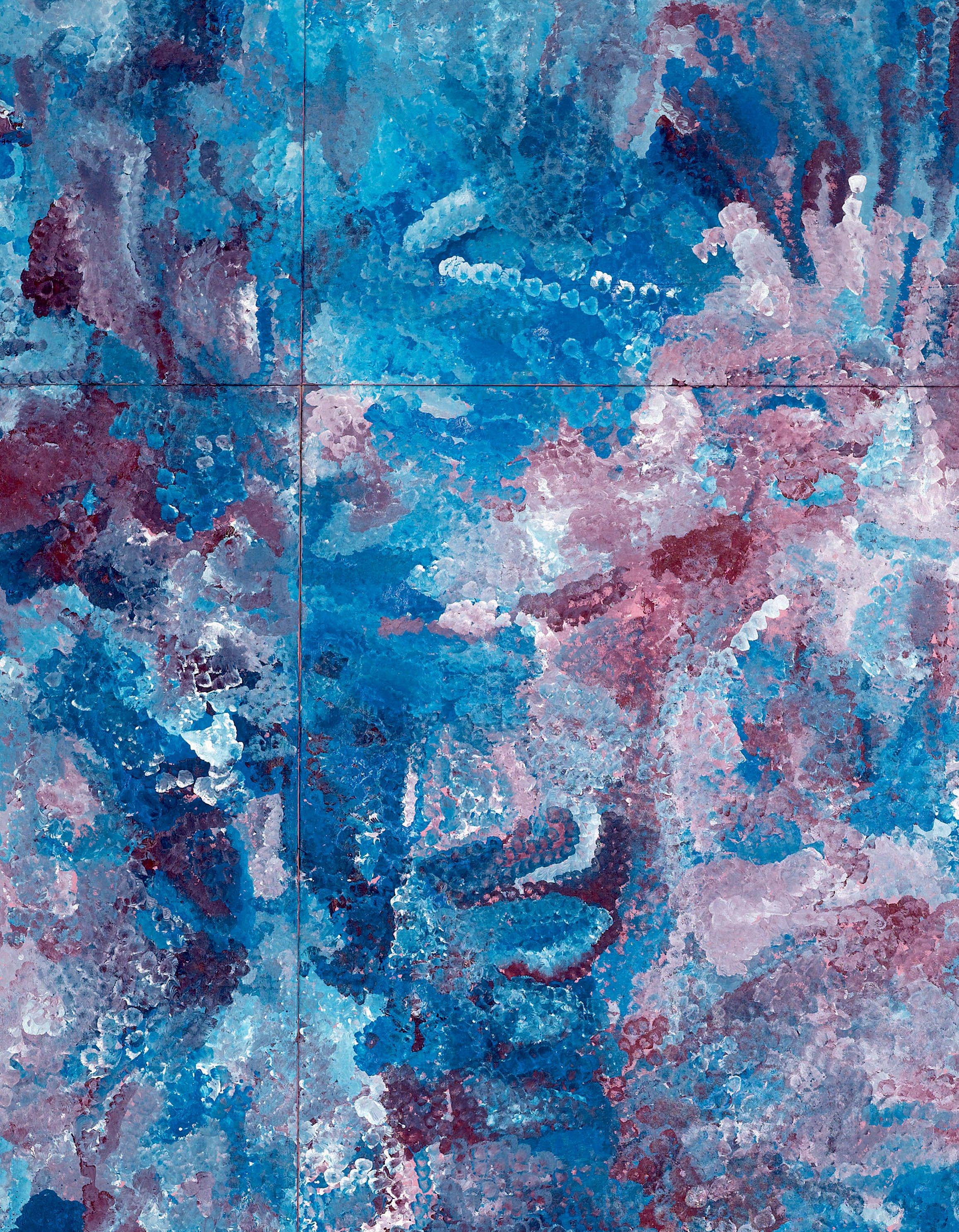COOE E ART auctions consultancy gallery

THE ROD MENZIES ESTATE | INDIGENOUS AND OCEANIC ART COLLECTION | PART 1
SYDNEY | 8 November 2023



THE ROD MENZIES ESTATE | INDIGENOUS AND OCEANIC ART COLLECTION | PART 1
SYDNEY | 8 November 2023

MENZIES ESTATE INDIGENOUS AND OCEANIC ART COLLECTION PART 1
Wednesday 8 November 2023

7 PM AEDT start
17 Thurlow Street Redfern NSW 2016
- OPENING GALA -
Thursday 2nd November 2023 | 6 - 8 pm
- AUCTION VIEWING3rd to 8th November 2023 | 10am - 6pm
- TELEPHONE / ABSENTEE BIDSemail bids to auction@cooeeart.com.au
+61 (0)2 9300 9533
bidding forms pages pp. 116 - 118
- LIVE ONLINE BIDDINGauction.cooeeart.com.au
- ENQUIRIESauction@cooeeart.com.au
+61 (0)2 9300 9533
Dr Anita Archer is an international art auctioneer and independent art consultant who has over two decades of experience working with collectors and artists in Australia and across Asia. Anita is also Postdoctoral Research Fellow in the Enlightenment, Romanticism and Contemporary Culture (ERCC) Research Unit at the University of Melbourne. An art historian, Anita’s research focus is global art markets and the digital art economy; her most recent publication is the monograph Chinese Contemporary Art in the Global Auction Market (Brill, 2022).
MIRRI Owner & DirectorMirri joined Cooee Art in 2007 and, in 2017 became part owner when she spearheaded the opening of Cooee Art’s Paddington gallery and the opening of the auction department and later, in 2021, created our vast galleries in Redfern. Under Leven’s guidance, Cooee has undergone a continuous evolution in each facet of the business. Now, with Mirri Leven as sole owner, the gallery is entering a new phase with many incredibly exciting projects on the horizon. Mirri holds a double degree in International Development and Fine Arts, as well as a Masters degree in Art Administration from the UNSW College of Fine Art. Leven is an executive board member of the Aboriginal Art Association of Australia.
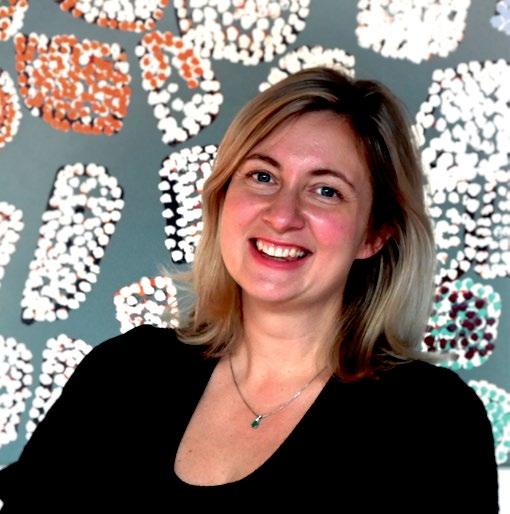


Dr Ksenia Radchenko completed a PhD in Cultural Studies from the University of Southern California, and a Master of Art Curating from the University of Sydney. With experiences working at the University of Sydney, Chau Chak Wing Museum, and Sydney Living Museums, Ksenia has also lived in Moscow and Los Angeles, deepening her understanding of the global art world. Ksenia brings a unique perspective to her work. As an Auction Administrator, she combines her creative and practical skills to excel in her role at Cooee Art.
Hayley completed her Bachelor of Fine Arts at Sydney’s National Art School. Since then, she has traveled and worked at NG Art Gallery, Sculpture by the Sea, and Liverpool Street Gallery. In September 2019 Hayley joined Cooee Art as the Paddington Gallery Assistant and is now the Gallery Manager in Redfern.
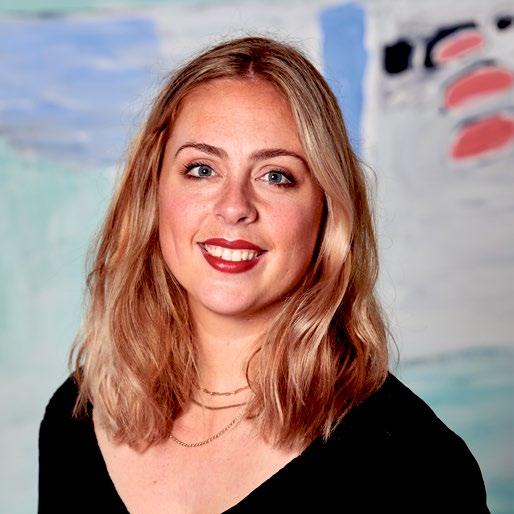
Indigenous Art Specialist
emma@cooeeart.com.au | +61 400 822 546
Educated in Fine Art at RMIT, Emma joined Cooee Art in 2016 as the Paddington Gallery Manager. In 2019, she became the Auction Specialist for Cooee Art Auctions. With a long history of employment in the arts, including positions at international institutions, commercial galleries, and private collections. Emma has an uncanny ability to match keen collectors with their ideal artworks. Her extensive knowledge of Australian Indigenous art positions her as ideal bridge between sellers and buyers.
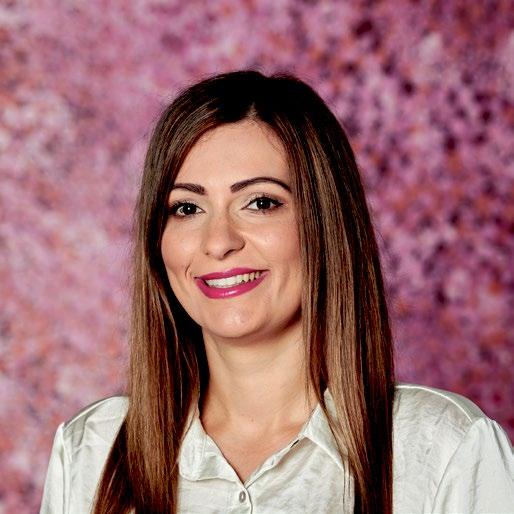
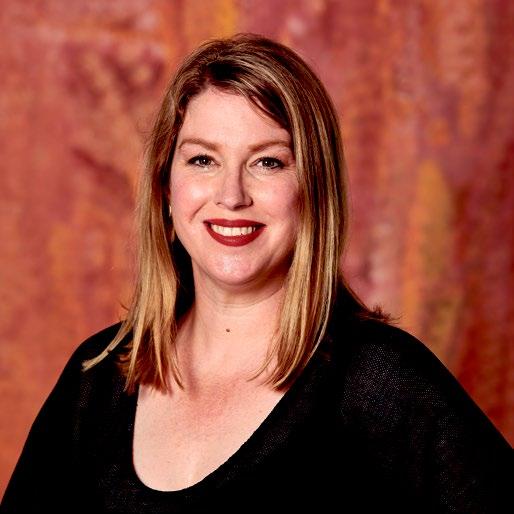
Fiona merges her education in Art and Finance to manage Cooee’s accounting department. She has a double Degree in Fine Arts and Education from UNSW and is an accomplished contemporary painter in her own right. Outside of Cooee she is a celebrated children’s book author and mother of twin girls. Fiona has a passion for Indigenous education and art and its place in remote First Nation’s communities.
adrian@cooeeart.com.au | +61 412 126 645
A former President of the Indigenous Art Trade Association and Director of Aboriginal Tourism Australia, Adrian established the Aboriginal art department for Lawson~Menzies in 2003, later acting as Managing Director of Menzies Art Brands, which under his stewardship, became the market leader. The former President of the Art Consulting Association of Australia, Adrian curated Cooee Art Auctions’ first specialised sale in 2017. For more than 40 years Adrian has been a passionate advocate for Australian Indigenous and contemporary art and has written widely for books, art publications and newspapers.
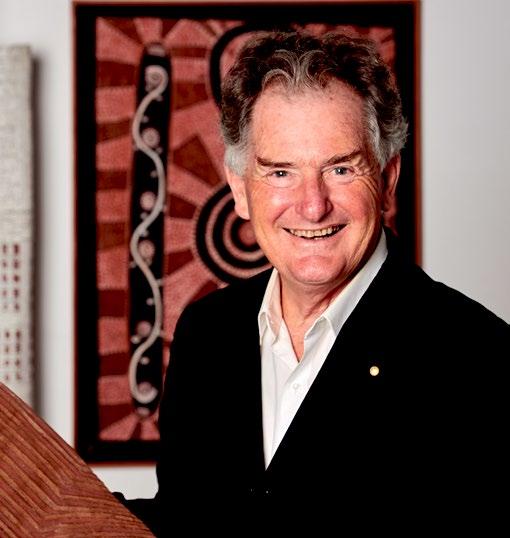
The son of an artist and art critic, Sam has worked in galleries across Berlin and Sydney, including his first job at the legendary Galerie Eigen + Art in Berlin from the age of 13. Prior to joining Cooee Art, he worked at the legendary Ray Hughes Gallery in Sydney, which he managed in its final years before opening his own, The New Standard Gallery, which ran from 2016 to 2018. Sam now acts as Cooee Art’s Art Handler.
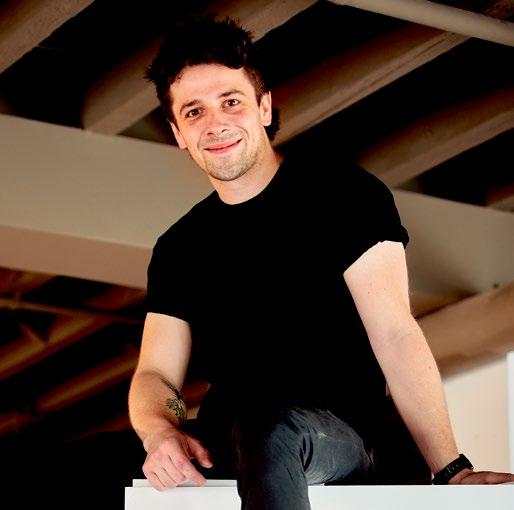
The formidable Rod Menzies, who died in April 2022 aged 76, was possibly the most driven and controversial art auctioneer Australia has ever known. A self-made business magnate, he opened his art auction house in 1998 and went on to reshape the Australian art auction landscape through a combination of panache, art-world savvy, and aggressive business tactics.

After partnering with Chris Deutscher in 1998, DeutscherMenzies outstripped Christie’s and had become Sotheby’s biggest rival in Australia within just 3 years. By 2004, D-M was the market leader, turning over $30.1 million compared to Sotheby’s $21.3 million and Christie’s $15 million. A year later, Menzies began a four-year collaboration with Aboriginal art specialist Adrian Newstead that saw them exceed Sotheby’s Aboriginal art sales for the first time in the Australian art market’s history. After a roller coaster ride during which their annual sales jumped from $1.8 million in 2004 to $9.1 million in 2007, Newstead and Menzies parted company, but remained firm friends.
Never afraid to back his own judgment, Rod Menzies took an assertive financial interest in the stock that he consigned. Ever the innovator, he created buyer syndicates and purchased works outright in his own name, thereby changing the dynamics of the entire fine art auction market. Menzies’ success did not come without controversy, though criticism was generally driven by an art-world version of the tall poppy syndrome.
Between 1999 and 2008, he amassed an impressive collection of Australian Indigenous artworks. They were on permanent display in a purpose-built gallery at his Italianate Mansion, Noorilim, located between Seymour and Shepparton in Central Victoria. In 2007, Newstead curated the touring exhibition, Masterworks from the Menzies Collection, which toured regional galleries throughout Australia and over the following years, several syndicate works were offered for sale through his own auctions so that they could be bought back by Rod Menzies in his own right at a transparent fair market value.
In its entirety, the Rod Menzies Aboriginal art collection comprises 214 works (plus an assortment of artifacts) with a combined market value of $3 - 5 million. Amongst them, many hold the artist’s current market records.
These works will be offered for sale in November 2023 and March 2024 as part of the ongoing rationalisation of the considerable Rod Menzies estate holdings which include hundreds of important Australian and International paintings, real estate, and a large range of additional assets.
Alice Nampitjimpa
Anne Hogan
Artist Once Known
Ben Sisia
Boxer Milner
Brook Andrew
Clifford Possum Tjapaltjarri Collaborative
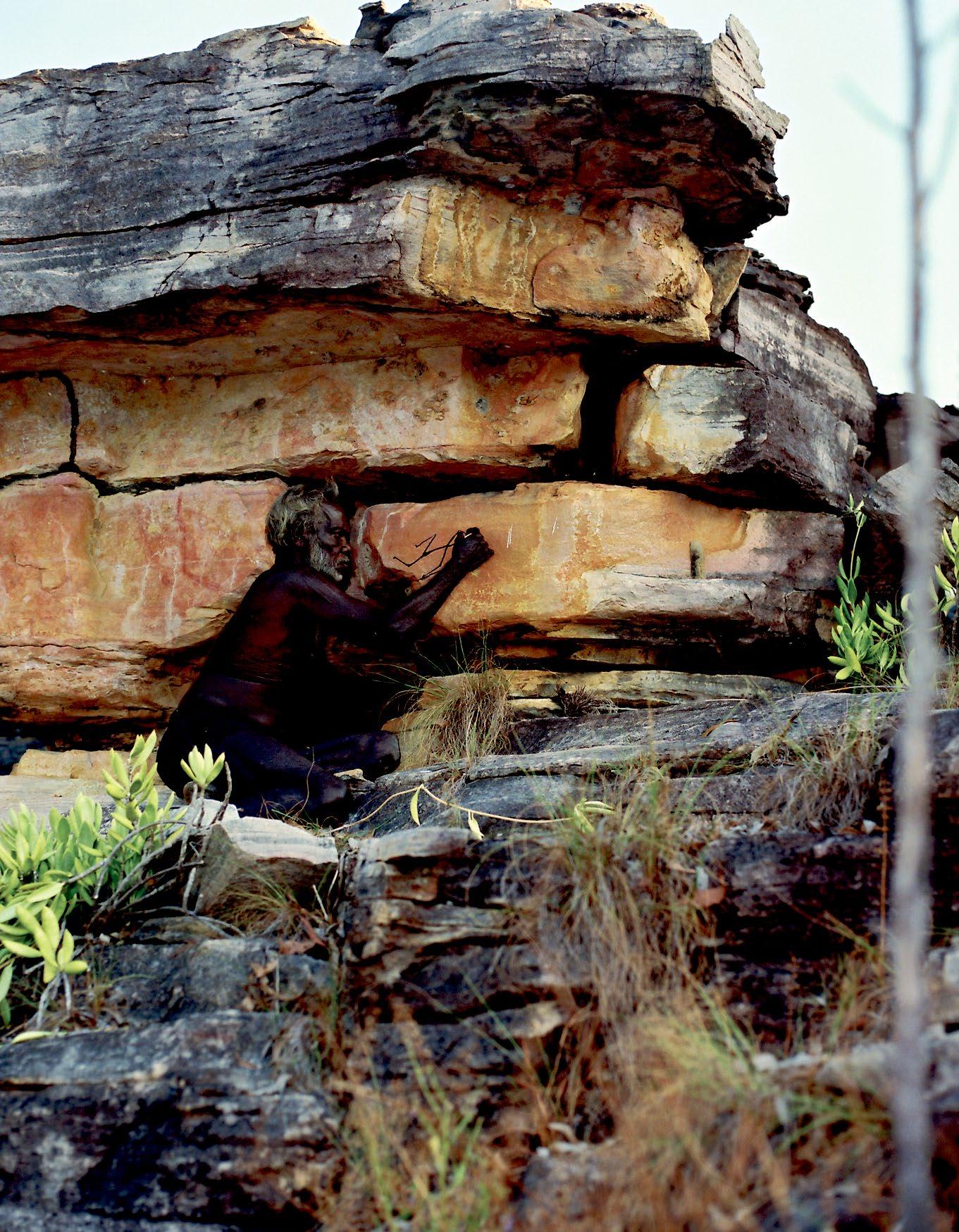
Dennis Nona
Dorothy Napangardi
Dr George Tjapaltjarri
Edward Sali
Edward Sali
Eileen Yaritja Stevens
Emily Kame Kngwarreye
Emily Pwerle
Estelle Inyika Hogan
Freda Warlimpini Freddie

1
Painted Toolbox, 1982 18 x 47 x 26 cm synthetic polymer paint on board EST $2,500 - 3,500
Gift from the artist to a teacher at Ngaku, near Burnt Bridge Aboriginal Mission, Kempsey in the early to mid 1980s Private Collection, NSW Lawson~Menzies, Sydney, NSW, November 2007, Lot No. 257 Menzies Estate Collection, Vic

Primarily self-taught, Robert Campbell Jnr. emerged during the 1980s as a prominent Indigenous artist living in Kempsey NSW.
After visiting the Northern Territory in the late 1980s and meeting Indigenous artists in their communities, he grafted their methods seamlessly into his bold, idiosyncratic style. From nostalgic childhood scenes of camp life and bush food gathering, to brutal scenes of white conquest, murder and the poisoning of waterholes, Campbell managed to convey a sense of unflinching observation of the past whilst avoiding the heavy weight of political stridence.
Before his untimely death from heart disease in 1993, Campbell’s vivid colours and raw vision featured in many exhibitions, including at the Rebecca Hossack gallery in London. He helped to assert the voice of Indigenous people living within the urban landscape, and continue to provide a unique indigenous perspective on the history of displacement and dispossession to this day.
2
WALANGKURA NAPANANGKA (c.1946 - 2014)
WOMENS SITE NEAR TJUKULA, 2003 123 x 92.5 cm synthetic polymer paint on Belgian linen
EST $3,500 - 5,500
Papunya Tula Artists, NT Cat No. WN0302028
Gallery Gabrielle Pizzi, Vic Private Collection, Vic Lawson~Menzies, Sydney, NSW, May 2006, Lot No.16
Menzies Estate Collection, Vic
Accompanied by the original certificate of authenticity from Papunya Tula
Walangkura Napanangka has an enviable artistic pedigree. Her father, Tutuma Tjapangati, was one of the original Papunya artists and her mother, Injuwa Nampitjinpa, belonged to the important first wave of women desert artists. Her sister, Pirrmangka Napanangka (now deceased), was a rising star until her untimely early death, and all four artists were included in the groundbreaking exhibition Papunya Tula: Genesis and Genius at the Art Gallery of New South Wales in 2000.
In this work, the artist has depicted sandhills and sites associated with Women’s Dreamings in the region of Kintore and Kiwirrkurra.
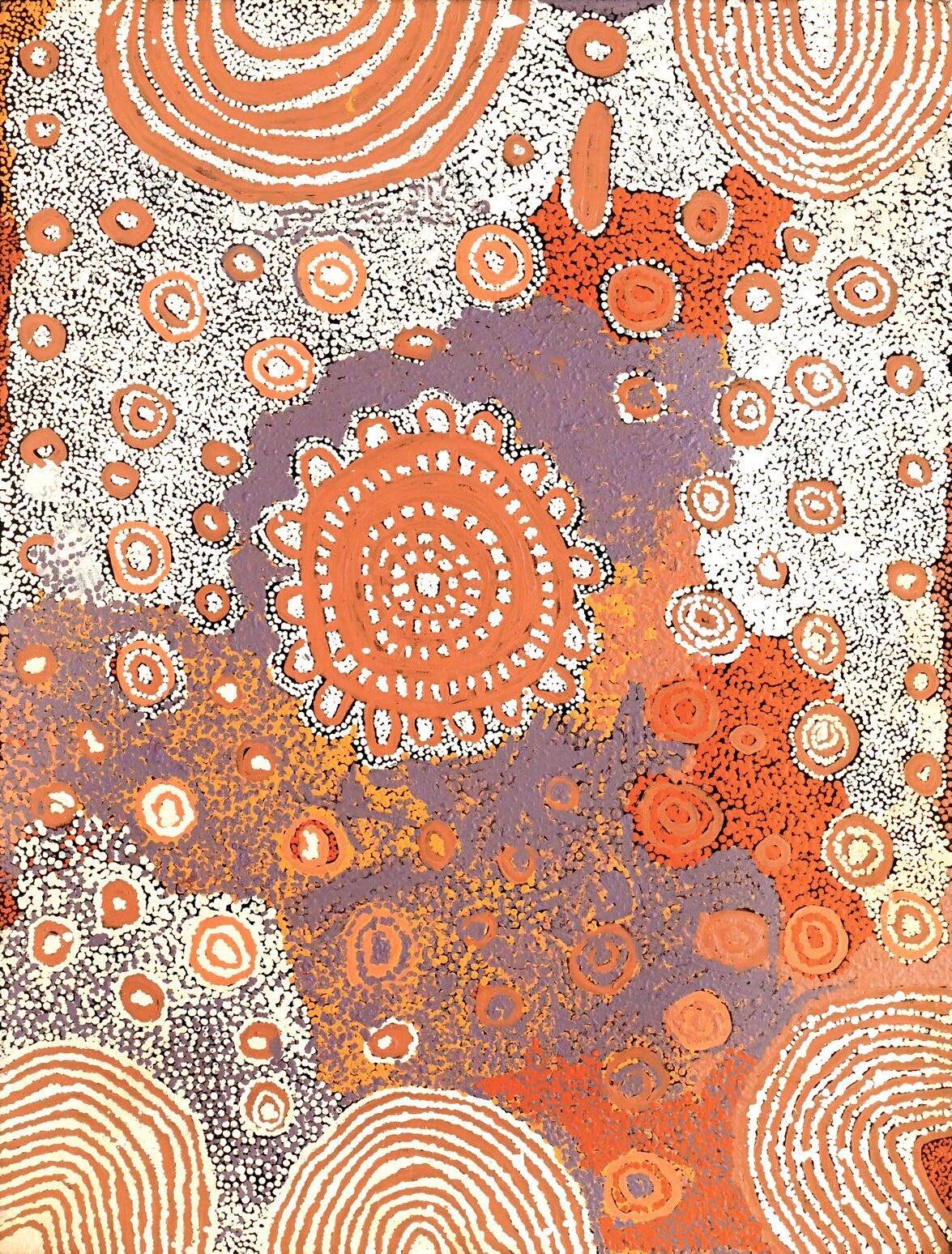
(1935 - 2013)
ROCKHOLE SITE OF YUMARRA 2000
137 x 122 cm synthetic polymer paint on Belgian linen

EST $3,500 - 5,500
PROVENANCE
Papunya Tula, NT Cat. No.NN20000272 Private Collection, NSW Lawson~Menzies, Sydney, NSW, November 2005, Lot No. 144 Menzies Estate Collection, Vic
Nyurapayia Nampitjinpa was born near the site of today’s Docker River community. She saw no white men until she was in her teens and spent much of her childhood at Pangkupirri, a set of sheltered rockholes deep in the range-folds of the Gibson Desert. By the time she walked in from the bush to the ration depot at Haasts Bluff and encountered mission life she was a healer and was soon recognised as a person of great ritual authority. She moved to Kintore, the new western settlement of the Pintupi, closer to her traditional lands, and then on to Tjukurla, across the West Australian border in the 1980s.
Nyurapayia was a close associate of the key painters who shaped the women’s painting movement in the early to mid-1990s. Her depictions of the sand-dune country and surrounding rocky outcrops bear a relationship to the designs used for body painting during the Inma ceremonial dance. At the time of her death in February 2013, Nyurapayia had reached the pinnacle of desert law and sacred knowledge and was revered by women throughout the Western desert.
4
BOXER MILNER (c.1934 - 2008)
UNTITLED, 2004 100 x 50 cm synthetic polymer paint on canvas
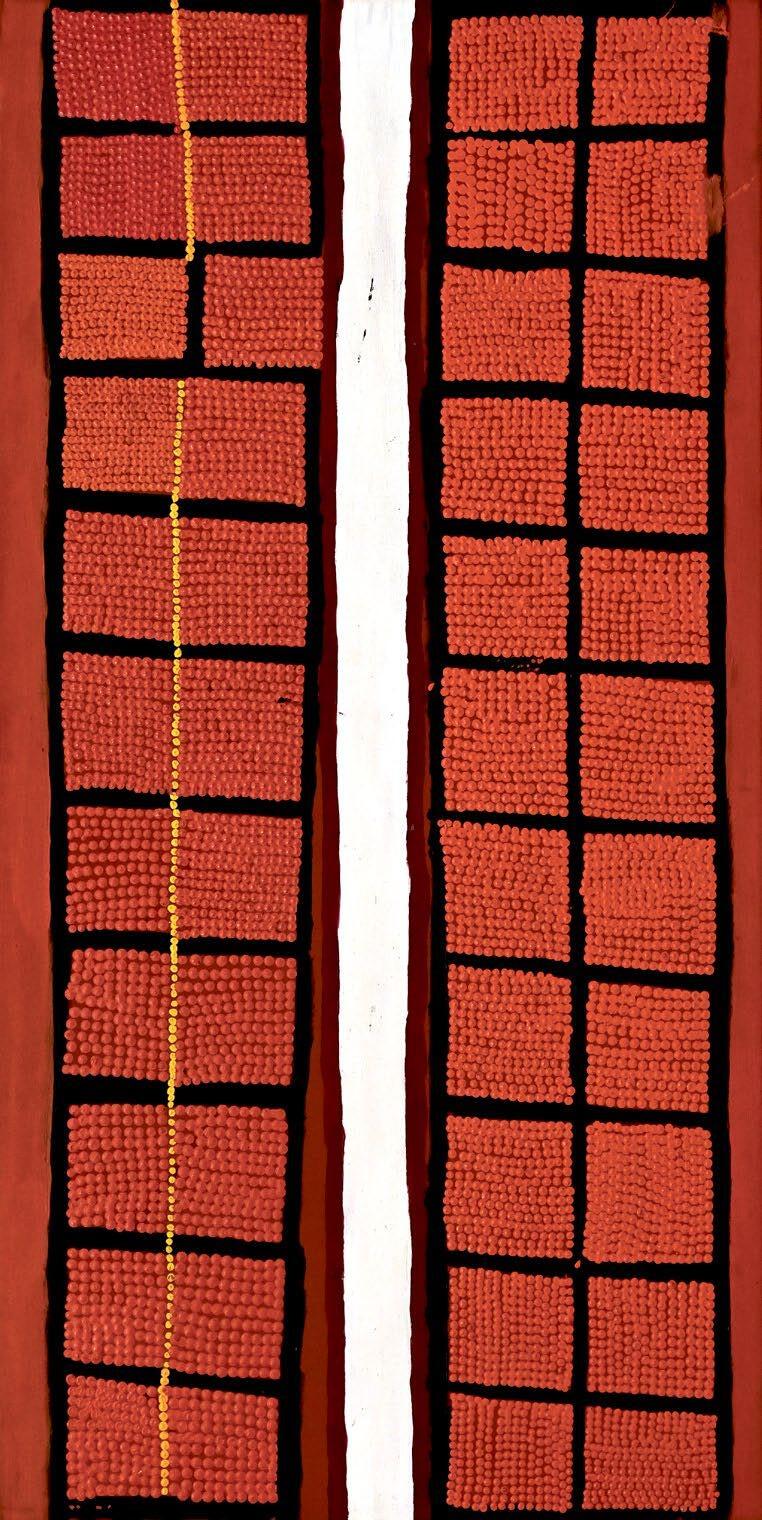
EST $2,000 - 3,000
Warlayirti Artists, NT Cat No. 77/04
Kimberley Art, Vic Cat No. KA00561
Menzies, Australian & International Fine Art, Sydney, NSW, March 2010, Lot No. 151
Menzies Estate Collection, Vic
Accompanied by a certificate of authenticity from Kimberly Australian Aboriginal Art
Boxer Milner, a tall gentle old cattleman, began painting in the late 1980s. Born south-west of Billiluna near Sturt Creek, Boxer was one of a small number who came from the transition zone between the desert and the river country in Tjaru land. Here the country and vegetation move from flat and featureless rolling Spinifex plains to flood plains with enormous river channels and permanent water holes.
Boxer’s paintings differ from those with a conventional Balgo aesthetic. They explore the yearly cycles of flood and dry which create the swamps with abundant bird life, through which Purkitji (Sturt Creek) runs.
In this work, the central vertical line represents Purkitji while the remaining strong lines show its tributaries that run through black soil country.
NYURAPAIYA(MRSBENNETT)NAMPITJINPA
(1925 - 2013)
WOMEN TRAVELLING, 2000
136 x 120 cm synthetic polymer paint on Belgian linen
EST $3,500 - 4,500
PROVENANCE
Papunya Tula Artists, NT Cat No. NN20000607 Fireworks Gallery, Qld Cat No. FW4107 Private Collection, Qld Menzies Estate Collection, Vic
Nyruapayia Nampitjinpa‘s depictions of the sand-dune country and surrounding rocky outcrops connected to her mother’s Dreaming sites at Yumarra, and related rockholes, bear a relationship to the designs used for body painting during the inma ceremonial dance. Her designs often depict women’s ceremonies and rituals associated with gathering of bush tucker such as kampurarrpa (desert raisin) and quandong.
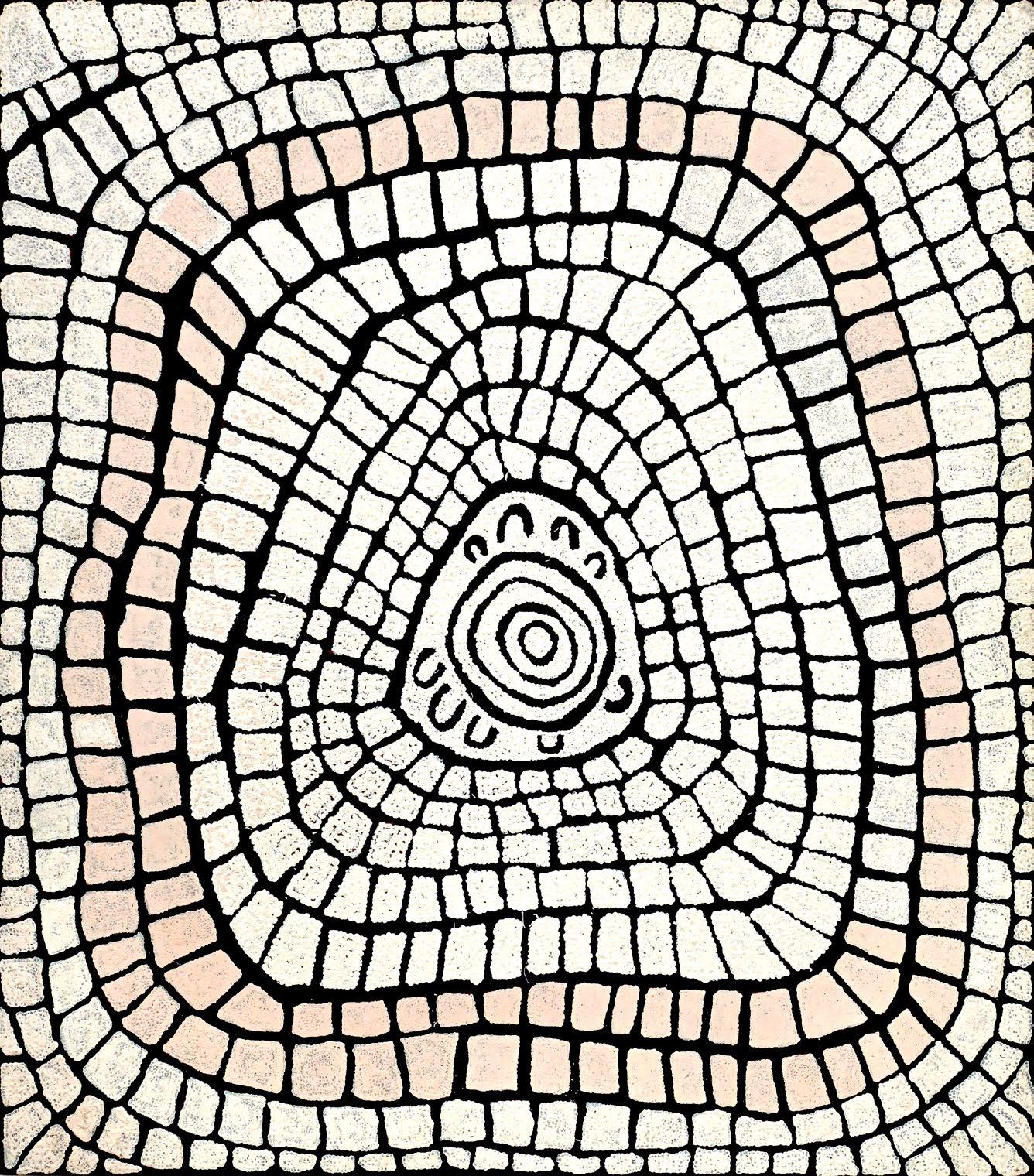
6
KATHLEEN NGAL (1930 - )
BUSH PLUM COUNTRY, 2002 120 x 100 cm synthetic polymer paint on canvas
EST $1,500 - 2,500
Simon Turner International, NSW Cat No. ST17702 Private Collection, NSW Lawson~Menzies, Sydney, NSW, May 2006, Lot No. 30 Menzies Estate Collection, Vic
Kathleen’s works can be interpreted as sophisticated mind maps, depicting cultural knowledge of her country as well as its physical geography.Thousands of dots of colour are rained across her brilliant canvases, denoting the varied flora and geographical locations of the Bush Plum.
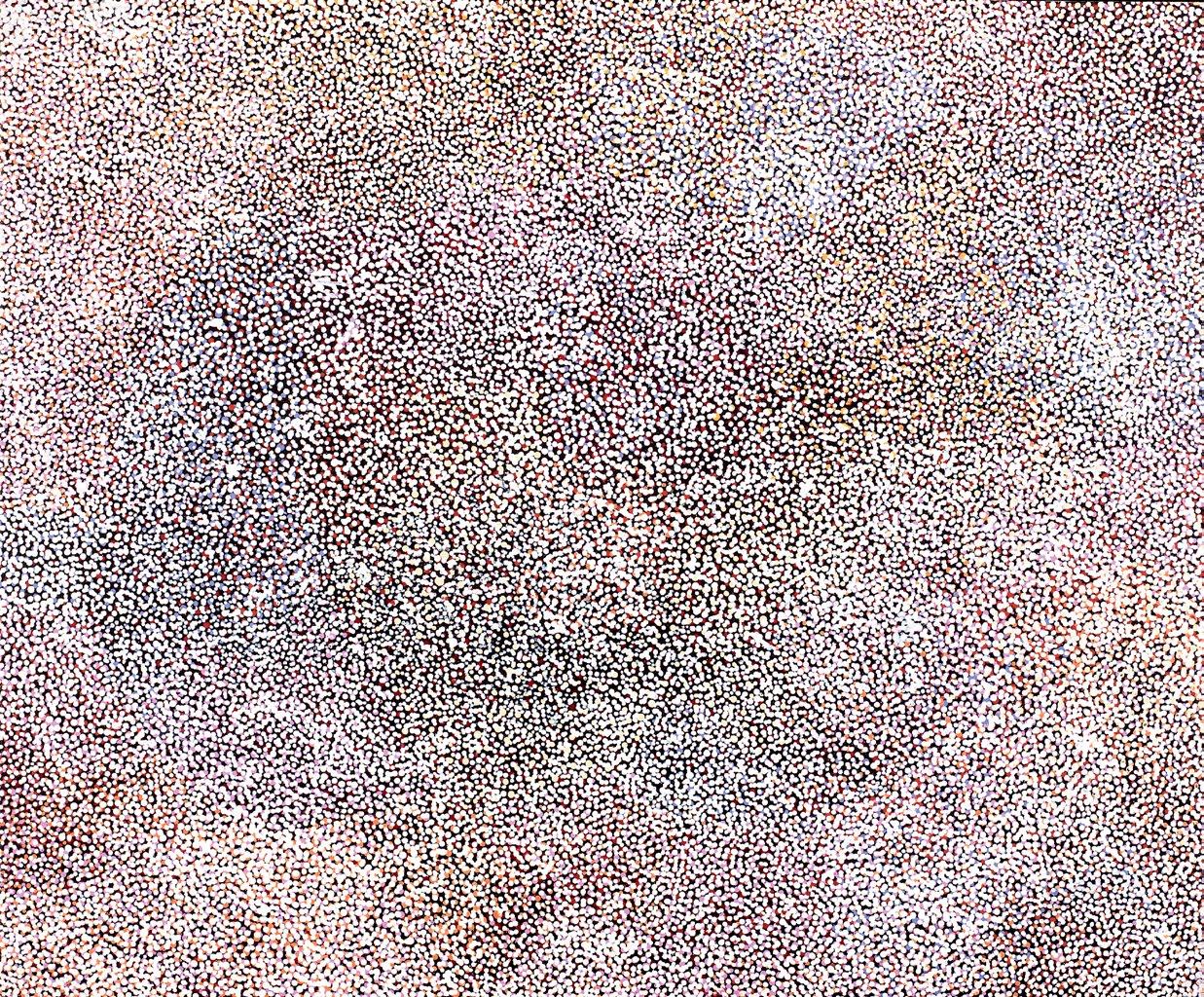
The site depicted is Arlperre on Utopia Station. This is country that belongs to the Ngal and Kemarr custodians, who paint the Bush Plum or Conkleberry. It only thrives once every seven years, after huge storms.
Best known for the way she depicts the white flowers of the Bush Plum over a shimmering background of colour, Kathleen often employs a variety of blues, purples and reds in her under-painting. In this work we see the plant’s final flourish, as white dots overlay the canvas representing the sun-dried leaves, seeds, husks, and grasses of Arlperre.
7
MINNIE PWERLE (1910 - 2006)
AWELYE, 2005 122 x 238 cm synthetic polymer paint on Belgian linen
EST $10,000 - 15,000
PROVENANCE
Warmun Art Centre, WA Cat No. WAC 092/05 Private Collection, NSW Lawson~Menzies, Sydney, NSW, November 2007, Lot No.121 Menzies Estate Collection, Vic
Accompanied by certificate of authenticity from Flinders Lane Gallery
Minnie Pwerle was born at Atnwengerr in the Utopia region around 1910. She began painting in 1999 and had her first solo exhibition in 2000.Within three years, her bold and free-flowing paintings had captured wide attention, and she was listed as one of Australia’s Top 50 Most Collectable Artists in the Australian Art Collector magazine.
Her major subjects were the Bush Melon and its seed, and the ceremonies (Awelye) that were enacted to increase their abundance.
In this work, the bold linear striations, curves, and circles represent the melon, its seed, and the ceremonial body paint. The painting evokes the story of this lovely sweet food that comes from a very small bush and is only found in Atnwengerrp. Once very abundant and fruiting in the summer season, the Bush Melon is now very hard to find
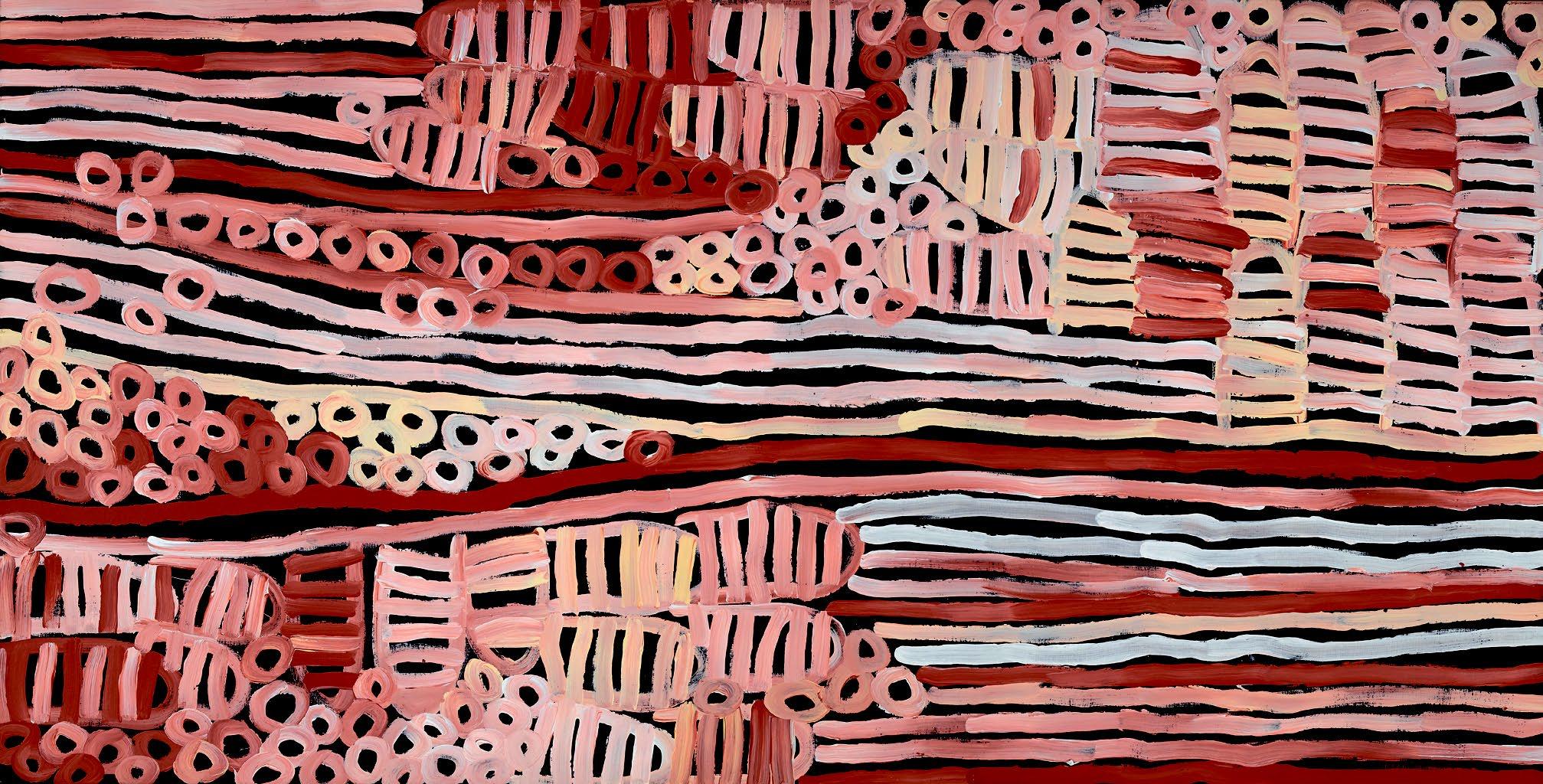
8
(1910 - 1996)
KAME - YAM DREAMING SITE AT ALHALKERE, 1995
127 x 125 cm synthetic polymer paint on Belgian linen
EST $35,000 - 40,000
Dacou Gallery, SA Private Collection, SA Lawson~Menzies, Sydney, NSW, May 2007, Lot No. 18 Menzies Estate Collection, Vic
Cf. For other works produced during this period at Delmore Downs see: Emily Kngwarreye Paintings, Craftsman House, 1998, plates 64-77, pp 159179
Beginning late in 1991 and throughout the following years, Emily explored a range of techniques after largely abandoning the fine dotting and submerged linear tracking which had characterised her earlier works. She used larger brushes to create broader circular dabs of paint, which often involved ‘double dipping’ the brush in various colours, before attacking the canvas. In this work, she shows tremendous confidence and great subtlety of colour in rendering the floral profusion throughout her desert homeland after summer rains. The linear application of broad dotting creates swathing rhythm across the canvas. Despite the sweeping gestural flourishes, the resultant image contains considerable nuances, which evoke the physical and spiritual fertility of the land, and radiance of being, that is sought during ceremony.
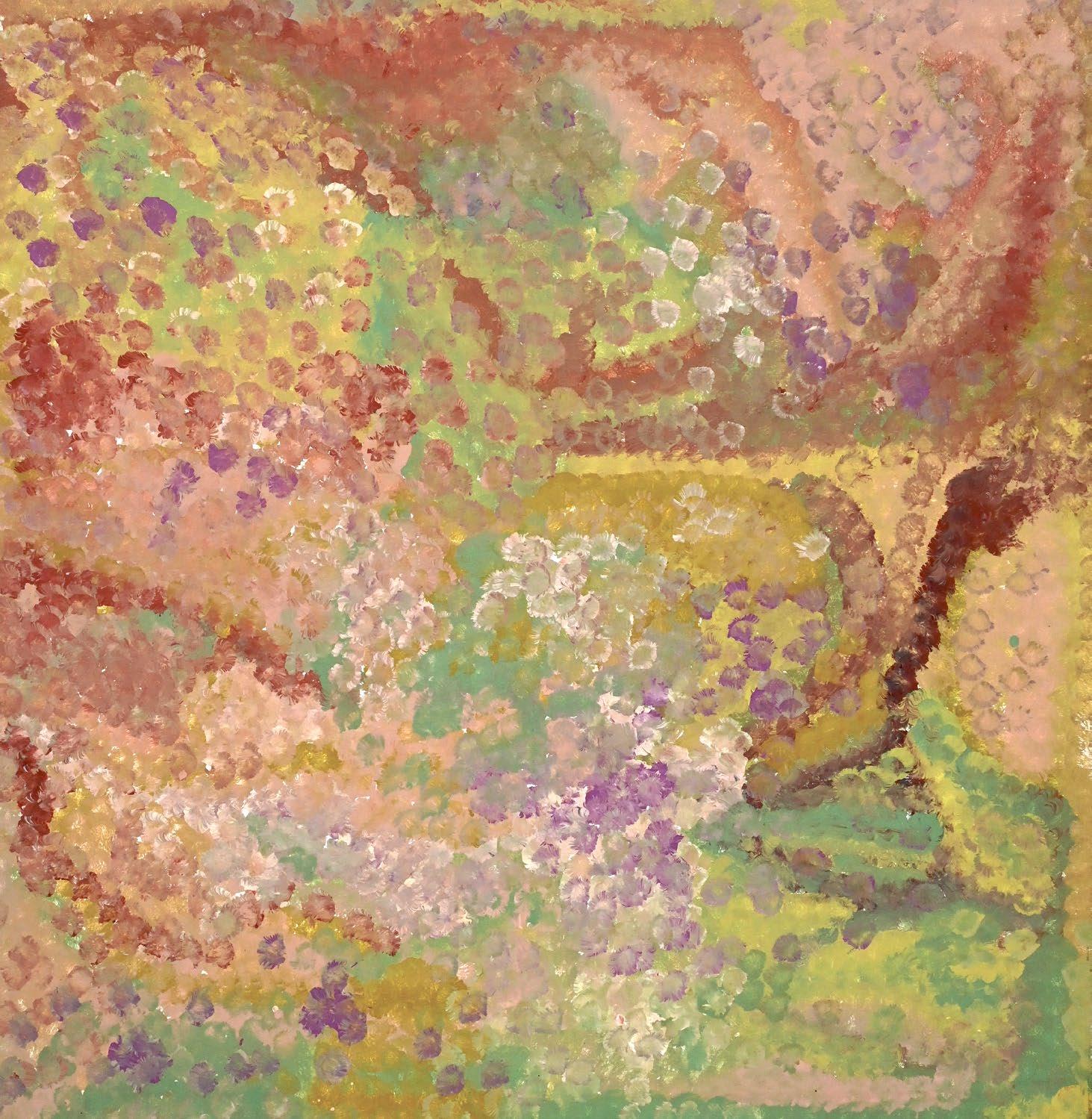
9
EMILY PWERLE (c.1922
AWELYE ATNWENGERRP , 2008 183.5 x 122 cm synthetic polymer paint on Belgian linen

EST $4,000 - 6,000
PROVENANCE
Dacou Aboriginal Gallery, SA Cat No. DG08672
Private collection, NSW
Menzies, Australian & International Fine Art, Sydney, NSW, March 2010, Lot No. 96
Menzies Estate Collection, Vic
Accompanied by a certificate of authenticity from Dacou Gallery
Emily Pwerle began painting during a workshop held at Ultja station in 2004. Pwerle’s extended family are all artists, including her sister, the late Minnie Pwerle, who encouraged other sisters to paint.
Atnwengerrp is Emily Pwerle’s Country. This bold linear pattern of intertwined stripes and curves represents the Women’s Ceremony body paint design for Atnwengerrp and evokes its shimmer as women dance by firelight. After smearing their bodies with animal fat, the women trace these designs onto their breasts, arms and thighs, singing as each woman takes her turn being ‘painted up’.
The songs relate to the Dreamtime stories of Ancestral Travel and other plants, animals, and natural forces. Awelye - Women’s Ceremonydemonstrates respect for the land. In performing these ceremonies, the women ensure well-being and happiness within the communities.
- 2006)
TINGARI CYCLE, 2002
61 x 92 cm synthetic polymer paint on Belgian linen
EST $1,400 - 1,800
Ngintaka Aboriginal Art Exports, SA Cat No. 1761 Flinders Lane Gallery, Vic Cat No. FG022045PL Lawson~Menzies, Australian Aboriginal Art, Sydney, NSW, November 2007, Lot No. 251
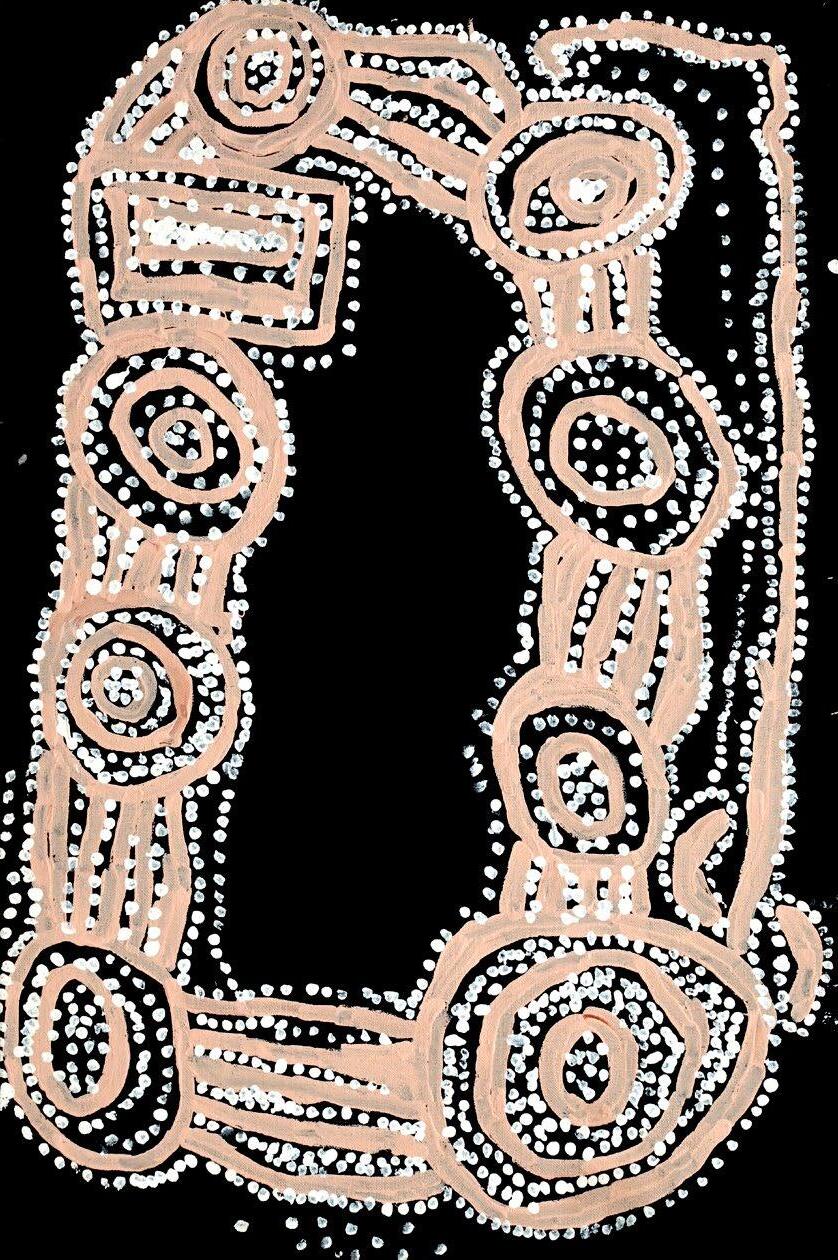
Menzies Estate Collection, Vic
A Senior Pintupi painter, Peg Leg Tjampitjinpa was born around 1920, and lived in the vicinity of Wilkinkarra until his family moved to Yuendumu in 1964. He painted alongside Pinta Pinta until his death, and due to failing eyesight stopped painting altogether until the last year or two of his own life.
His raw eccentric style was reminiscent of that of many Pintupi works of the early 1970s, though unmistakably his own. Using the rough outlines of traditional designs, usually with unmixed ochres on dark backgrounds, Peg leg exclusively depicted the traditional Tingari Men’s Dreaming cycle.
This painting shows various sites that the Tingari ancestors shaped as they travelled across the vast stretches of country, performing rituals.
These creation stories form part of the teachings of post-initiatory youths at the same time providing the basis for contemporary customs.
11
PROVENANCE
Warmun Art Centre, WA, Cat No. WAC 092/05 Private Collection, NSW Lawson~Menzies, Sydney, NSW, November 2007, Lot No.121 Menzies Estate Collection, Vic
This is Lena’s father’s country which lies north of Warmun, towards Doon Doon Station. People used to wrap their feet in paperbark or calico here when hunting kangaroos in the hills to stop the sharp stones from which they made spearheads (Jimbala) from cutting their feet.
There are many different coloured stones in this country, which people used to break with a strong stick, to make the spearheads sharp. In this work Lena has painted them with the ochre she collected from that place. It gives the spearheads an opaque appearance.
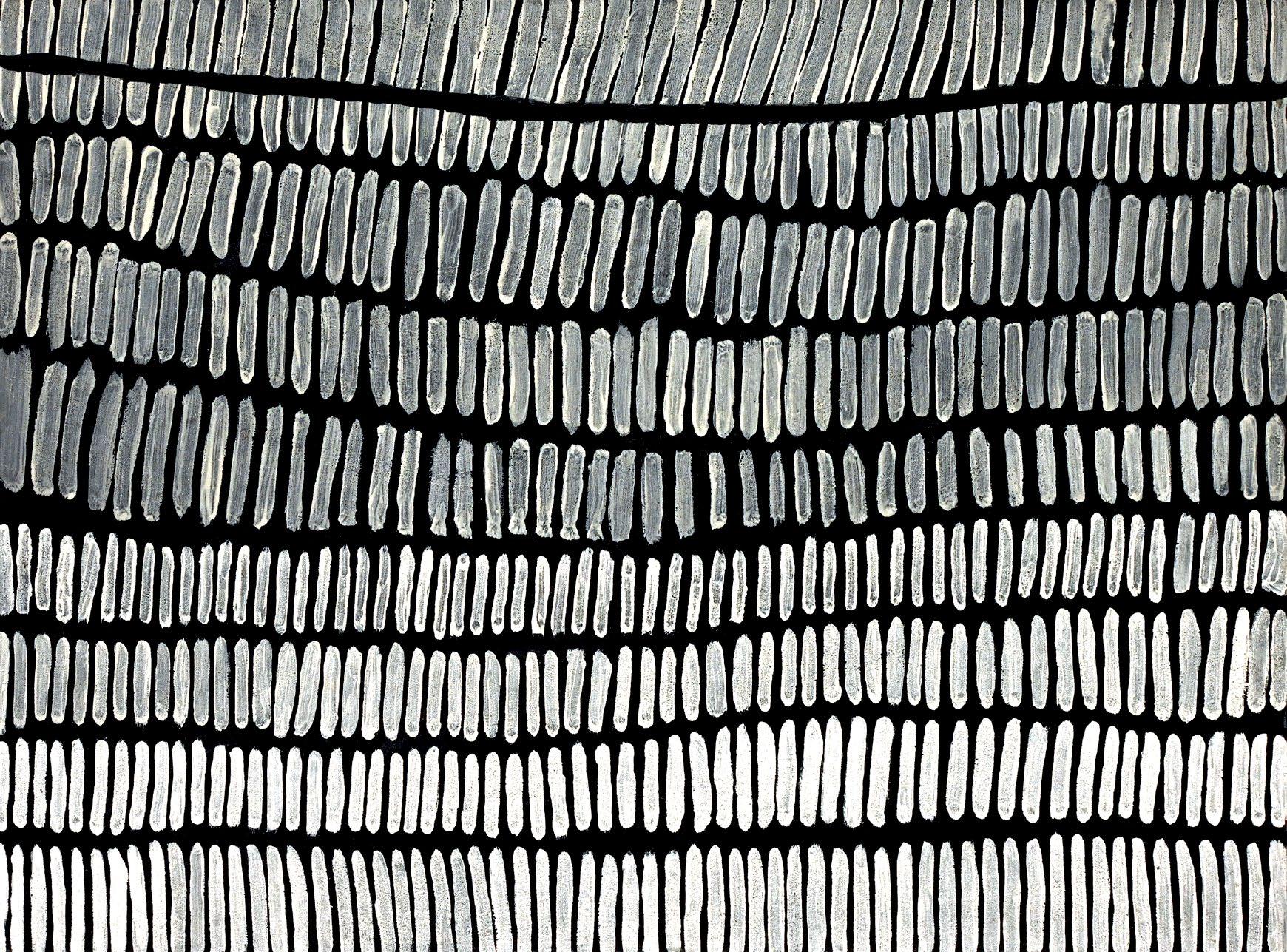
GLORIA PETYARRE (1942 - 2021)
MOUNTAIN DEVIL AWELYE, 1992 diameter: 100 cm synthetic polymer paint on Belgian linen
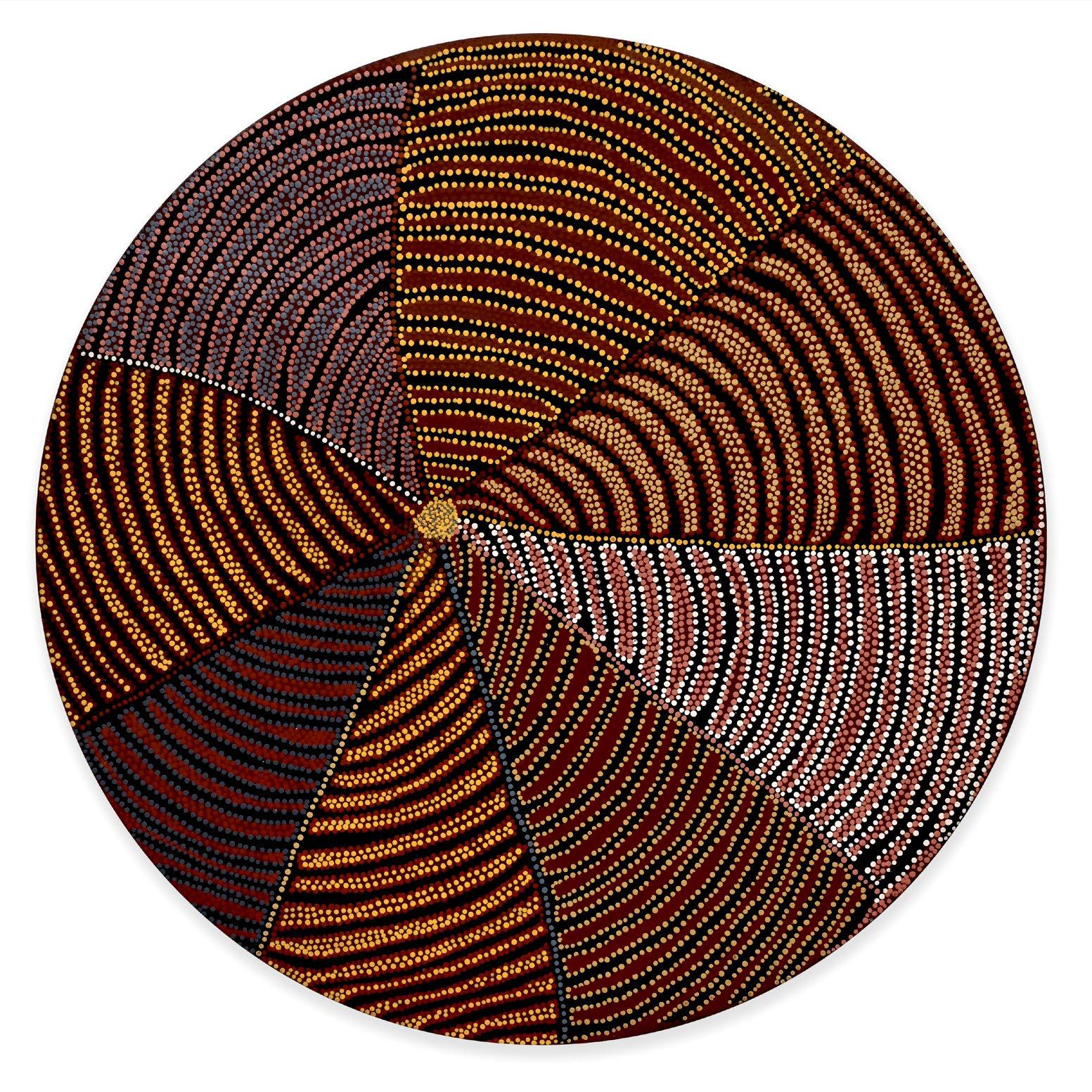
EST $2,500 - 3,500
Delmore Gallery, NT Cat No. 92B12
Cooee Art, NSW Cat No. 121
Lawson~Menzies Australian Aboriginal Art, Sydney, NSW, November 2007, Lot No. 69
Menzies Estate Collection, Vic
Accompanied by a certificate of authenticity from Delmore Gallery
Gloria Petyarre had custodial responsibility for the Mountain Devil Lizard(Arnkerrthe) referred to by Eastern Anmatjerre people as that ‘Old Woman’ who, in the Dreamtime, lived at the soakage site called Aneltyeye. Adjacent to this soakage was a small deposit of the red ochre used to paint bodies during ceremonies (Awelye).
As a means of protecting it from negligent and overzealous use, that Old Woman walked out in a northerly direction from her soak and collected hairstring belts which she ‘planted’ on Elkedra Station and at Three Ways, south of Tenant Creek. Both of these places transformed and became red ochre pits that supplied other groups.
Whenever Gloria returned to this country she carried some meat, lit a fire and cooked it. This ritual ensured that the red ochre would be looked after - possibly replenished. This Dreamtime story is passed on from parents to their children to keep the Dreaming strong.
LONKA LONKA PEARL SHELL PENDANT WITH HAIRSTRING BELT, c.1960
15 x 13 x 2 cm Shell; 60 x 10 cm Hairstring natural earth pigments carved shell and hair
EST $600 - 900
PROVENANCE
Hogarth Galleries, NSW
Lawson~Menzies, Aboriginal Art, Sydney, NSW, May, 2005, Lot No. 5 Menzies Estate Collection, Vic
Aboriginal Pearl shell ornaments have different names depending on the tribal group. They are Riji or Jakoli in the Kimberley (Western Australia). In the Central Desert, they are Lonka Lonka.
This fine example is thought to have been made during the 1960s. It has an incised interlocking key motif and traces of ochre infill, pierced at the top for suspension, and is attached to a belt of human hair. These shells are what the young men wear on the third and final stage of their initiation, following which they are allowed to be with their promised wives.The whole initiation process from boyhood to manhood takes about 8–10 years and involves many stages. Though not in themselves secret or sacred, the meanings and the use of these objects can be.
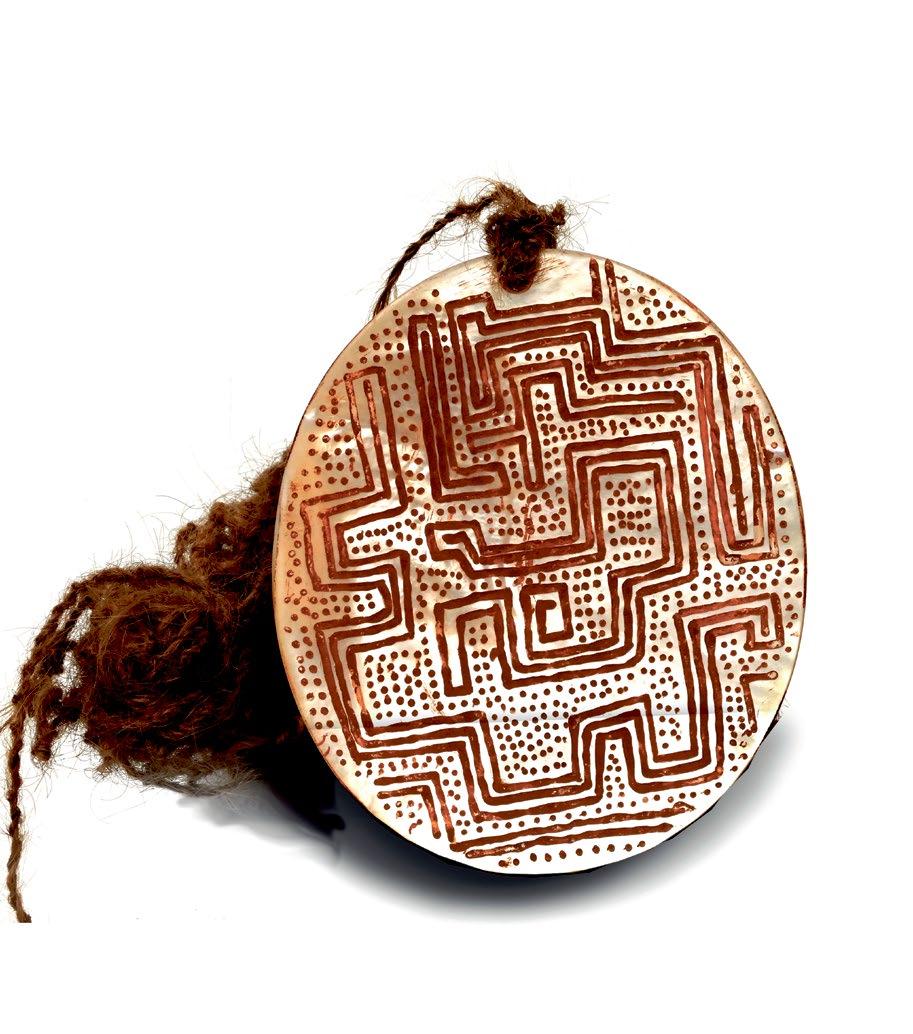
ENGRAVED PEARL SHELL, c.1960
15 x 16 x 3 cm natural earth pigments carved shell
EST $500 - 600
PROVENANCE
Private Collection, NSW
Lawson~Menzies, Aboriginal Art, Sydney, NSW, May, 2005, Lot No. 5 Menzies Estate Collection, Vic
This Aboriginal Pearl shell ornament is thought to have been made during the 1960s for exchange or barter. It is finely incised with a delicate figurative depiction of a man hunting, with traces of red ochre.
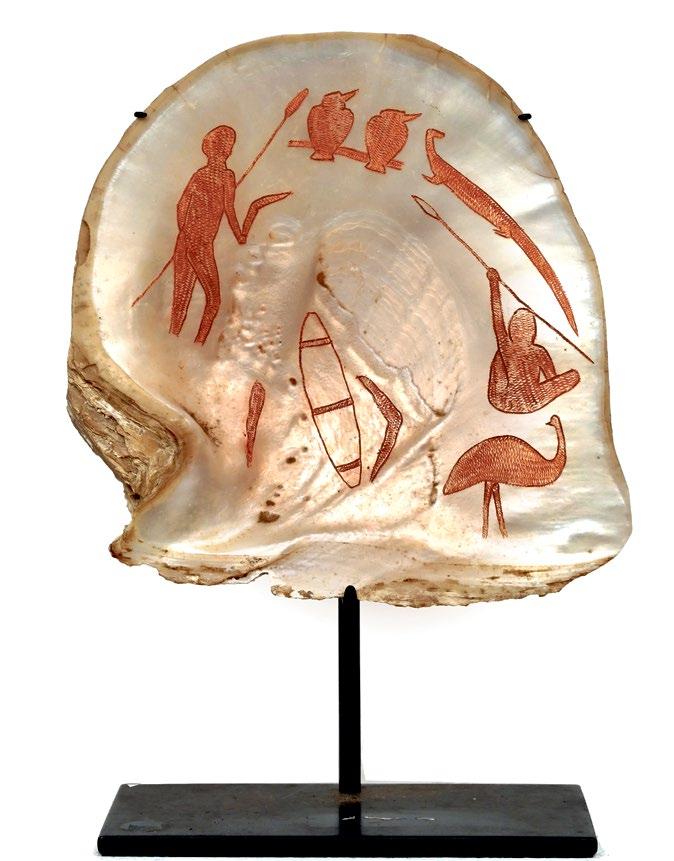
59
WANDJINA, 1993
EST $800 - 1,200
Niagara Galleries, Vic Cat No. 08093LK Private Collection, Vic Lawson~Menzies, Sydney, NSW, May 2007, Lot No. 206 Menzies Estate Collection, Vic
It is said that the Wandjina is the embodiment of the rain spirit and creation ancestor of the Wonnambal, Ngarinyin and Worrora peoples of the North West Kimberley. Wandjina are prolific along the walls of caves in the plateau areas of the North Kimberley coast and are unique to this region. They are always pictured using red ochre from a frontal aspect, with no mouth, large black eyes, and a slit or beak-like nose and are usually depicted in a veil of dots which represent the blood and water mix of man and animal. According to the Dreamtime mythology, the Wandjina emerge from the clouds to bring the monsoon rain each season. As such, it is a powerful fertility figure that keeps the spirits of unborn babies in special rockpools and waterholes.
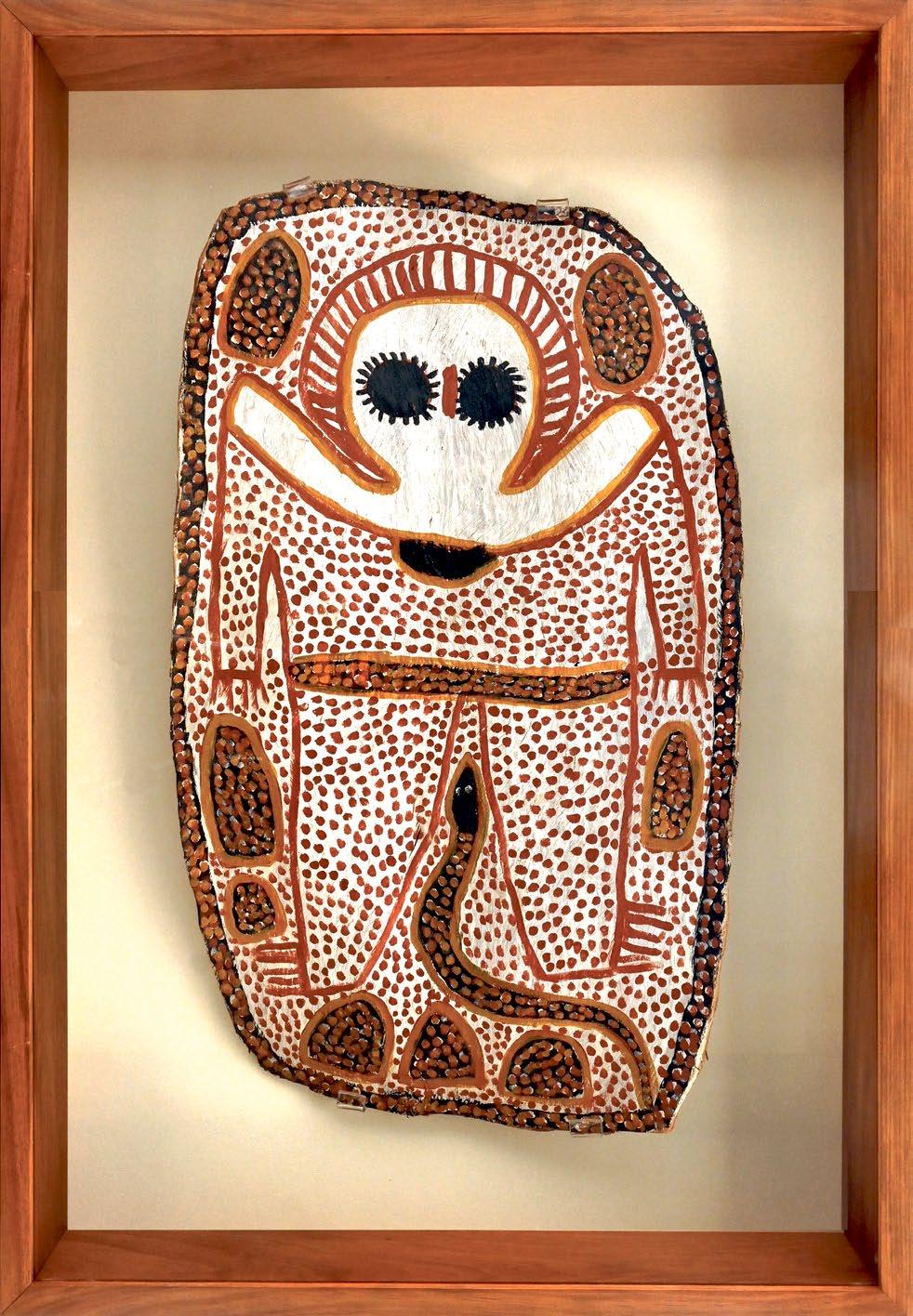
Private Collection, Vic
Lawson~Menzies, Sydney, NSW, May 2007, Lot No. 84 Menzies Estate Collection, Vic
Cf. For an extensive discussion of the history, construction methods and use of Queensland rainforest baskets see Ewington, J., Working The River: Baskets Of The Rainforest and Henry, D. with T. Johnson, Jawun: An interview with Desley Henry, in Queensland Art Gallery’s catalogue of the exhibition, Story Place: Indigenous Art of Cape York and the Rainforest, 2003, pp.158169.
This two-cornered basket made from lawyer cane has a circular mouth with a body that opens out with curved lines ending in sharply pointed corners. These baskets are rare and were made by the people in the rainforest area from around Cooktown in the north, to the Cardwell area in the south on the eastern coast of Cape York. Their form combines strength with flexibility.
Historically, they were made by men and used by women. Referred to in the local language as Jawun, they had a variety of purposes: they were used as carrying baskets with the handle looped around the forehead; as fish traps in rivers where the horns of the baskets allowed them to be wedged between sticks or rocks; and as sieves to leach out toxic substances from a variety of bush foods.
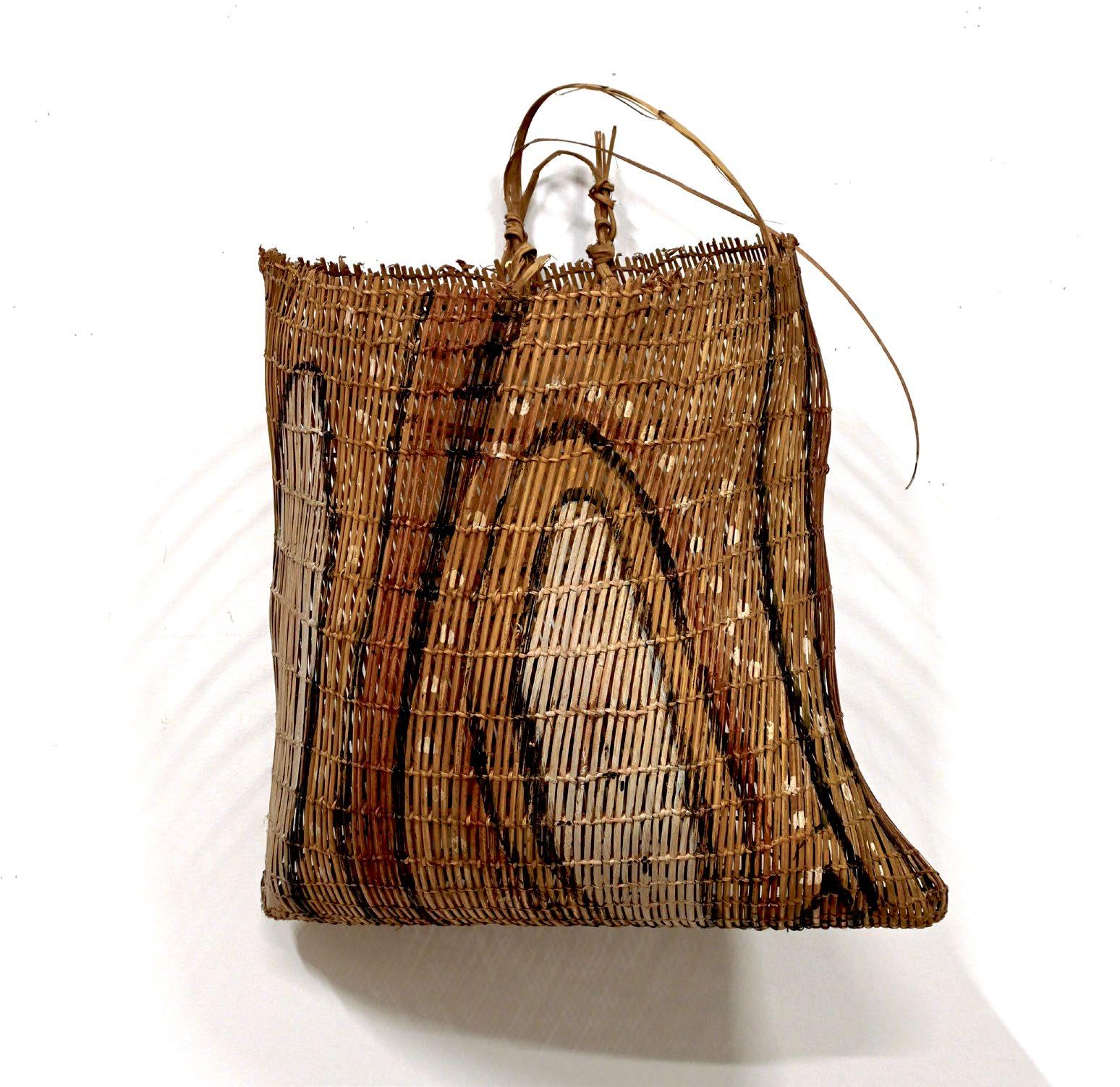
17
(KUTUWULUMI PURAWARRUMPATU)
(1924 - 2003)
KULAMA (YAM) CEREMONY IN RAIN, 1999
91 x 78.5 cm natural earth pigments and synthetic binder on Belgian linen
EST $10,000 - 15,000
Jilamara Arts and Crafts, NT Cat No. KK99MC429 Aboriginal and Pacific Art, NSW, 1999 Lawson~Menzies, Sydney, NSW, May 2005, Lot No. 45 Menzies Estate Collection, Vic
Inscribed verso with artist’s name, date and Jilamara Arts and Crafts
EXHIBITED
Kitty Kantilla, Aboriginal and Pacific Art, Sydney, 1999
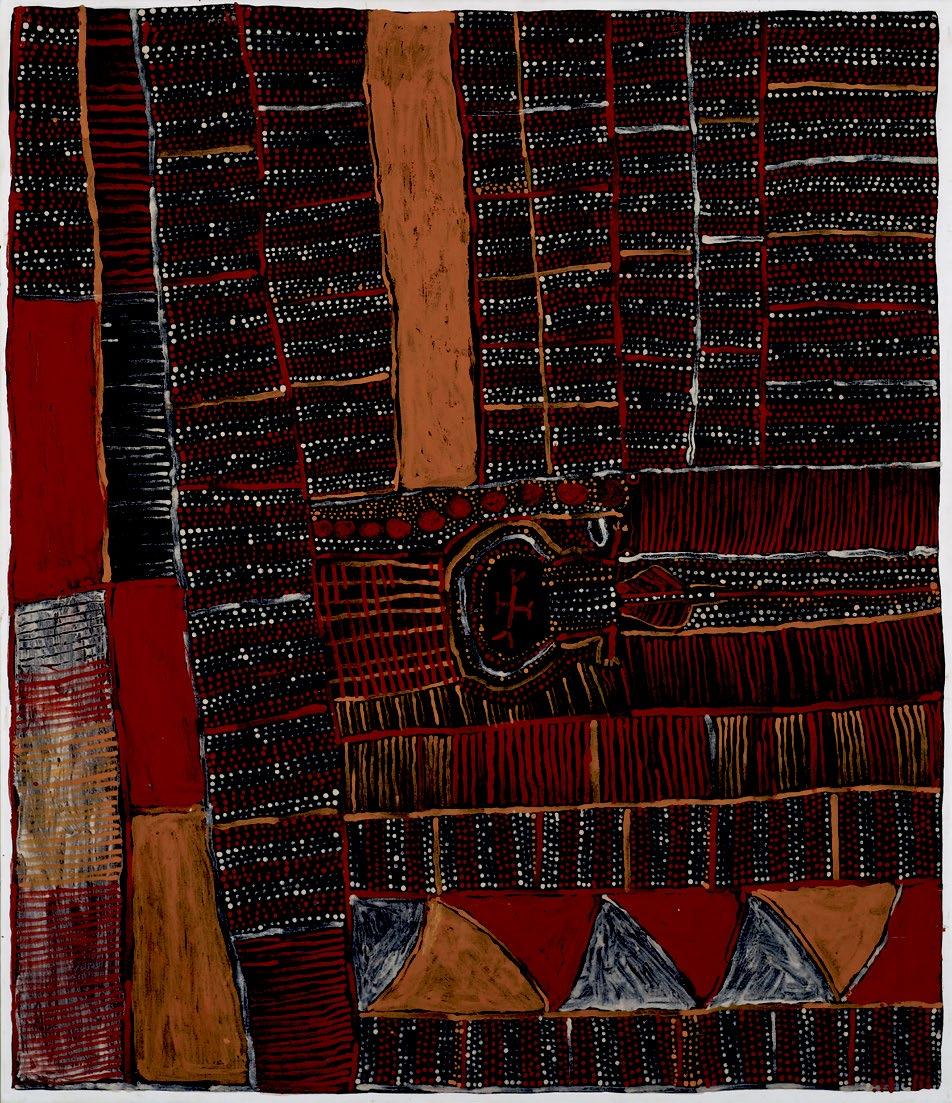
Cf. For a stylistically similar work see: Judith Ryan ‘Kitty Kantilla’, National Gallery of Victoria, Melbourne 2007, ilI. 64, p. 56
This painting refers to people participating in the Kulama ceremony which is the Tiwi initiation and fertility ritual. The path followed by the participants is indicated by the spear, leading to the central ceremonial ground. Four initiates are depicted lying with their heads touching and their bodies facing the four directions.The row of brown shapes indicates yams, the long parallel lines are rain, the triangular patterning represents the hills surrounding the ceremonial site, and the variegated patterns of dotted areas are Jilamara, body designs which denote country.
MOUNT HOUSE, c.1983
122 x 183 cm; 124 x 185 cm (framed) natural earth pigments on plywood
EST $40,000 - 60,000
Field Collected by Neil McLeod, 1985 Lawson~Menzies, Sydney, NSW, November 2005, Lot No. 193 Company Collection, Vic Deutscher-Menzies, Sydney, NSW, September 2009, Lot No. 38 Menzies Estate Collection, Vic
Rover Thomas lived a traditional bush life with his family at Well 33 until he moved, at 10 years of age, with cattleman Wally Dowling to Bililuna Station and began working for a period as a jackeroo on the Canning Stock Route. He worked on several cattle stations situated on the fringes of the Gibson and Great Sandy Deserts including Bow River Station where he was married for the first time, and later at Texas Downs, Old Lissadel and Mabel Downs adjacent to the Warmun community at Turkey Creek where he settled in his later years. The painting itself, illustrates Rover’s extraordinary ability to dominate a picture plane with single elemental forms whilst conveying, beyond the picture’s surface, his intimate knowledge of the vast landscape.

19
FREDDIE TIMMS (1946 - 2017)
UNTITLED, 1996
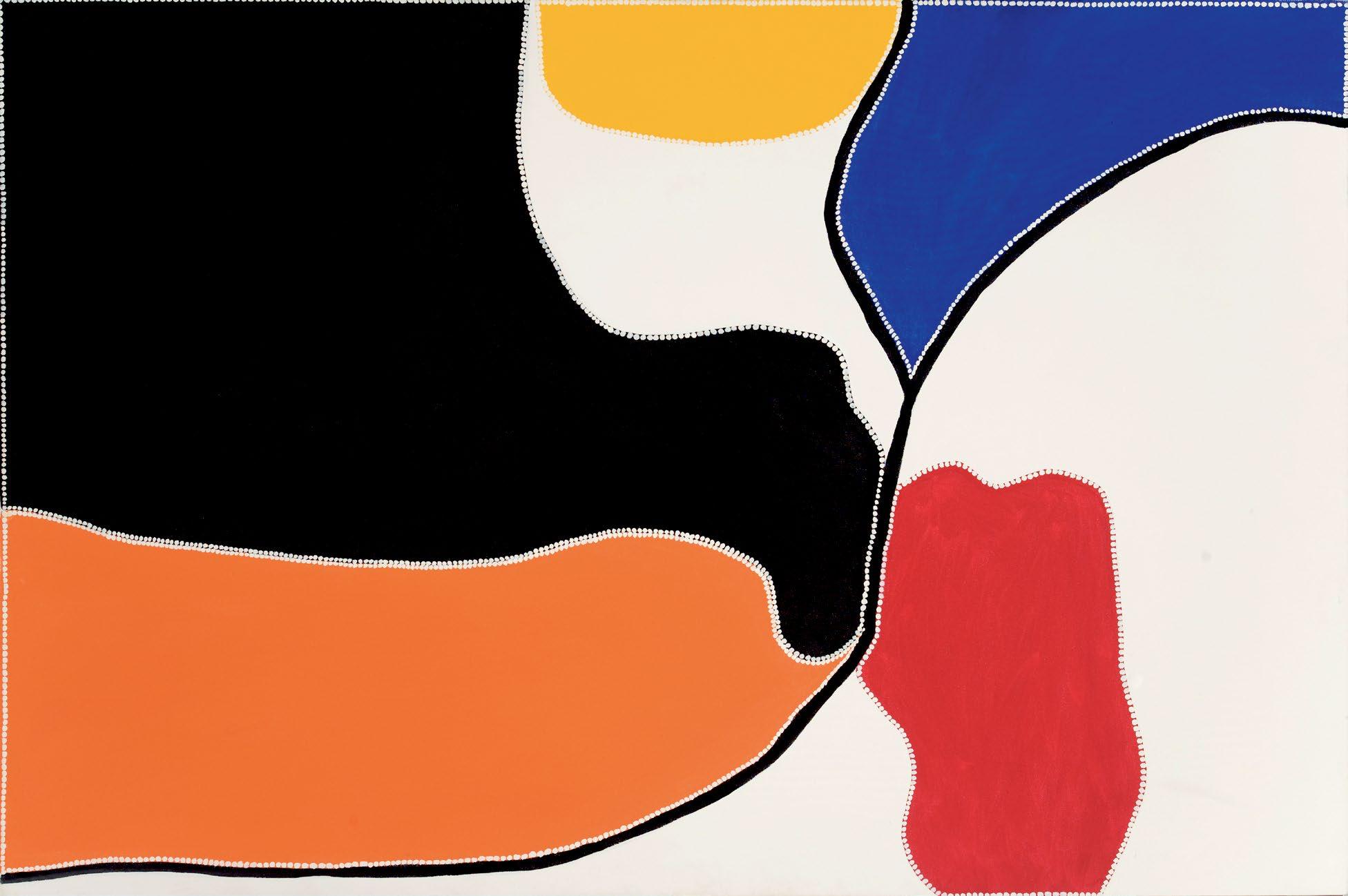
121.5 x 182.5 cm synthetic polymer paint on canvas
EST $8,000 - 12,000
Kimberley Art, Vic Cat No. KAFT004/96 Gould Galleries, Vic Private Collection, QLD Lawson~Menzies, Important Aboriginal Art, Sydney, NSW, June 2008, Lot No. 222 Menzies Estate Collection, Vic
Freddie Timms was born on Bedford Downs Station south west of Turkey Greek and spent his childhood at Bow River and Lissadell Stations where he worked as a stockman, handyman, and fencer. He met and worked with Rover Thomas on Bow River and Texas Downs and participated in the dancing and preparation of boards for the early song and dance performances of Rover’s Krill Krill.
Freddie painted for Waringarri Arts from the late 1980s developing his own personal style working exclusively with earth pigment until the mid 1990s when he began experimenting with colour. His more vivid interpretations of his country were first exhibited with Frank Watters in Sydney, and later Rob Gould in Melbourne. His works are maps of his country imbued with its history and spiritual connections.They are typified by expanses of flat colour delineated by white dotting, according to topography and geology. Included are the black soil country, hills, creeks, watercourses and waterholes, roads, stockyards, homesteads and Dreaming places of his travels.
LORNA FENCER NAPARRULA (c.1920 - 2006)
UNTITLED, 1999
96 x 55 cm (image); 99 x 58 cm (canvas) synthetic polymer paint on Belgian linen
EST $500 - 700
Alcaston Gallery, Vic Cat No. AK4770
Lawson~Menzies, Sydney, NSW, May 2011, Lot No. 102 Menzies Estate Collection, Vic
Born at Yarltu Yarltu near the Granites in the Tanami Desert, Warlpiri artist Lorna Napurrula Fencer emerged as a painter of repute in the early 1990s.
Due principally to her highly charged colour field paintings and wildly gestural style she came to be considered the Warlpiri equivalent of her, more famous, Eastern Anmatierre counterpart Emily Kngwarreye. They shared many Dreamings, most notably, the yam or bush potato which dominated the artworks of both artists.
Bush potatoes grow as roots underground, so the women must use digging sticks to find them.The meandering lines in the centre of this work represent the root system of the bush potato plant.The lines surrounding the plant are digging sticks and the circle at the top is the place where the women dig to retrieve the wild yams which are excellent bush tucker.
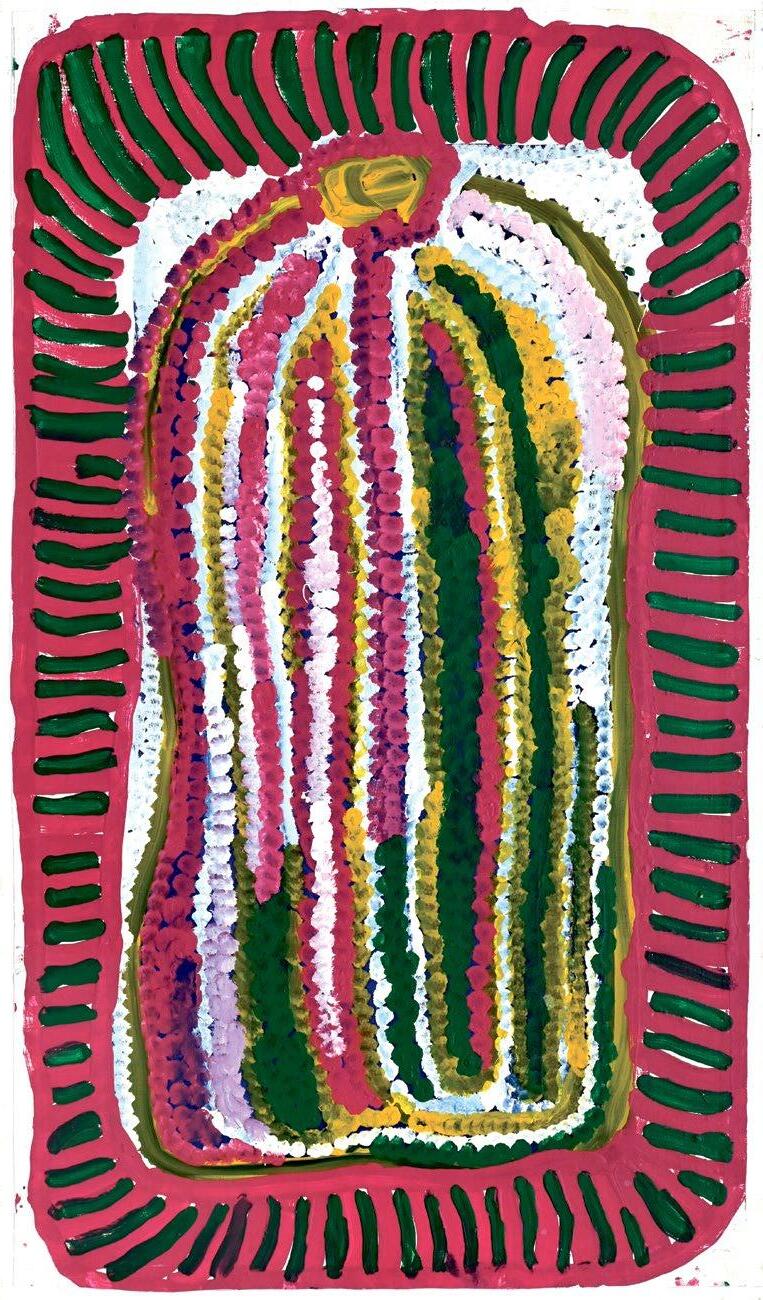
EILEEN
WATI KUTJARA, 2007 94 x 150 cm synthetic polymer paint on Belgian linen
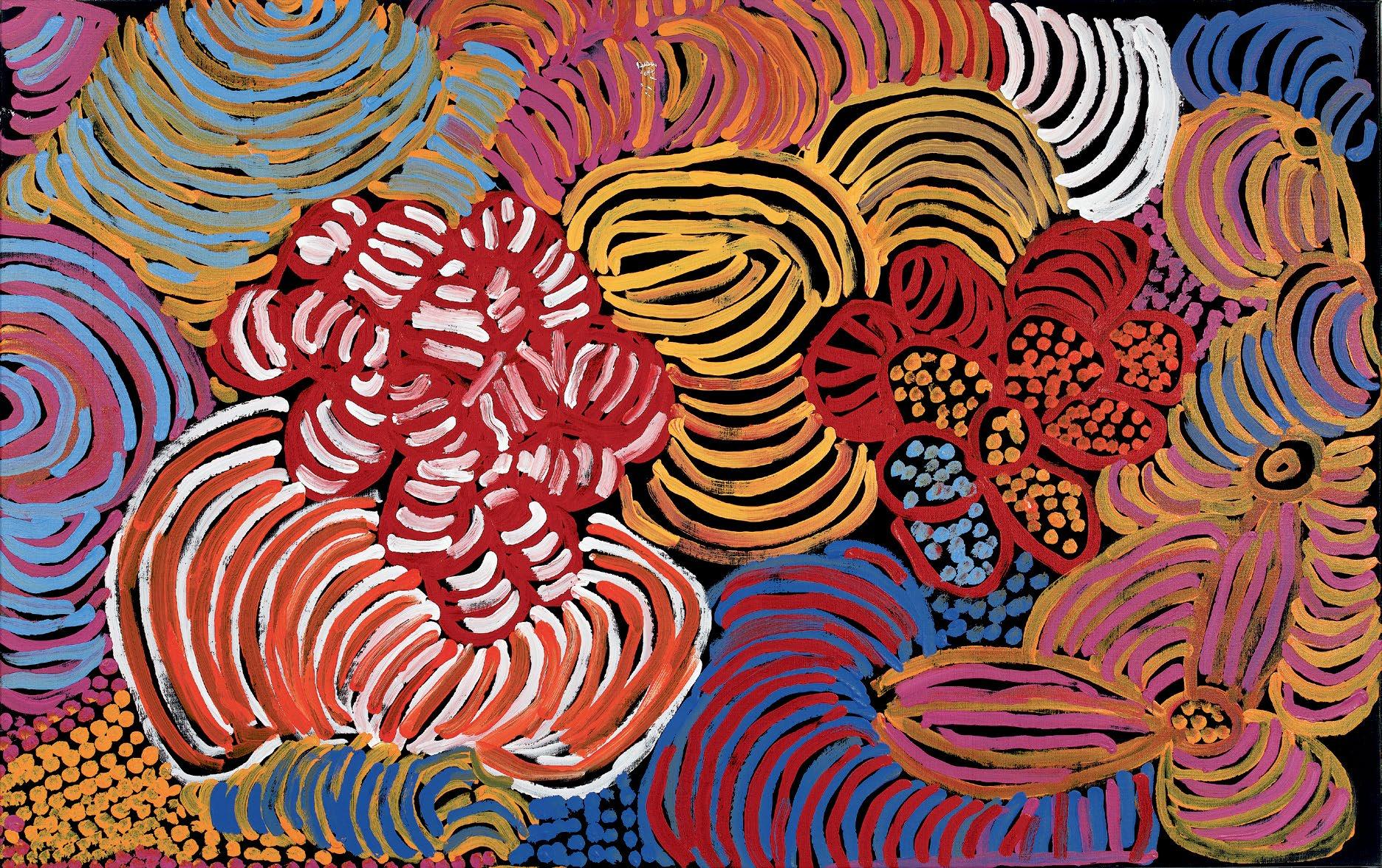
EST $2,500 - 4,500
Irrunytju Arts Centre, NT Agathon Galleries, NSW Cat No. #AGES0307070022 Private Collection, NSW Lawson~Menzies Important Aboriginal Art, Sydney, NSW, June 2008, Lot No. 207 Menzies Estate Collection, Vic
Accompanied by certificate of authenticity from Irrnytju Art Centre
Eileen Stevens was born in the bush at Makiri and worked at Ernabella mission milking goats as a young woman. She did not begin painting until her late 80s and had a brief career of less than four years prior to her death in 2008. Stevens’ art focused on Makiri and its Dreamings, as well as on Piltati, near her husband’s birthplace, which was closely related to the Two Snake Men Dreaming (Wati Wanampi Kutjara Tjukurpa).
She gained immediate renown for her rapidly painted, bold, and highly colour charged large works on canvases.
22
KAWUN, 2005
139 x
PROVENANCE
Irrunytju Arts, NT Cat No. IRRWT05233 Private Collection, TAS Lawson~Menzies, Sydney, NSW, November 2006, Lot No. 59 Menzies Estate Collection, VIC

Accompanied by the certificate of authenticity from Irrunytju Arts
Wingu Tingima grew up in the Great Victoria Desert, near her birthplace, Nyumun, the rock hole at Kuru Ala, W.A. She had no contact with European people until her family, prompted by severe drought and atomic testing in the area, walked into the mission at Ernabella.
By the time the Irrunytju community was established in the 1980s, Wingu was in her seventies but swiftly became one of the foremost artists at the Tjungu Palya art centre. Though she only painted during the ten years prior to her death at the age of about 90, her success was striking. Her confidence and fluidity burst upon the canvas with rich, mosaic-like colour and sinewy, sensuous linear elements evoking ancient imagery drawn from deep cultural knowledge.
The rock holes in her country are sacred places for the seven sisters, Kungkarrakalpa, thus this Dreaming was the focus of most of Wingu’s paintings. In this work she depicted two rock holes with abundant water that she visited with her family and the liru (water snake) that lives here and protects the site.
BUSH MEDICINE, 2000
120 x 90 cm each; 120 x 180 cm (total) synthetic polymer paint on Belgian linen
EST $4,000 - 6,000
Dacou Gallery, SA Private Collection, NSW Lawson~Menzies, Sydney, NSW, May 2006, Lot No. 132 Menzies Estate Collection, Vic
Raised in a remote part of the Eastern Desert and initiated into Anmatyerre law and traditions, Gloria Petyarre participated in the first art programs organised at Utopia in 1977, when she was 39 years of age. These early batik-making workshops marked the emergence of Aboriginal women artists as a force in the desert painting movement.
This highly accomplished work represents the leaves of the Kurrajong tree used in the Utopia region to treat a variety of ailments. The women collect the leaves, dry them, and mix them with Kangaroo fat to extract the plant’s medicinal qualities.The significance of the Kurrajong tree and the part it plays in healing is celebrated in the Women’s Awelye ceremonies.
In painting the Bush Medicine Leaf story, Gloria pays homage to the spirit of the medicinal plant. By recreating its image, she encourages its regeneration, so that her people can continue to benefit from its healing powers.
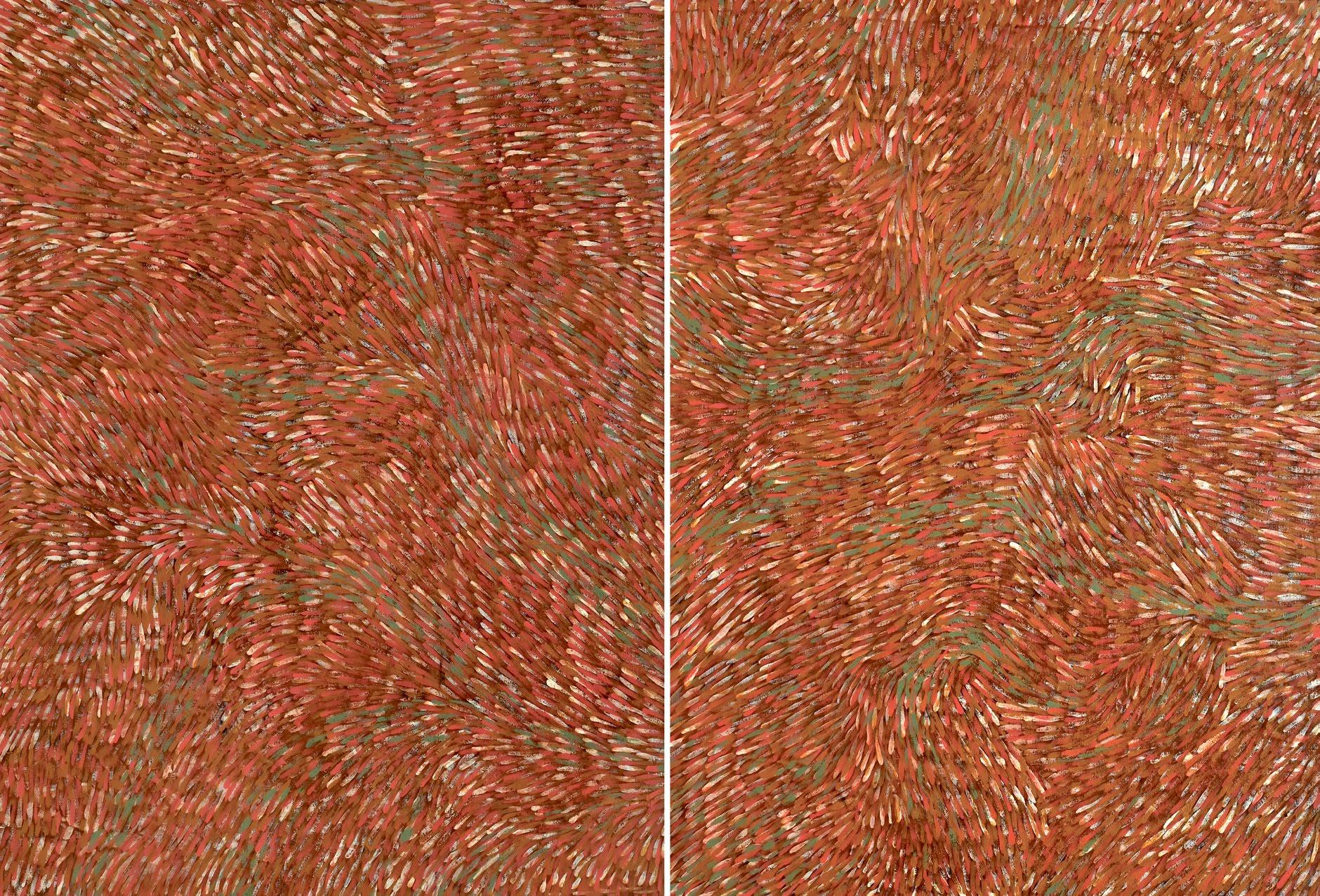
24
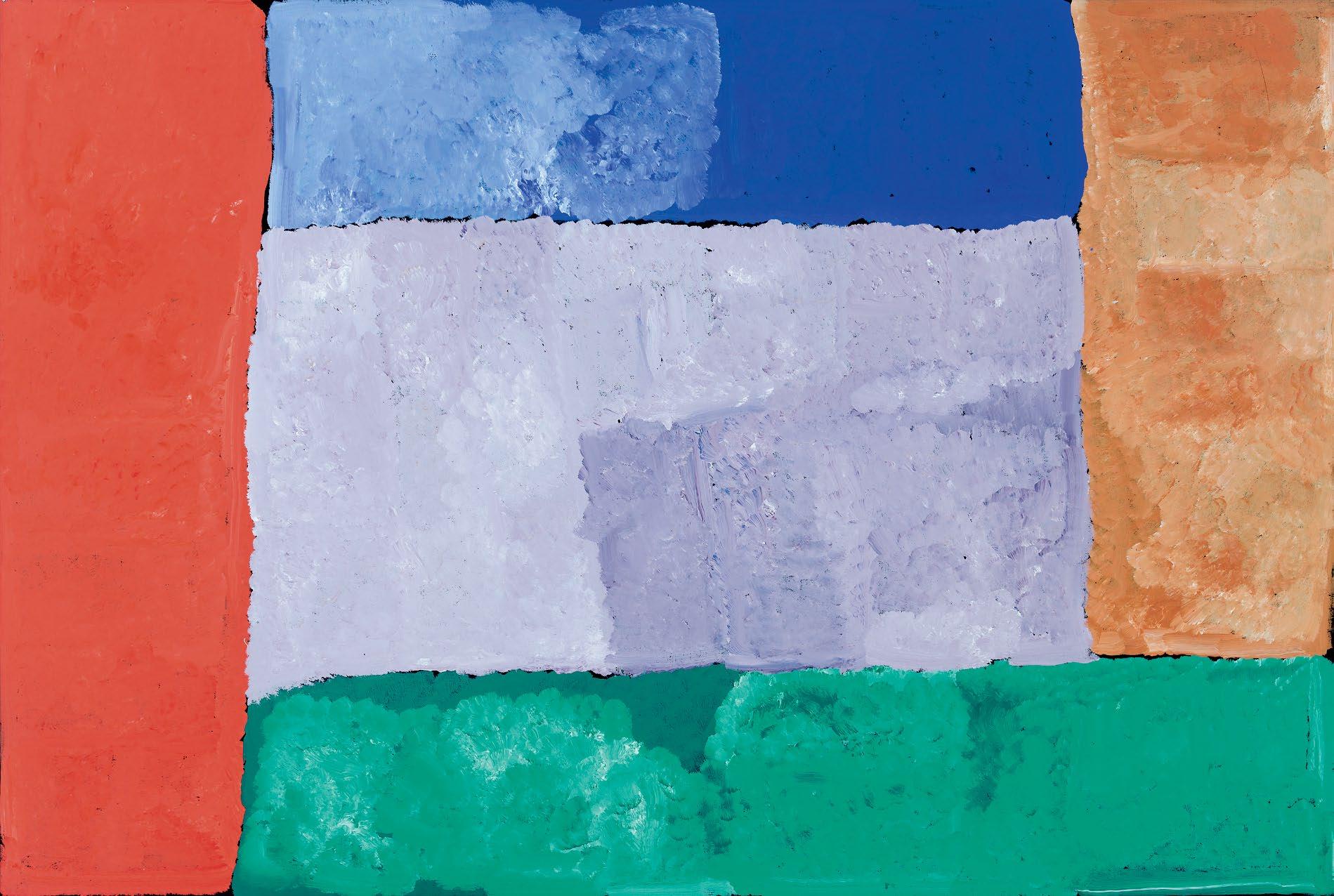
MY COUNTRY, 2005 178 x 118 cm synthetic polymer paint on canvas
EST $4,000 - 6,000
Aboriginal Gallery of Dreamings, Vic Cat No. AGOD10955 Menzies Estate Collection, Vic
Accompanied by certificate of authenticity from Aboriginal Gallery of Dreamings and 7 images of the artist creating the artwork
For the majority of his life, Kudditji Kngwarreye worked as a stockman, like many other Indigenous men who resided on pastoral leases throughout Central Australia. Kudditji was one of the first established male artists at Utopia. He was the traditional custodian of many important Dreamings of the land and Men’s Business, as well as ceremonial sites located in his country at Utopia Station, about 230 km north east of Alice Springs.
‘My Country’, represents the wild flowers found in the desert landscape. The artist’s brushstrokes were loose and confident, as he applied colour in geometrically arrayed patterns. Works like this are reminiscent of the style of his late sister, Emily Kngwarreye, who was also praised for her bold brush strokes and remarkable sense of colour, accentuating the natural colours of land and sky over various seasons.
WARPUTI - WHITE POTATO, 2003
193.5 x 295.5 cm synthetic polymer paint on canvas
EST $9,000 - 15,000
Muk Muk Aboriginal Art, NT Cat No. A4196
Lawson~Menzies, Important Aboriginal Art, Sydney, NSW, June 2009, Lot No. 226
Menzies Estate Collection, Vic
Accompanied by a folio of fifteen printed photographs of the artist creating the work
Lorna Napurrula Fencer was a senior Warlpiri artist born at Yartulu Yartulu. She was custodian of the inherited lands of Yumurrpa in the Tanami Desert. She began painting in the mid 1980s and is now widely acknowledged as one of the great Warlpiri artists from Lajamanu. She was a custodian of the Dreamings associated with bush potato, caterpillar, bush onion, yam, bush tomato, bush plum, many other different seeds, and, importantly, water.
Bush potatoes grow on roots underground, so the women must use the digging sticks to find them. Here we see the bush potato plants with their interconnected root system. As the plants die off after flowering, the potatoes grow to maturity and the ground cracks revealing their location.
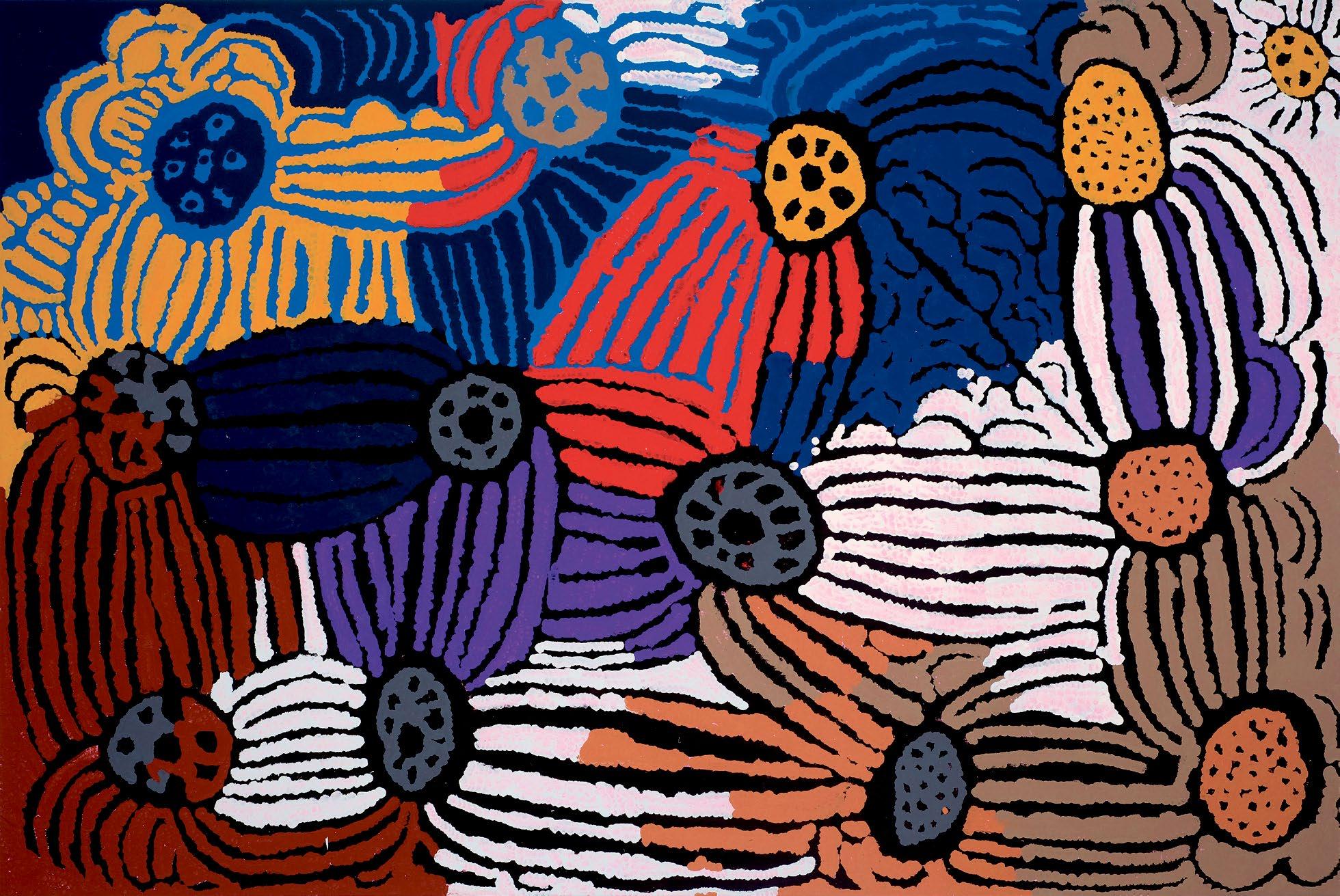
GLORIA PETYARRE (1942 - 2021)
BUSH MEDICINE DREAMING, 1996 202 x 178 cm synthetic polymer paint on Belgian linen

EST $4,000 - 6,000
PROVENANCE
Dacou Gallery, SA Cat No. DG01749
Flinders Lane Gallery, Vic Private Collection, Vic Lawson~Menzies, Sydney, NSW, May 2006, Lot No. 90 Menzies Estate Collection, Vic
In this highly original and visually energetic work Gloria’s concentrated vitality enabled her to build the rhythm of traditional song and dance. The dashes of colour visualise the movement of leaves in the wind as they whirl and flow. Through pattern and repetition her paintings capture the energy of the land, and communicate the underlying vibrant spirituality and transformative intensity of the landscape.
Gloria Petyarre was a highly motivated painter who, though always tethered to her Indigenous traditions, expanded upon them, and moved beyond the literal to create images that radiated with intensity and integrity. She was one of Australia’s greatest contemporary painters and became the first Indigenous artist to be awarded the Wynne Landscape prize at the Art Gallery of New South Wales besides numerous other awards and accolades.
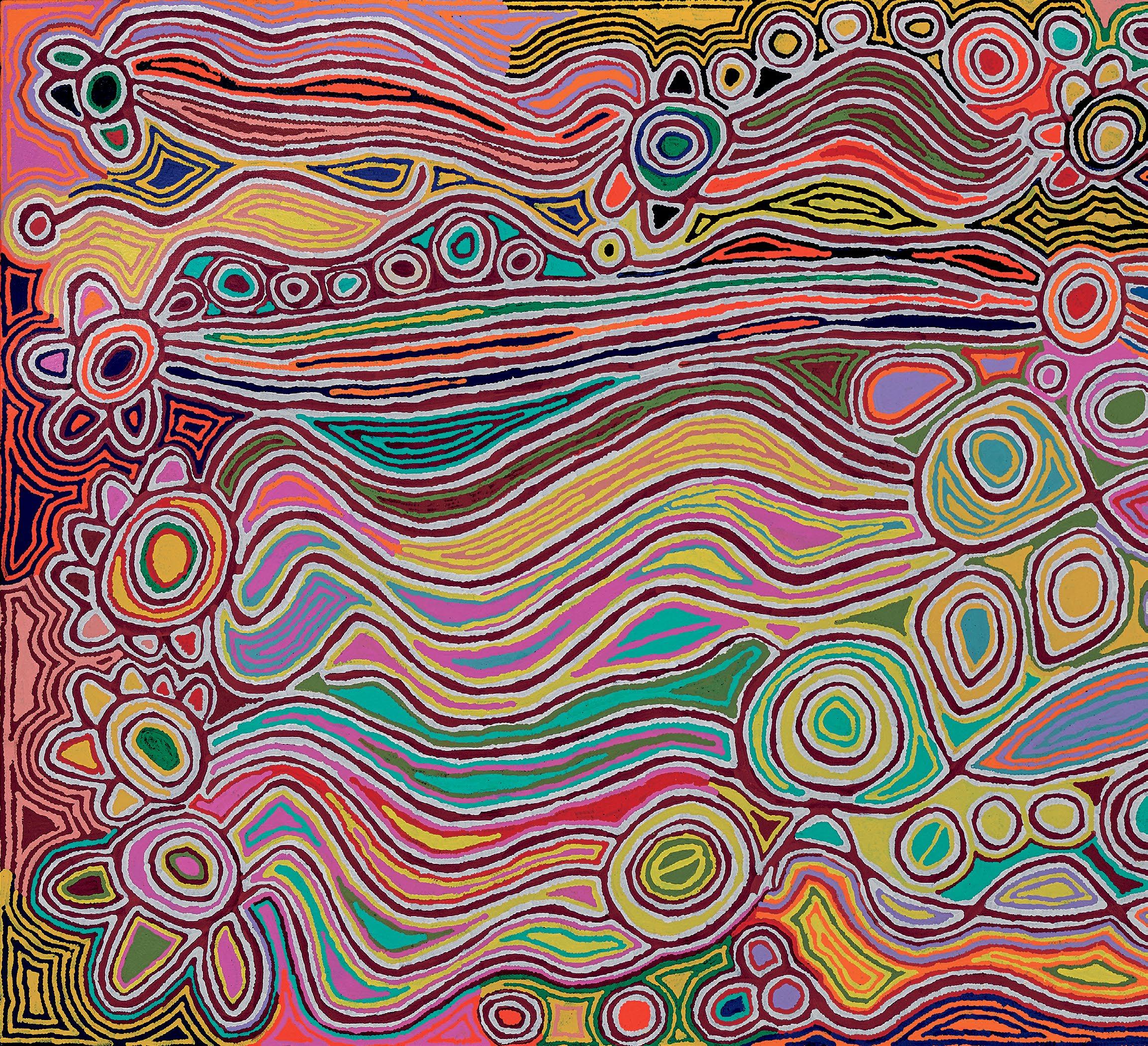
MY DREAMING, 2007
180 cm x 297 cm synthetic polymer paint on canvas
EST $25,000 - 35,000
Aboriginal Art World, NSW Cat No. JUDNA0026 Company Collection, NSW Lawson~Menzies, Sydney, NSW, September 2008, Lot No. 245 Menzies Estate Collection, Vic
Judy Watson was born at Mount Doreen Station, north-west of Alice Springs. Her ancestral homeland centred on Mina Mina and Yingipurlangu, in the area between the Tanami and Gibson Deserts.
Taught to paint by her older sister, Maggie, Judy started with the traditional subject of Mina Mina and the Dreamings associated with it. Together they developed a unique style of painting that was characterised by coloured sinuous lines created by using a ‘dragged’ dotting style which was said to mimic the dance of their female ancestors as they moved across the desert in formation. By criss-crossing the canvas with these twisting lines, their paintings became splendidly textured and evoked both the movement of her ancestors and the land through which they danced.
This work is a fine representative example of the more abstract informal style that came to characterise Warlpiri women artists’ work. As well as representing the land itself, it depicts the hair string rubbed with red ochre which is used as a belt, and the tassels that symbolise their spiritual connection to the land.The flowing lines are also symbolic of the snake vines, which are used to bind branches and feathers to the bodies of ceremonial dancers.
Judy’s work is thus ripe with both literal and metaphorical meaning and this complexity is indicative of a sophisticated spiritual narrative. Dr. Christine Nicholls, a keen spectator of Warlpiri art since the genesis of the painting movement, has observed that what to the Western eye may seem like a desert of undifferentiated colour, was to Judy and her people ‘perceived as a large and colourful garden bursting with energy’.
Access to synthetic paints rich in bright primary and secondary colours, enabled Judy to enhance and expand upon her centuries old spiritual connection to the homeland, enlivening the painted surface with forms and patterns that intimate the motion of ritual dance through sacred country.

MAGGIE WATSON NAPANGARDI (1921 - 2004)
DIGGING STICK DREAMING, 1995/1996
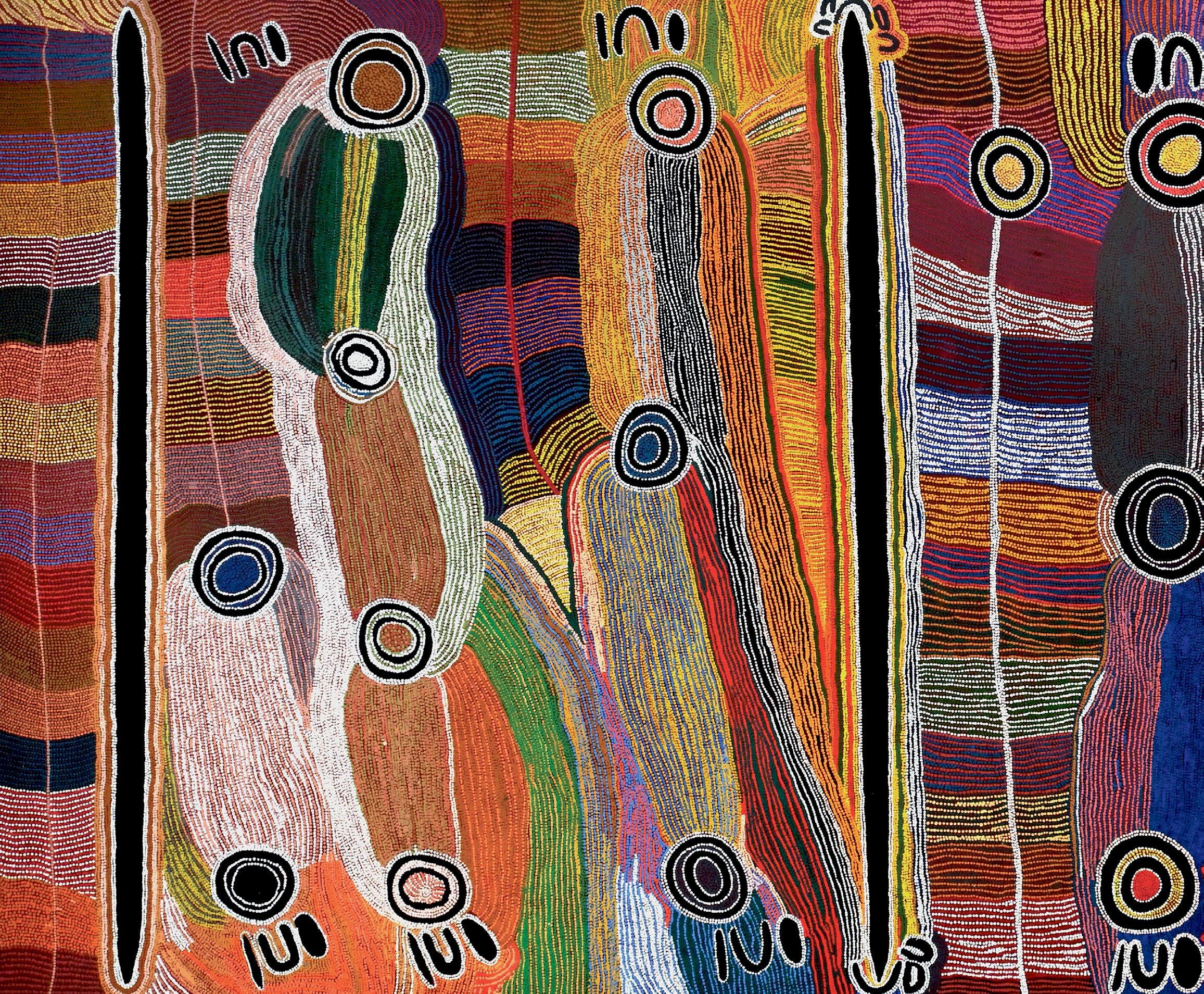
201 x 351 cm synthetic polymer paint on Belgian linen
EST $90,000 - 150,000
Kimberley Art Gallery, Vic Cat No. KAMW001/96 Private Collection, Vic
Lawson~Menzies, Sydney, NSW, 9 November 2005, Lot No. 113
Menzies Estate Collection, Vic
EXHITBITED
Masterworks from the Menzies Collection, 2007-2008, SH Ervin Gallery, Newcastle Regional Gallery, Manly Art Gallery, Tweed Regional Gallery and additional venues.
Maggie Watson was a leader amongst a group of Warlpiri women artists who began to challenge the dominance of men’s acrylic painting in the central desert region from the mid-1980s. The emergence of these women in Yuendumu and simultaneously in Utopia (amongst Anamtjerre and Alyawarre peoples) challenged the false anthropological assumption that men were the sole guardians of the visual life of these communities. The historical evolution of the movement of which Maggie was part, began with the encouragement of more permanent painting techniques in the 1970s in both Yuendumu and Papunya. With the introduction of acrylics in the 1980s, the women artists progressed from painting ritual objects for sale to painting on boards as a source of revenue.

In rejecting desert ochres used for ceremony in favour of vibrant acrylics, during the mid-1980s, these women grasped the opportunity to express their feeling for country in an unforeseen and novel way. The use of flamboyant colour and richly textured surfaces became the hallmark of Maggie Watson’s paintings. Her willingness to adopt vibrant acrylic colours was founded upon the Warlpiri women’s response to shiny shimmering surfaces. During ceremony women apply red ochre mixed with animal fat to their skin. It is associated with the health, vitality, beauty, and allure of their female ancestors.
Maggie Watson’s works are characterised by striated bands of alternating colour, shimmering across the surface of her canvases. They mimic the movement of the ancestral women as they danced across the landscape, the claypans, soakages, and sandhill country through which they passed.
This Digging Stick Dreaming, created over several months in 1995, is believed to be the magnum opus of Maggie Watson’s career, which ended just 3 years later. Here we see a spectacular representation of the artist’s country through a story that she shares with other well-known artists, including her sister Judy Watson (who she taught to paint) and Dorothy Napangardi.
The grandeur of the country is mapped out with an impressive geometry of clearly delineated roundels joined by ribbons of finely dotted colour. Rendered in an inventive palette, it flows like rivers from one junction to another in an intriguing patchwork. Soft browns, tans, oranges, vermilions, and yellows are offset quite brilliantly with white, imparting a magical shimmer and depth to the surface.
During the Dreaming, digging sticks (Kana) magically emerged from the land at Mina Mina, equipping a large number of ancestral women for their travels over a vast stretch of country. The tall Desert Oaks (Kurrkapi), which grow near Mina Mina, symbolise their appearance as they rose up from beneath the ground itself in the Dreamtime. To this day they are thought of as both the living embodiments of those digging sticks as well as the lithe, upright young women who were amongst their bearers. As the women danced their way across the desert in joyous exultation they clutched the digging sticks in their outstretched hands. Dancing in a long line they created important sites and encountered other Dreamings. Hundreds of these women travelled on the long journey first toward the east, then to the north, then to the south collecting plants and foods with both medicinal and ceremonial uses. They visited many sites, resting at some, going underground at others and later re-emerging or morphing into different, sometimes malevolent, beings. These powerful ancestral women were involved in initiation ceremonies and used human hair-string spun and rubbed with special red ochre and fat as part of their magic.
In 1985, Maggie Watson had her first exhibition at Araluen Arts Centre in Alice Springs. It was the beginning of a career of some 13 years, which would see her work exhibited in major state galleries all around Australia. These include the major exhibitions: ‘Yuendumu: Paintings out of the Desert’, South Australian Museum exhibition in 1988 and ‘Power of the Land’ – Masterpieces of Aboriginal Art at the National Gallery of Victoria in 1994.
During her lifetime her works were exhibited internationally in Tucson, Pittsburgh, Chicago, San Diego, and Miami in the USA, as well as in Paris, Dusseldorf, London, and Auckland.
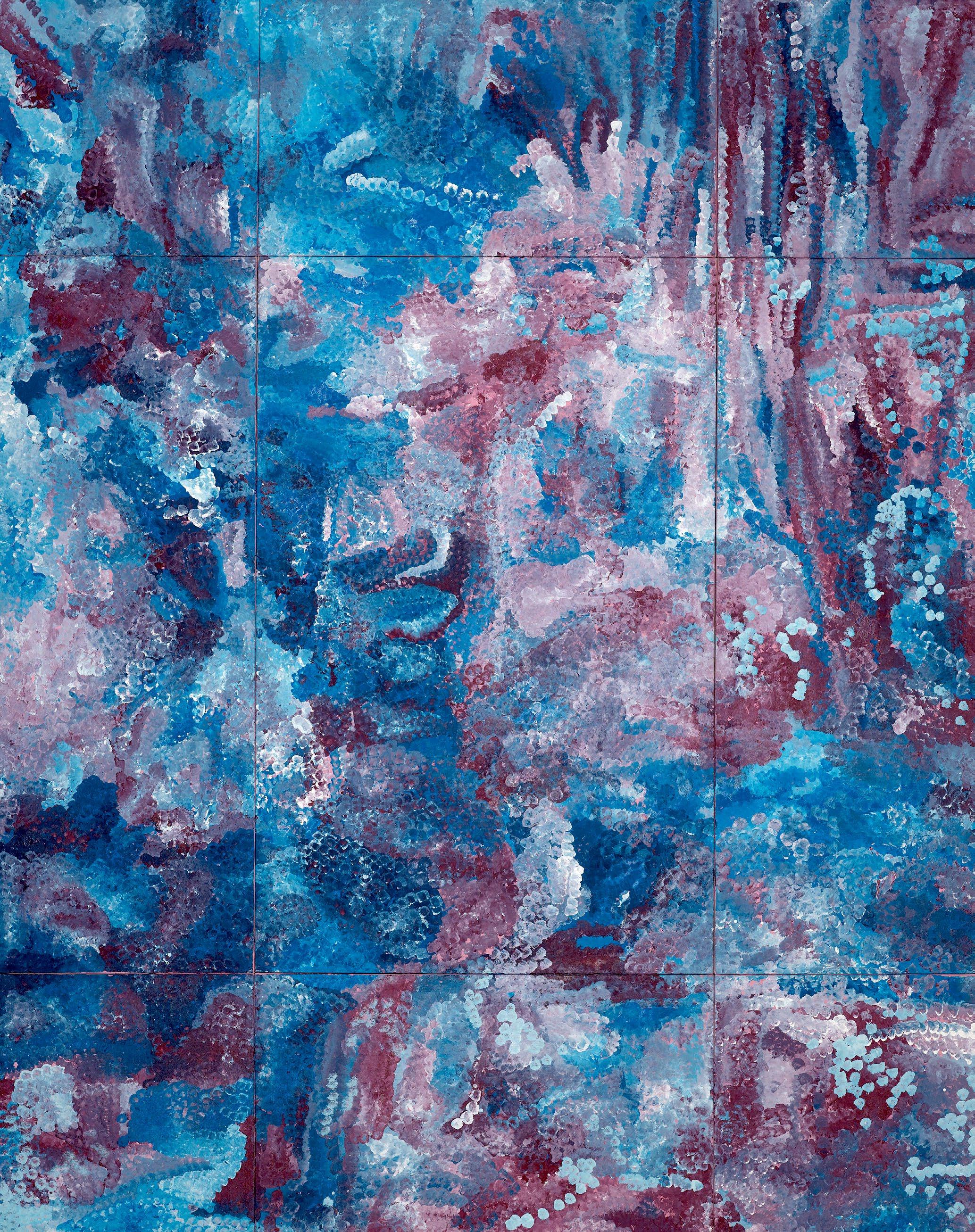
29
EMILY KAME KNGWARREYE (1910 - 1996)
EARTH’S CREATION II, 1995 318 x 251 cm synthetic polymer paint on Belgian linen
EST $400,000 - 600,000
PROVENANCE
Dacou Gallery, SA Cat No. SS1197158 (A - I) Private Collection, SA
Lawson~Menzies, Sydney, NSW, November 2007, Lot No. 60 Menzies Estate Collection, Vic
Comprising 9 panels - each panel inscribed verso: SS1197158 (A - I) indicating that this was created during the same special bush workshop during which ‘Earth’s Creation I’ was painted.
Accompanied by a copy of a certificate of authenticity from Dacou and 9 images of the artist creating the artwork
Emily Kame Kngwarreye was born at Utopia station in a remote desert community almost 300 km north-west of Alice Springs. Before beginning her professional painting career in the late 1980’s, she worked at Utopia as a batik artist for around 10 years. Her career as a painter was as prolific as it was passionate and after several years she had established herself both locally and internationally. She died in September 1996 leaving behind a remarkable story of inspiration, a profound and invaluable legacy to the art world.
Emily went through many different individual styles during her short eight-year career as a professional painter. By the 1990’s early works with intimate tracking and animal prints interspersed with fine dotted colour fields, gave way to running dotted lines over cloud-like ethereal landscapes, and parallel horizontal and vertical stripes, representing ceremonial body painting, in a wide array of colours. Within a year she began using larger brushes than previously and by 1993 she began creating floral images in a profusion of colour by double dipping brushes into layers of paint resulting in variegated petals in hepatic profusion. Her formal body painting line images yielded to the serendipity of scrambling yam roots and, in the final months of her life, to colour fields painted with large flat brushes that are simply brilliant in their assuredness and utter simplicity. While her preoccupation was the life cycle of the Yam in all of its seasonal manifestations and the women’s ceremonies that celebrated its importance and their responsibility as its custodians, Emily painted many interrelated themes and species.
In her own words, she painted: ‘Whole lot, that’s all, whole lot, awelye, arlatyeye, ankerrthe, ntange, dingo, ankerre, intekwe, anthwerle and kame. That’s what I paint: whole lot. My Dreaming, pencil yam, mountain devil lizard, grass seed, dingo, emu, small plant emu food, green bean and yam seed.’
In 1995 Emily participated in a workshop organised by her nephew Fred Torres during which a number of major multi-panelled masterpieces were created. Of these, Earth’s Creation I, the major triptych measuring 632 x 275 cm, was included in her touring retrospective exhibition curated by Margo Neale for the Queensland Art Gallery in 1998. The painting was offered for sale in 2017 and sold for $1.056 million. On the request of the National Museum of Australia, Earth’s Creation I was subsequently loaned to tour in Tokyo and Osaka in Japan in 2007, and exhibited at the National Museum in Canberra in 2008. It was exhibited in the Great Hall of Parliament House in Darwin before heading to its new home in Alice Springs. In 2015 the work was exhibited in the Giardini Central Pavilion at the 56th Venice Biennale,“All the World’s Futures”, curated by Okwui Enwezor. Earth’s Creation I, was subsequently sold at auction in 2017 through Cooee Art for $2.1 million, breaking the record it had set in 2015 for the highest sale price achieved by an Australian female artist. The record remains.
Earth’s Creation II, was created during the same workshop. It was painted while the artist sat upon the canvas, moving around as she worked continuously until the entire surface was completed. From every part of the work, its sublime orchestration engages the eye with dazzling energy and flowing movement. The painting is a luminous celebration with a mystical, ethereal presence. It’s about her life, her story, her country. It’s about her universe and the mythologies that inform the Dreamings. Filled with mystery, it pays reverence to the sacredness of the Earth, the seasons, vegetation, people, the epic adventures of her spiritual ancestors, and ceremonies that she daily engages with in her life.
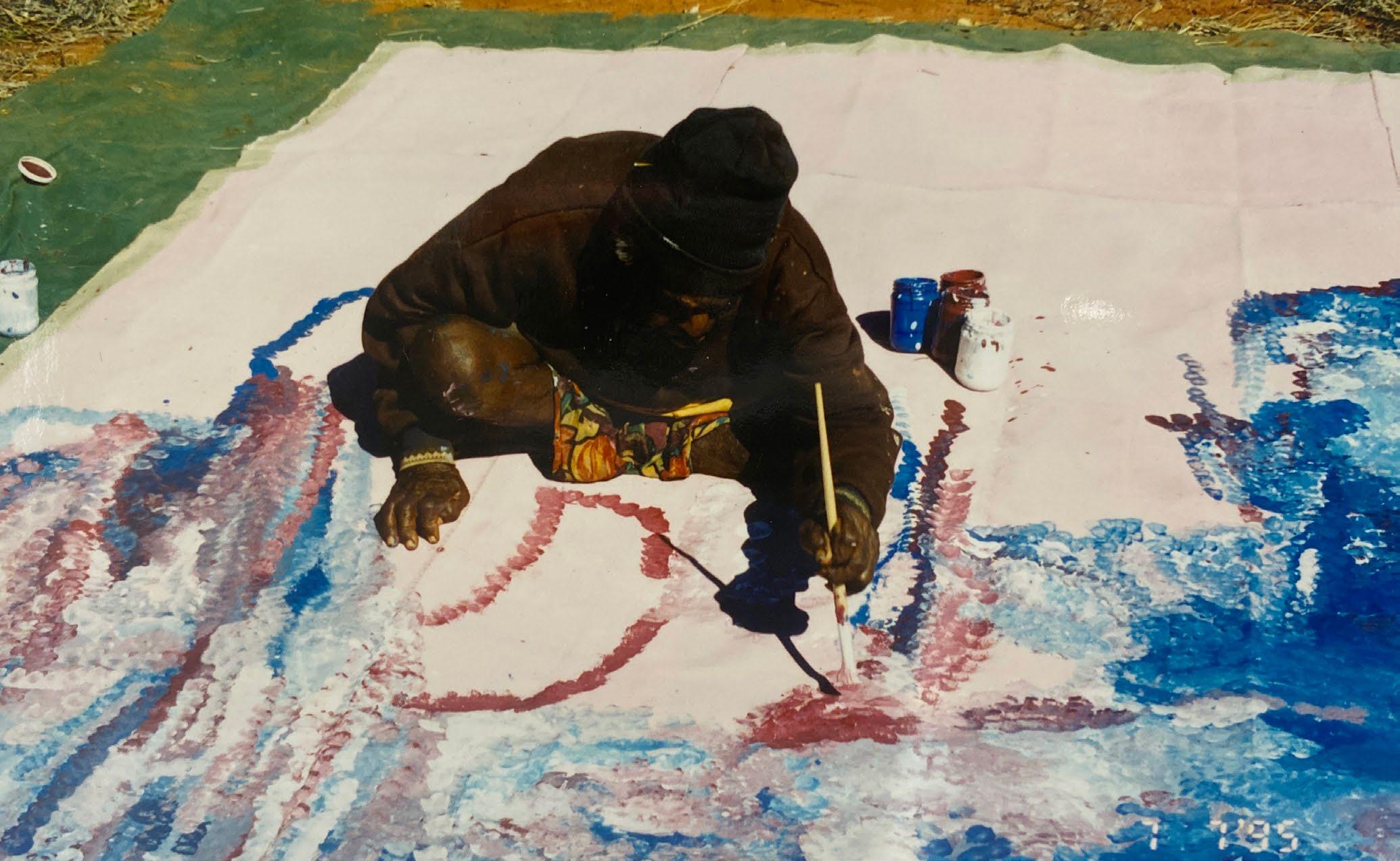
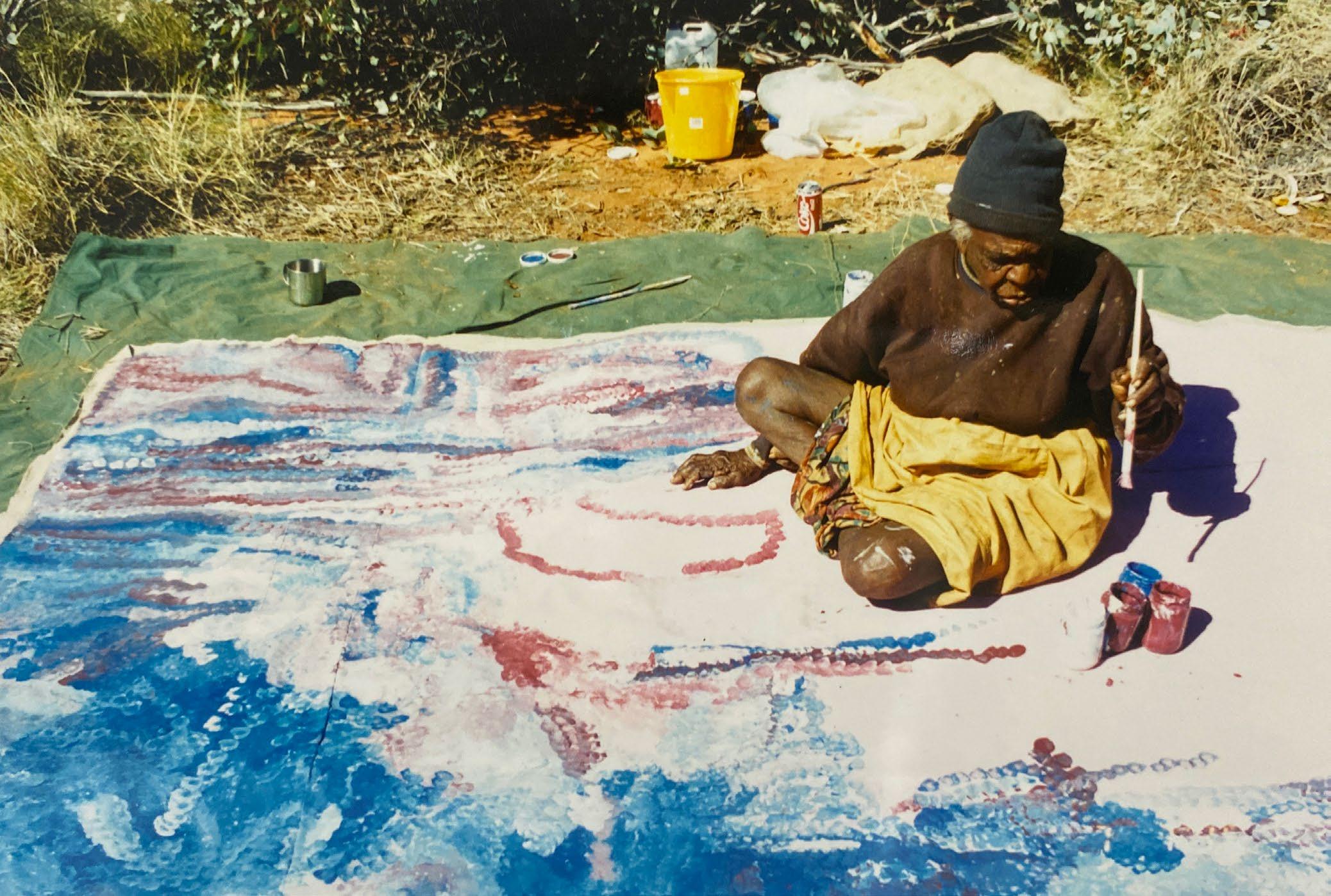
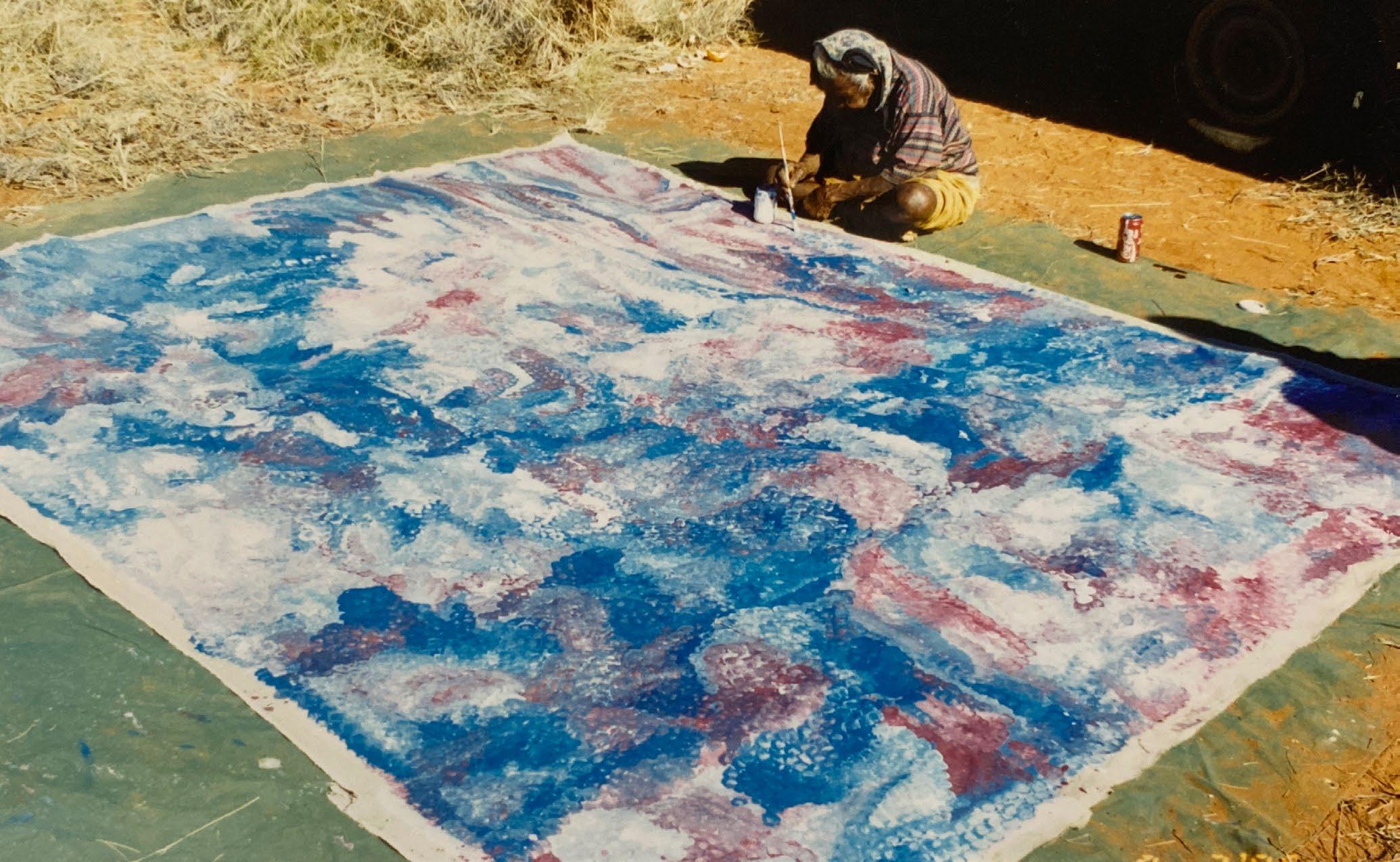
DOROTHY NAPANGARDI (c.1956 - 2013)
MINA MINA, 2003 122 x 198 cm synthetic polymer paint on Belgian linen
EST $18,000 - 25,000
Gallery Gondwana, NT Cat No. 7544DN Vivien Anderson Gallery, Vic Private Collection, Vic Lawson~Menzies, Sydney, NSW, May 2007, Lot No. 77 Menzies Estate Collection, Vic
Dorothy Napangardi’s paintings trace the travels of her female ancestors, the Karnta Kulangu, toward the east as they danced their way through the Mina Mina salt pans, Spinifex, and sand hills.
The lines of white dots represent the salt encrustations which form patterns on the mud flats mimicking the ebb and flow of their movement through this shimmering landscape.
Dorothy Napangardi was the winner of the 18th National Aboriginal and Torres Strait Islander Art Award in 2001 and in 2002 her solo exhibition Dancing Up Country was held at Sydney’s Museum of Contemporary Art.
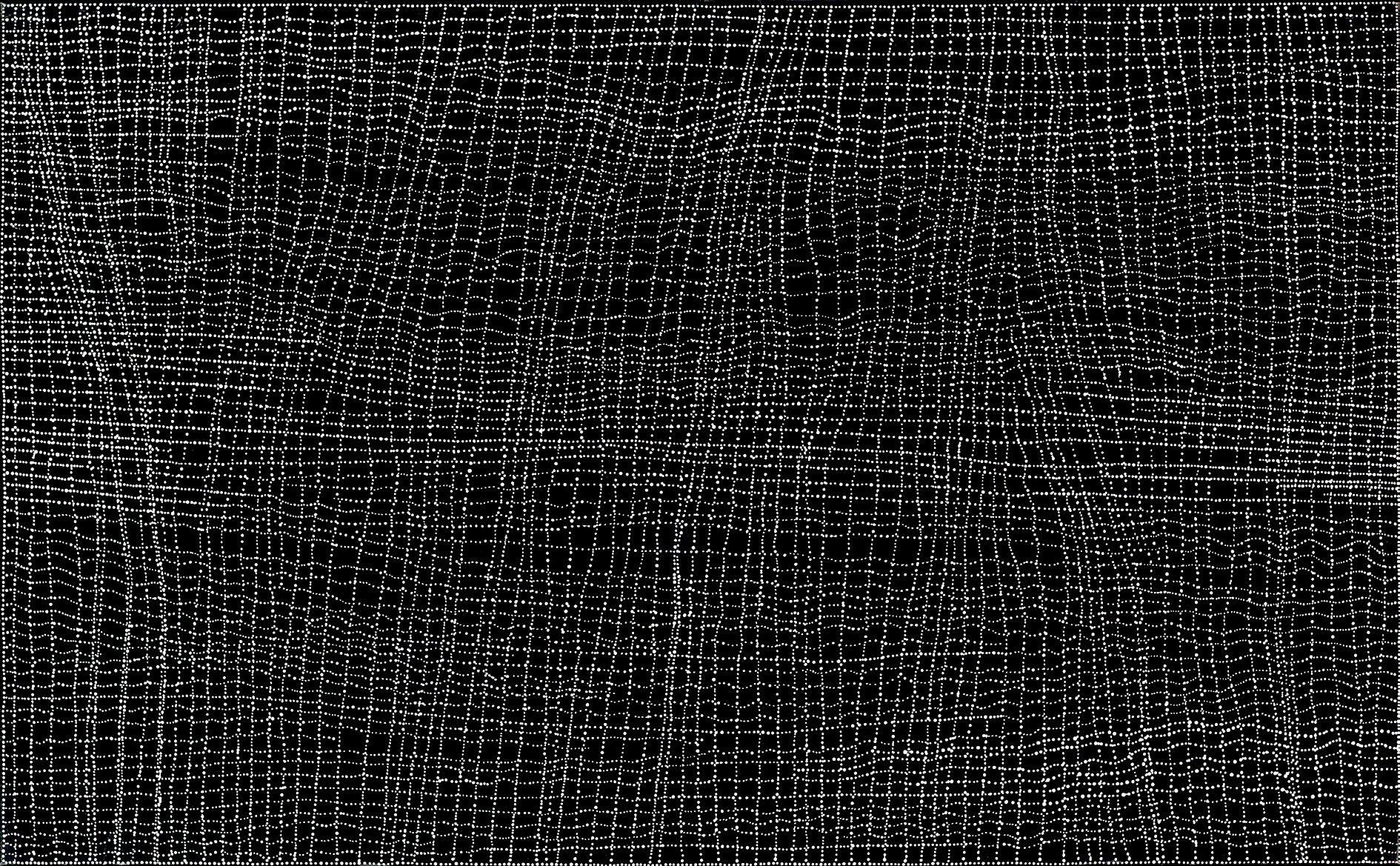
EMILY KAME KNGWARREYE (1910 - 1996)
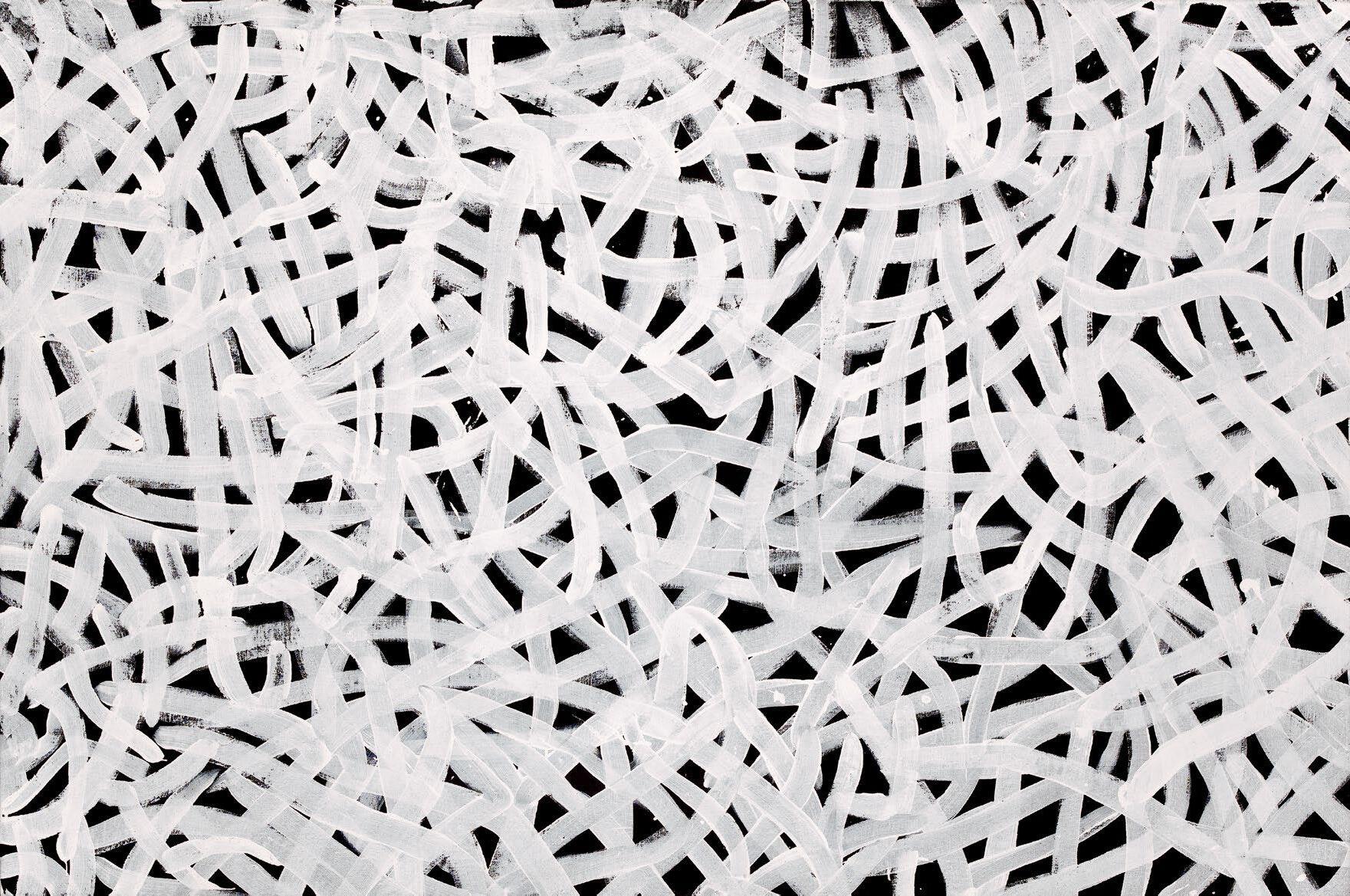
BUSH YAM DREAMING, 1994 183 x 122 cm synthetic polymer paint on canvas
EST $80,000 - 120,000
Aboriginal Gallery of Dreamings, Vic Cat No.AGOD#5512 Private Collection, Vic Lawson~Menzies, Sydney, NSW, May 2007, Lot No. 80 Menzies Estate Collection, Vic
Accompanied by a certificate of authenticity from Aboriginal Gallery of Dreamings
Cf. For stylistically similar works see: ‘Wild Yam I, 1995’ in Janet Holt (et. al.), ‘Emily Kngwarreye Paintings, Craftsman House, 1998, plate 70 illus. pp 166167 and various other works pp 168-180. Also, the cover image of the Retrospective catalogue ‘Emily Kngwarreye, Alhalkere Paintings from Utopia, Margo Neale (ed), Queensland Art Gallery, 1998
Also the cover image of the Retrospective catalogue ‘Emily Kngwarreye, Alhalkere Paintings from Utopia, Margo Neale (ed), Queensland Art Gallery, 1998.
The subject of this major work, privately commissioned in 1994, is Arlatyeye, the Pencil Yam or Bush Potato.This is a valuable food source and the subject of important songs, dances, and ceremonies amongst Eastern Anmatjerre people. It was the subject of a great number of Emily Kngwarreye’s paintings, which were created, most familiarly, in a vast array of vibrant colours. In this painting however, Emily has characterised the roots of the yam in the plant’s full period of maturity. As the foliage dies off, cracks appear in the ground, which trace the root system, and indicate that the engorged tubers are ready to eat.
UNTITLED, 2007

140 x 300 cm
synthetic polymer paint on canvas
EST $6,000 - 8,000
Fireworks Gallery, Qld Cat No. FW10107
Lawson~Menzies Important Aboriginal Art, Sydney, NSW, June 2009, Lot No. 230
Menzies Estate Collection, Vic
Joanne Currie grew up on the banks of the Maranoa River in the 1960s.She has described it as a no-man’s land, a grass roots lifestyle, kero lamps and heaters, government issue blankets - families and hardships.
Joanne’s paintings speak of the river as a living entity but also appear to transmit other elements - perhaps the shimmer of wind on the water, the aura of light and air? Her highly charged paintings have a individual style that, whilst instantly recognisable as Indigenous, speaks of her journey as an artist moving within cultures - artwork that holds to tradition yet sits confidently in the here and now. The loaded lines in all her work mark Joanne’s intelligence as a dynamic Queensland artist, and sustain her passion and determination as a survivor.
RONNIE TJAMPITJINPA (c.1943 - 2023)
WATER STORY, 1999
175.5 x 342 cm synthetic polymer paint on Belgian linen
EST $16,000 - 24,000
PROVENANCE
Kimberley Art, Vic Cat No. KA 00504 Private Collection, Vic Lawson~Menzies, Sydney, NSW, March 2009, Lot No. 123 Menzies Estate Collection, Vic
Accompanied by certificate of authenticity from Kimberly Art
EXHIBITED
Ronnie Tjampitjinpa, Aborignial Lawman - Masterworks, The Australian Exhibition Center, Chicago, 5 May - 10 June 1999
Although he began painting in the early 1970s, Ronnie Tjampitjinpa’s reductive, linear works first appeared in the mid - 1990s. While it may be challenging to reconcile these contemporary images with their traditional content, the overall shimmer he effects with seemingly minimal application radiates the artist’s authority and self-assuredness.
This painting depicts the travels of the Tingari Men to the site of Ungama, south west of Kiwirrkura. A large group of wise men travelled across the country and gathered at this site performing ceremonies, then they travelled to Kiwirrkura. The formations in this painting represent rainwater filtering and washing its way to the soakage water site at Ungama.

WOMENS CEREMONY - SANDHOLES & ROCKHOLES NEAR KINTORE, 2004
123.5 x 151 cm synthetic polymer paint on Belgian linen
EST $4,500 - 5,500
Watiyawanu Community, Mt Leibig, NT Cat No. 77-424 Backtrack Arts, NT Lawson~Menzies, Aboriginal Art, Sydney, NSW, May 2006, Lot No. 98 Menzies Estate Collection, Vic
Wentja Napaltjarri grew up west of Kintore in her father’s country, located in the Gibson Desert. Wentja is the daughter of one of the founders of the Desert painting movement, Shorty Lungkata Tjungarrayi.
As a child, Wentja travelled with her family east in the footsteps of the Ancestral Emu Men of Tingarri cycles, out of the desert. Their knowledge of the exact location of kapi (water), whether hidden rock holes, claypans, natural springs, or soakages, was critical for survival. They settled in Haasts Bluff Mission in 1948 and then moved to Papunya.
Wentja’s first paintings were collaborative, helping out the men in the family with their work. While they painted the stories, Wentja did the dotting in-fill, characteristic of the Papunya Tula artists. She began her own career painting for Watiyawanu Artists two decades later.
In this work, she has depicted rockholes in the Malparinga region where she was born.
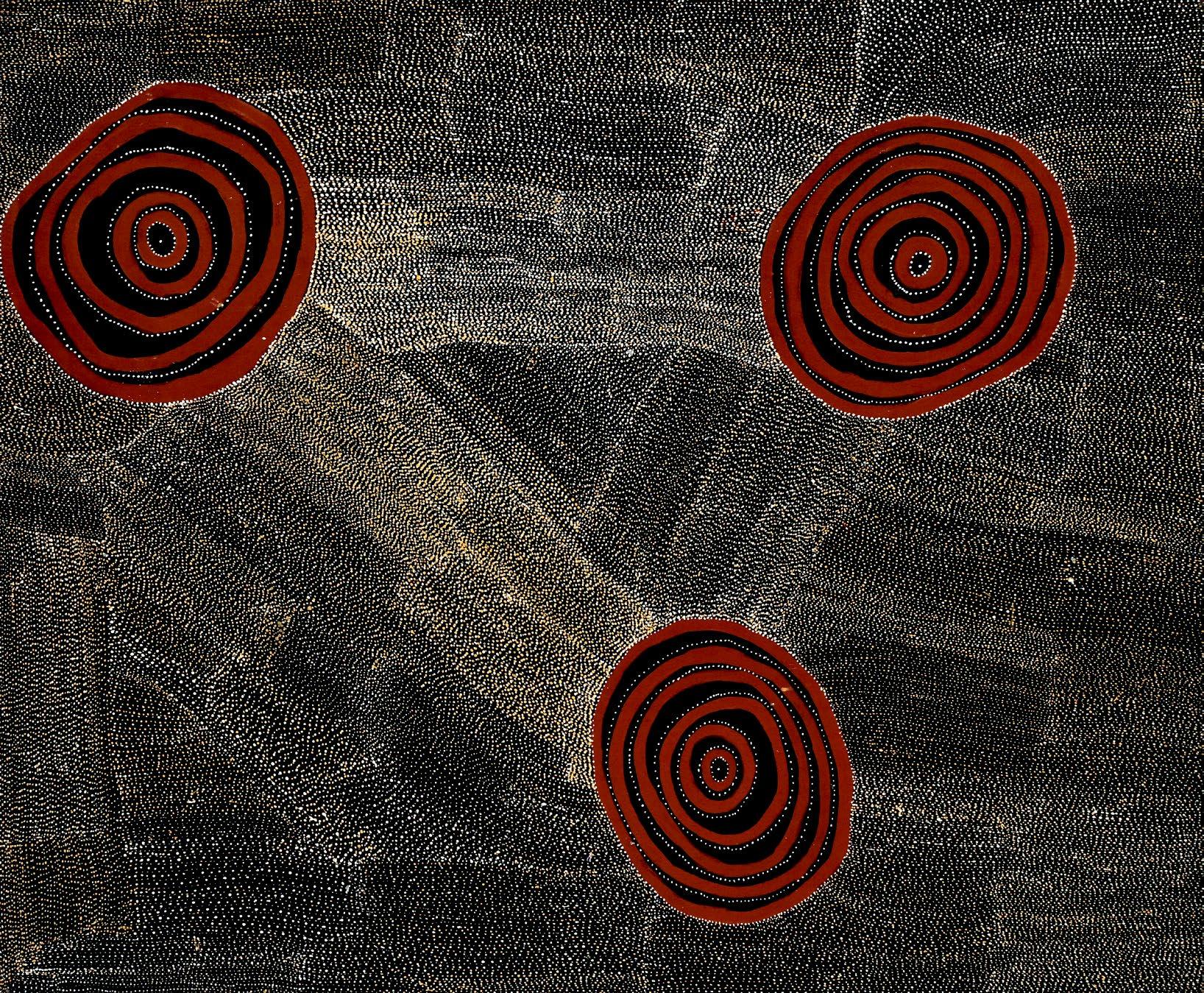
35
ROVER JOOLAMA THOMAS (1926 - 1998)
BULLOCK HIDE STORY, 1995 128 x 196 cm natural earth pigments on Belgian linen
EST $50,000 - 70,000
Utopia Art, NSW
Songlines, Amsterdam, Netherlands Private Collection, Netherlands Lawson~Menzies, Sydney, NSW, June 2008, Lot No. 254 Menzies Estate Collection, Vic
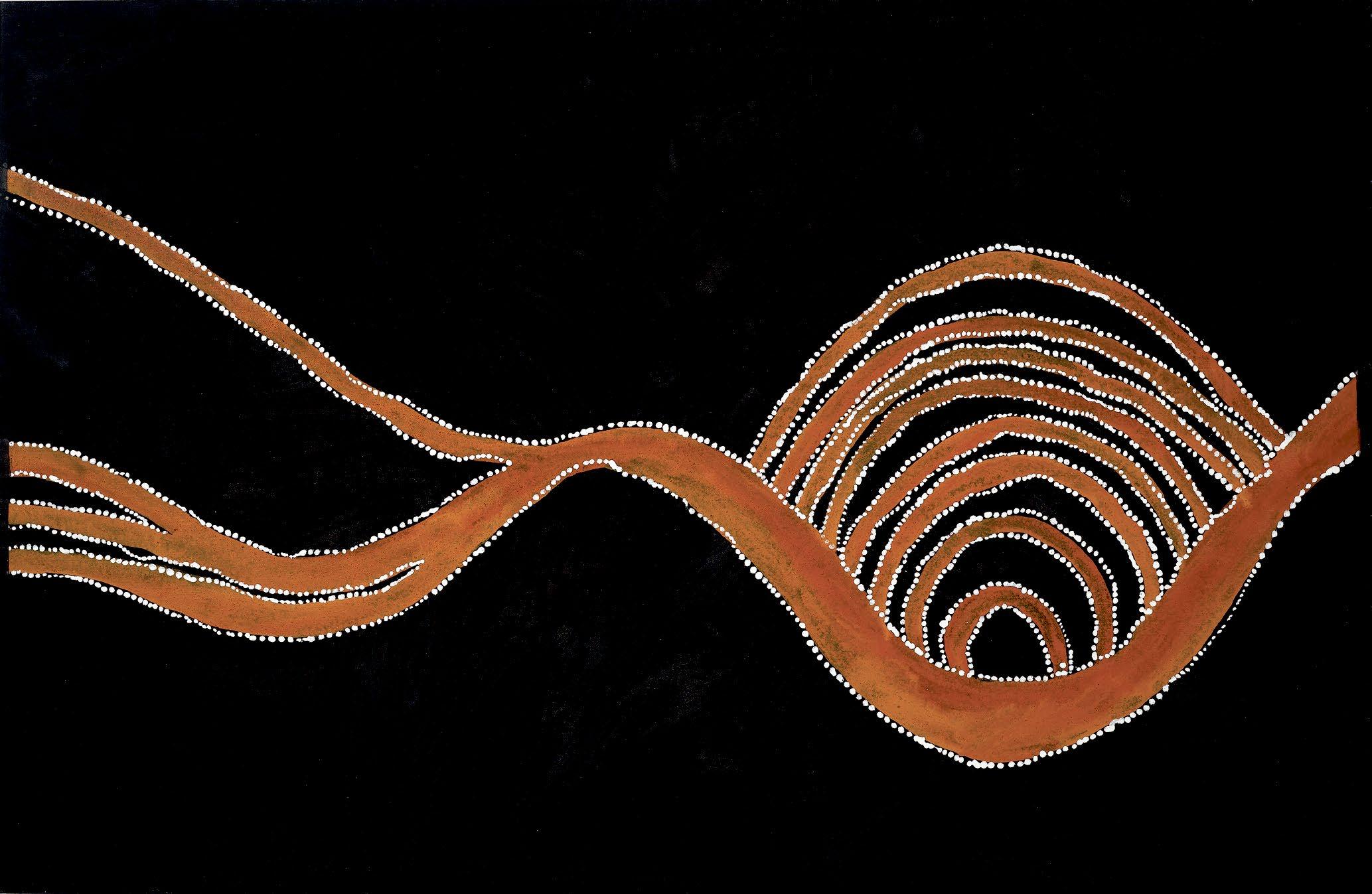
Rover Thomas began working as a stockman at 10 years of age and spent the following 40 years droving cattle. During this time, he travelled over vast tracts of the interior landscape including several years in the Northern Territory, later returning to work again in Western Australia.
This work refers to the massacre of Indigenous people at Horseshoe Creek on Texas Downs Station during the early European settlement of the area. This was one of the twelve major sites on which Aboriginal people were killed within a 150-kilometre radius of Turkey Creek. Others included Ruby Plains and Bedford Downs Station. Such massacres were the inevitable results of the clash between European and Aboriginal cultures.
This work was painted three years before Rover Thomas died. Painted in natural earth pigments, the drama of the content is evoked through the powerful contrast between the mysterious emptiness of the charcoal background and its floating graphic overlay, energised by mustard shades of yellow which give symbolic depiction to the landscape and its history.The intensely striped section delineated by white dots portrays the hillside. The meandering lines indicate the direction of the flow of Horseshoe Creek.
© Marie GiesslerBIG MOB, 2007 208 x 222 cm synthetic polymer paint and earth pigments on canvas

EST $6,000 - 8,000
Neil McLeod Fine Arts Studio, Vic, Cat No. NM 1797 Lawson~Menzies, Colonial to Contemporary, including Important Aboriginal Art, Sydney, NSW, June 2009, Lot No. 186 Menzies Estate Collection, Vic
Accompanied by a certificate of authenticity from Neil McLeod Fine Arts Studio, one photo of the artist creating the work, and one photo of the artist with the work.
As one of the last of the dwindling generation of old men who possessed complete knowledge of the rituals, law, and culture of his people, Jack Dale was a vital link to the past. A custodian of ancient stories about the land and its creation, he devoted his most compelling and mysterious works to the Wandjina and other important spirit beings that created the land and instituted the laws that govern human behaviour.
Wandjinas are powerful fertility spirits, responsible for the life-giving monsoon rains. Jack depicted these spirits in a distinctive style: ghost like, with halos, large, pool-like eyes, and without mouths, for, according to Dale, giving them a mouth would mean the heavens would open and the rain would never cease. Many Wandjina sites, located throughout the Kimberley, are over 60,000 years old and are painted on rock overhangs, often marked by striking geological features like the Djalala or ‘marking stones’ that indicate their presence.
JACK BRITTEN (c.1921 - 2001)
KOONDOOKA (TWO PICANINNYS), 1996
119.5 x 150 cm; 121.5 x 152 (framed) synthetic polymer paint on canvas
EST $4,000 - 6,000
PROVENANCE
Warmun Traditional Artists, WA Cat No. JB0016
Lauraine Diggins Fine Art, Vic Cat No. 230121
Lawson~Menzies, Sydney, NSW, 31 May 2005, Lot No. 43
Menzies Estate Collection, Vic
EXHIBITED
St. George’s Square, WA, Cat No. 19
Annual Collectors Exhibition 2003, Lauraine Diggins Fine Art, Melbourne, 6 September - 5 October 2003, Cat No. 61
Jack Britten was born and spent his childhood at Tickelara Station, in the north-west of Australia, at a time when many Gija people were massacred during the gold rush at Hall’s Creek and Chinaman’s Garden in the East Kimberley region. He was the traditional owner of the Bungle Bungle ranges.
This painting depicts Jack’s Dreamtime story of two piccaninnys who were lost in the rainbow, Koolabba, over the Bungle Bungles. The children are shown with the rainbow at the centre of the painting. Their mother went looking for them through the palm trees by the Ord River depicted at the bottom of the work.
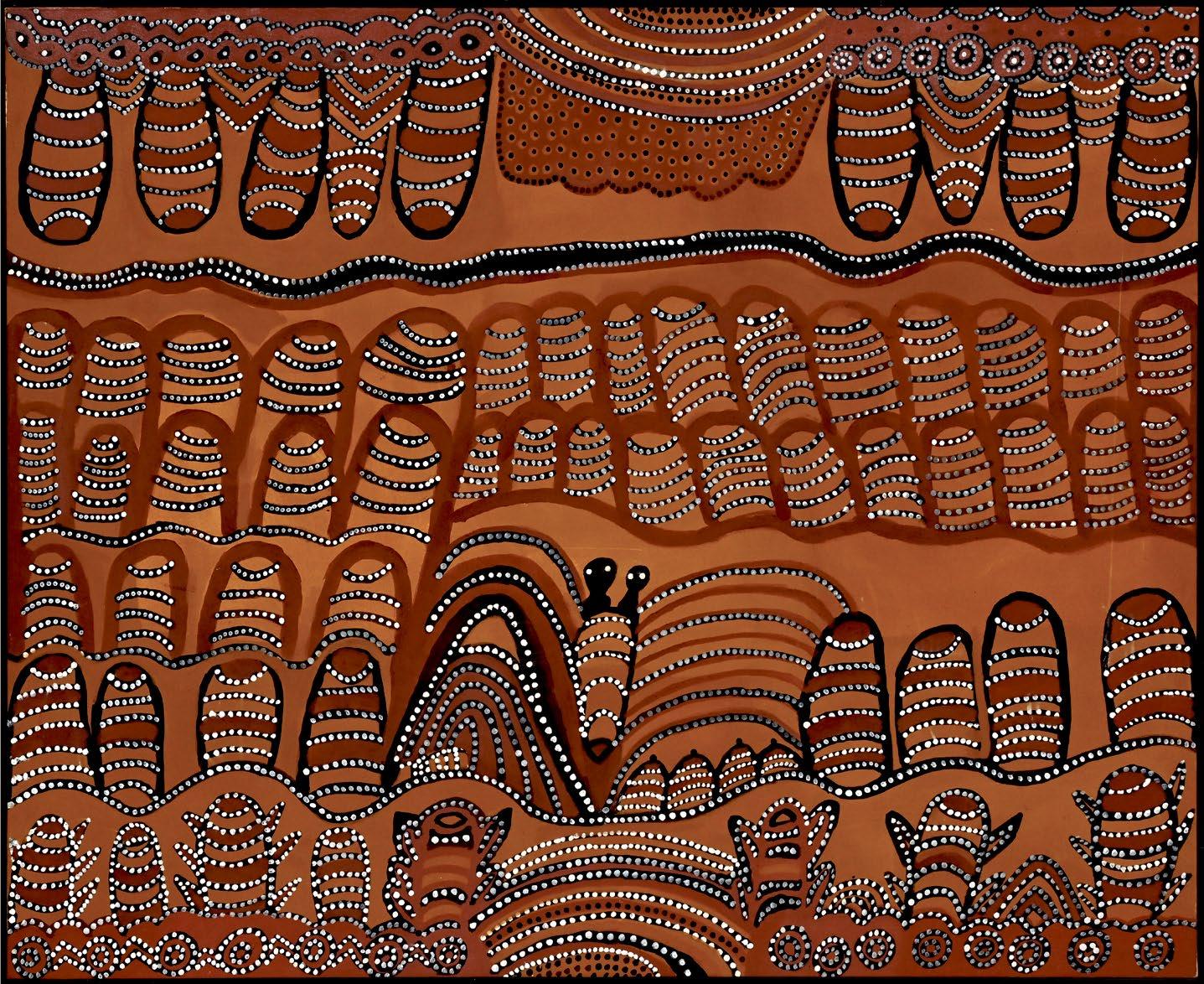
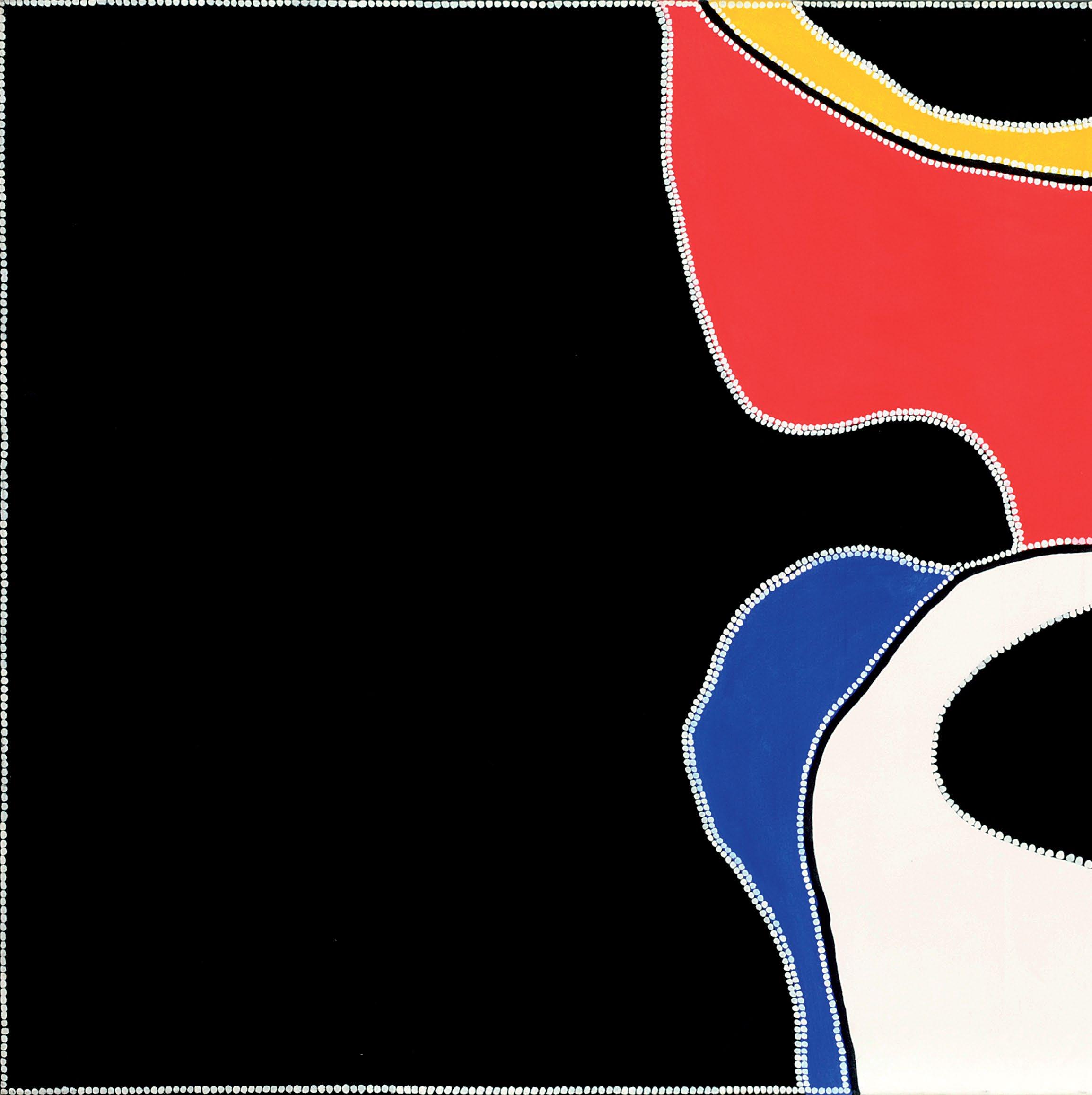
38
FREDDIE TIMMS (1946 - 2017)
BLOODWOOD YARD, LISSADEL COUNTRY, 1996
121.5 x 183.0 cm natural earth pigments on Belgian linen
EST $8,000 - 12,000
Kimberley Art, Vic, Cat No. KA 00123 Private Collection, Vic Lawson~Menzies, Sydney, NSW, 30 May 2006, Lot No. 7 Menzies Estate Collection, Vic
Accompanied by a certificate of authenticity from Kimberley Australian Aboriginal Art.
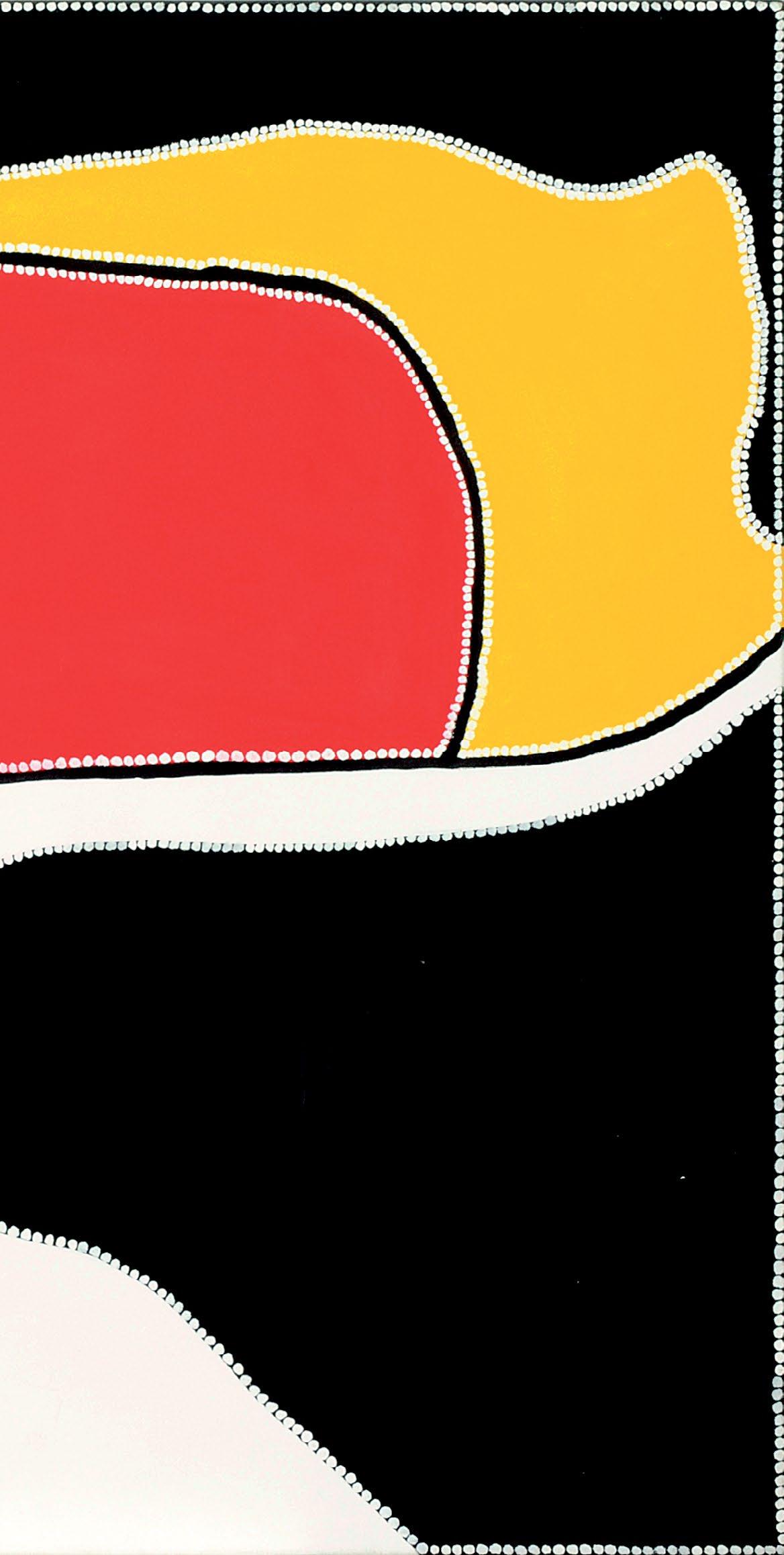
Freddie Timms was born on Bedford Downs Station south west of Turkey Greek and spent his childhood at Bow River and Lissadell Stations where he worked as a stockman, handyman, and fencer. He met and worked with Rover Thomas on Bow River and Texas Downs and participated in the dancing and preparation of boards for the early song and dance performances of Rover’s Krill Krill.
Freddie painted for Waringarri Arts from the late 1980s developing his own personal style working exclusively with earth pigment until the mid 1990s when he began experimenting with colour. His more vivid interpretations of his country were first exhibited with Frank Watters in Sydney, and later Rob Gould in Melbourne. His works are maps of his country imbued with its history and spiritual connections.They are typified by expanses of flat colour delineated by white dotting, according to topography and geology. Included are the black soil country, hills, creeks, watercourses and waterholes, roads, stockyards, homesteads and dreaming places of his travels.
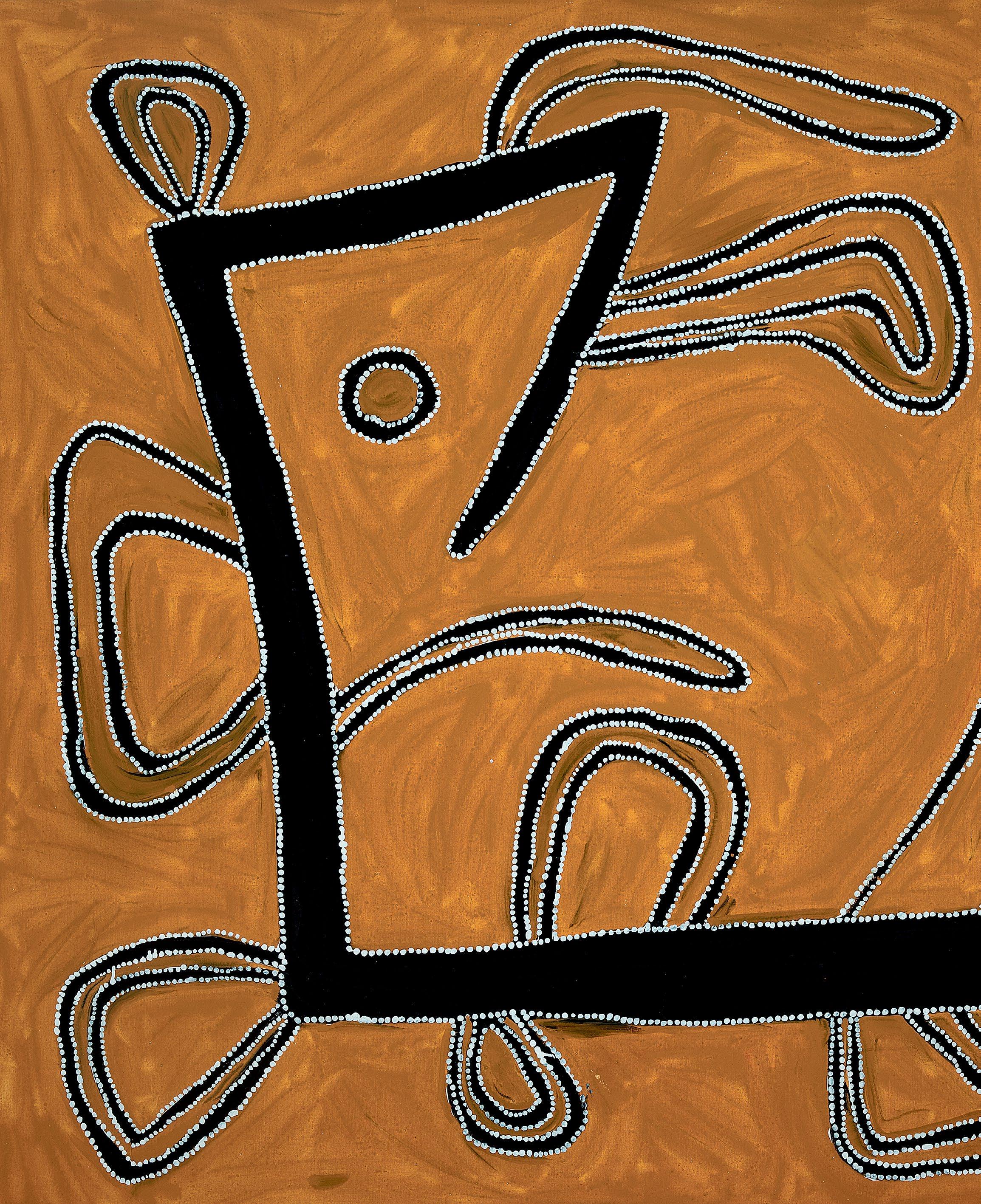
ROVER JOOLAMA THOMAS (1926 - 1998)
CYCLONE TRACY - WILLY WILLY, 1995
182.5 x 181 cm; 190.5 x 189 cm (framed) natural earth pigments on Belgian linen
EST $80,000 - 120,000
PROVENANCE
Neil McLeod Fine Art, Vic Private Collection, Vic Lawson~Menzies, Sydney, NSW, November 2007, Lot No. 50 Menzies Estate Collection, Vic
Rover settled at Warmun in 1973, the year before Cyclone Tracy laid waste to Darwin. On the morning of Christmas Eve 1974, the cyclone moved directly over Darwin with wind gusts reaching 240 kilometres per hour. Ninety percent of homes were destroyed or badly damaged, and over sixtyfive lives were lost. It was the inspiration for this striking and dramatic work. The fearsome winds started from the direction of Darwin harbour, flattened all buildings and trees in the city, moved across the Kimberley’s and finally ran out at Port Headland on the West Australian coast.
This important work was created during Rover’s extremely well documented visit to Melbourne in June 1995. It is characterised by spacious planes of textured ochre. The prominent black path is a storm travelling from the east. It gains in strength as the Willy Willys fuse together to create a frightening wind tearing through the Great Sandy Desert. The concentric circle represents the artist’s encampment. The white dots serve only to create emphasis or to draw the eye along pathways of time and movement, following the forms of the land. The painting is dynamic yet contemplative and sombre. The predominant use of black conveys a startling, strangely emotional, intensity. The viewer observes the unfolding events whilst becoming immersed in an ancient and timeless landscape.
Rover Thomas died on April 11, 1998, and was posthumously awarded an honorary doctorate from the University of Western Australia. The power of his work is reflected in the attention it commanded over his twentyyear career. Since his first exhibition in 1987, there has been a constant demand for his paintings, which are now represented in all major galleries in Australia. He is recognised as one of the most important figures in contemporary Australian Aboriginal Art. His legacy is a substantial body of significant paintings which provide an enduring, unique, insight into the spiritual landscape of the Kimberley region and the human relationships and events within it.


EMILY KAME KNGWARREYE (1910 - 1996)
MY COUNTRY, 1994
211 x 151 cm; 214.5 x 154.5 cm (framed) synthetic polymer paint on canvas
EST $120,000 - 140,000
PROVENANCE
Aboriginal Gallery of Dreamings, VIC Cat No. AGOD/ 4150 Private Collection, Vic Deutscher-Menzies, Sydney, NSW, September 2007, Lot No. 44 Menzies Estate Collection, Vic Accompanied by a certificate of authenticity from Aboriginal Gallery of Dreamings
EXHIBITED
Emily Kngwarreye Paintings, Oude Kerk, Amsterdam, 1999
Emily Kame Kngwarreye began painting at the age of seventy-nine and in just eight years completed no fewer than four thousand works of art. Her artistic achievement, miraculous in its strength and powerful appeal, owes much to the inspiration of Indigenous spirituality and the magical creation stories that underpin its belief systems.
Her first paintings, created in 1989, were characterised by finely dotted surfaces painted over intimate traditional symbols and linear tracing. As her work progressed, any evidence of under-painting disappeared beneath increasingly gestural fields created by employing larger and larger brushes. By the mid-1990s, the runnels of dotted colour across the surfaces of her more abstract works began to be more formally arranged in parallel lines, as in this particularly magnificent work of the period which was exhibited in her first international solo exhibition at the Oude Kerk, Amsterdam in 1999, opened by Simon Levie, Director of the Rijks Museum.
By the time she passed away on September 2nd, 1996, her fame had achieved mythic status. Emily was an artistic superstar, the highest-paid woman in the country who had left one of the most significant artistic legacies of our time. Emily Kngwarreye was one of Australia’s’ three representative artists at the Venice Biennale in 1997, the year following her death, and the subject of a touring retrospective exhibition mounted by Margo Neale for the Queensland Art Gallery. A retrospective exhibition ‘Utopia: The genius of Emily Kngwarreye’ was presented by the National Museum of Australia and toured Japan in 2008. The sale of her masterwork ‘Earth’s Creation I’(1995) by CooeeArt Marketplace in 2017 for $2.1 million, stands as the record price paid at auction for any work of art by an Australian female artist.
JUDY NAPANGARDI WATSON (c.1925 - 2016)
MINA MINA (CEREMONY), 2007 120 x 180 cm synthetic polymer paint on Belgian linen
EST $4,000 - 6,000
PROVENANCE
Centre for Indigenous Support in Art and Culture Cat No. CISAC #0012 Private Collection, NSW
Lawson~Menzies Important Aboriginal Art, Sydney, NSW, October 2008, Lot No. 205 Menzies Estate Collection, Vic
Accompanied by certificate of authenticity from Centre for Indigenous Support in Art and Culture
Cf. for a similar work see Christine Nicholls, The Three Napangardi’s, To the memory of Maggie Napangardi Watson in Ryan,J; (ed.) Colour Power-Aboriginal Art Post 1984, National Gallery of Victoria, 2004, pp123-125 and p.33 illus.
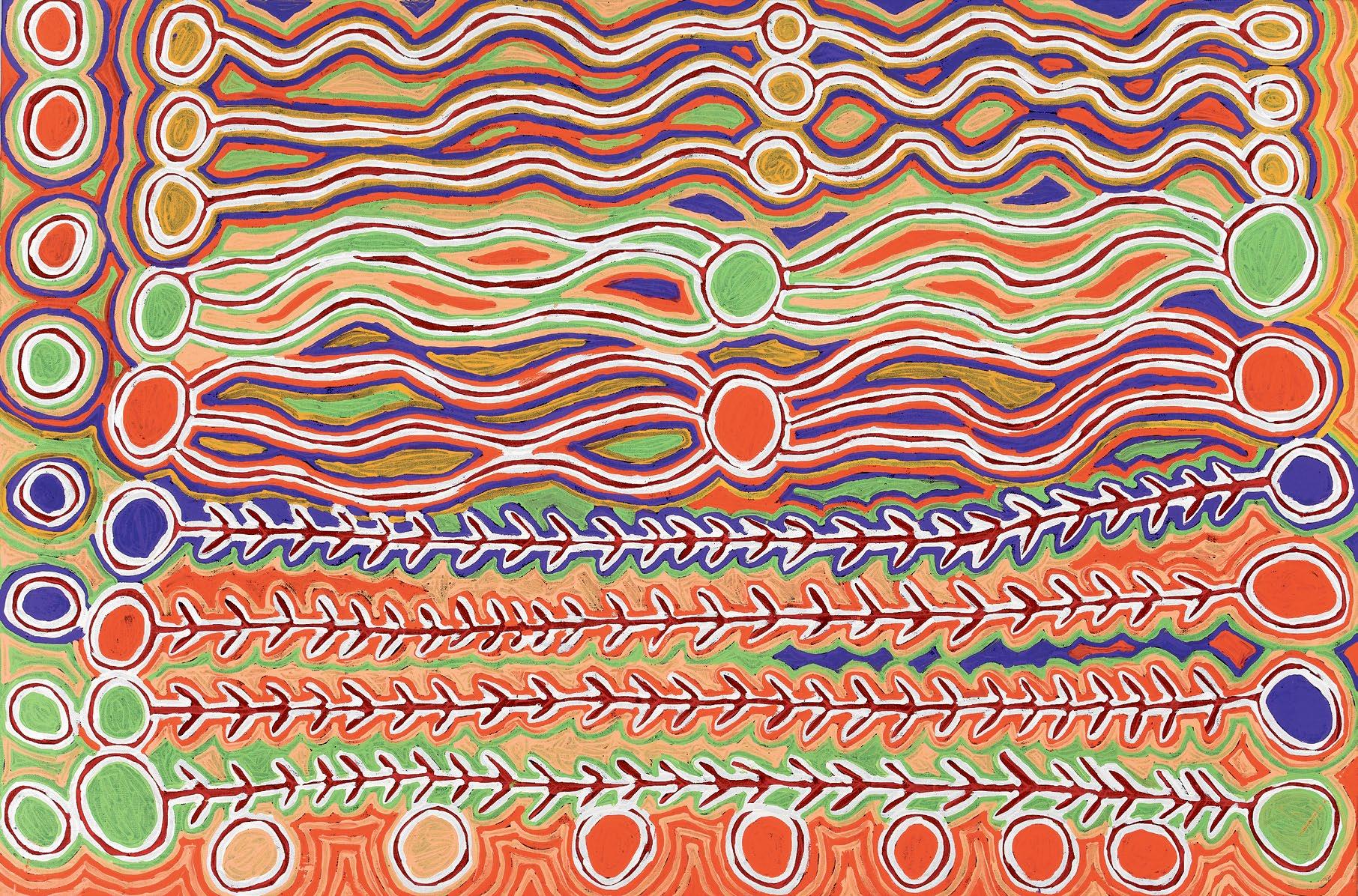
Born on Mt. Doreen Station, north west of Alice Springs, Judy Watson grew up in the vast Warlpiri country that lies between the Tanami and Gibson deserts.
From the beginning of her painting career her focus was the Women’s Dreaming of the Karnta-kurlangu – a large number of ancestral women who danced across the land, creating important sites, discovering plants, foods, and medicines, as well as establishing the ceremonies that would perpetuate their generative powers.
At Mina Mina, these ancestral women danced and performed ceremonies before travelling to Janyinki and other sites as they moved east toward Alcoota. During their ritual dancing, digging sticks rose up out of the ground and the women carried these implements with them on their long journey east singing and dancing all the way, with no sleep.
The hairstring is anointed with red ochre and is a secret and sacred connection between the women’s ceremony and the country, which enables them to connect with the spirit of the Dreaming. In this work, the rippling surface, painted in the artist’s distinct ‘dragged’ dotting style mimics the dance of her ancestors across the country during its creation.
TURKEY TOLSON TJUPURRULA (1942 - 2001)
SPEAR STRAIGHTENING, 1995 125 x 199 cm synthetic polymer paint on Belgian linen
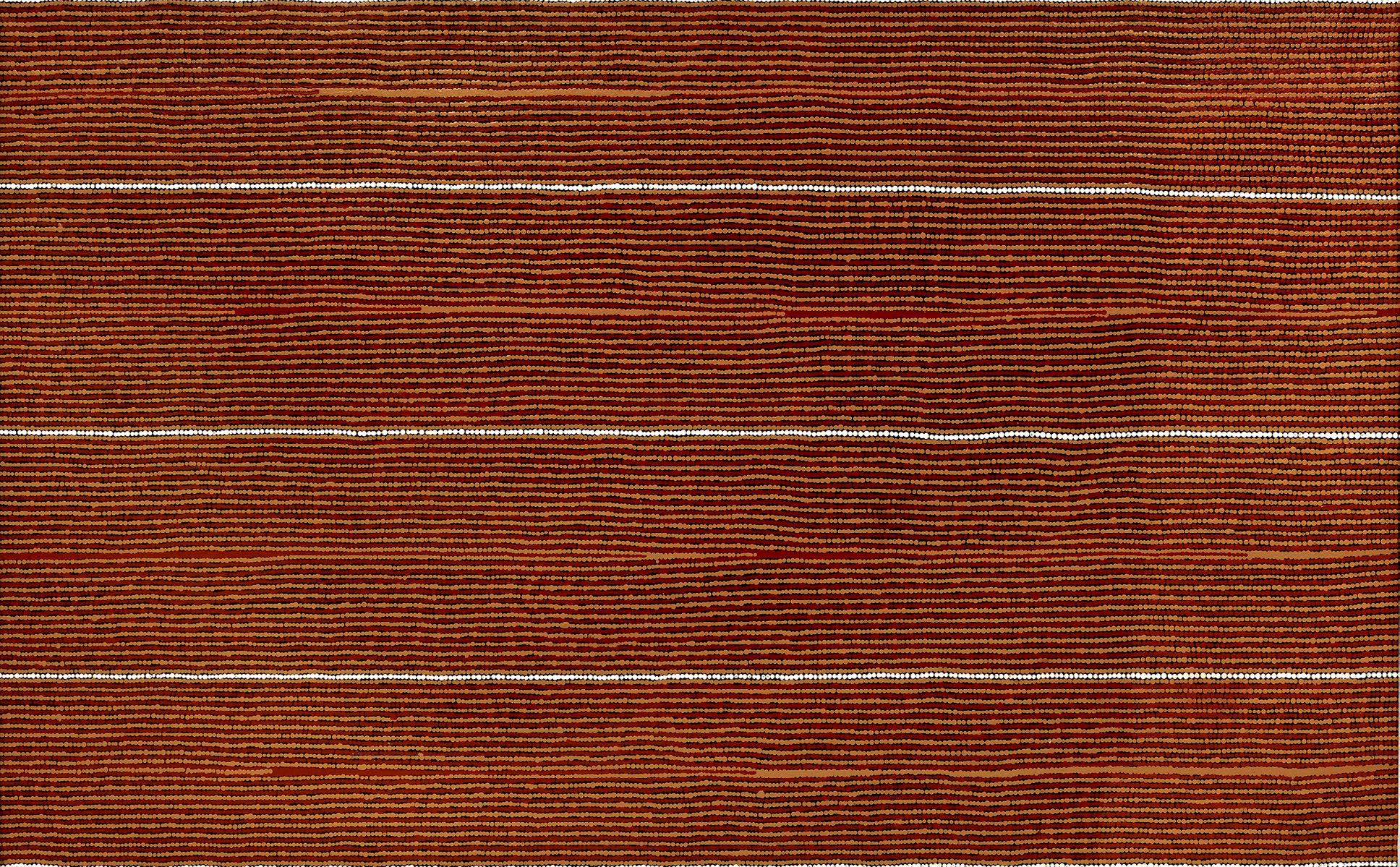
EST $18,000 - 25,000
PROVENANCE
The Arthur Papadimitriou Collection, Vic Cat No. AP7116236
Lawson~Menzies, Sydney, NSW, November 2007, Lot No. 64 Menzies Estate Collection, Vic
EXHIBITED
“Desert Dreaming: The Arthur Papadimitriou Collection”, Benalla Art Gallery, Victoria, 15 December 2001 - 28 February 2003
In this magnificent example of Turkey Tolson’s Spear Straightening imagery, the horizontal bands of dots change colour subtly evoking the shimmering heat of the fire and the vast distances of the artist’s desert country. Within this powerful work lies the deep knowledge of a fully initiated man who has imbued it with the spirit of his ancestors and their important stories.
In the Dreaming, the Mitukatjirri Men, travelled from a claypan at Tjulula to Ilyingaungau, a rocky outcrop far to the west of Alice Springs, where they made camp. At this time a group of men entered the country from Tjikari, to the north. A fight ensued after which the Mitukatjarri Men travelled to the nearby cave where they made their ceremonies. The parallel bands represent spears, which the men straightened by warming the wood over a fire, bending it into shape as they waited for the men from Tjikari to arrive.
This work was one of two collected by Arthur Papadimitriou OAM, who befriended the artist while teaching at Watiyawanu Primary School between 1994-1996. Its’ companion piece is in the collection of the Musée du quai Branly in Paris.
ROVER JOOLAMA THOMAS (1926 - 1998)
WATI KUTJARRA AREA, 1995
178 x 100 cm
natural earth pigments on Belgian linen
EST $40,000 - 60,000
PROVENANCE
Flinders Lane Gallery, Vic Private Collection, Vic Lawson~Menzies, Sydney, NSW, May 2007, Lot No. 64 Menzies Estate Collection, Vic
Accompanied by a certificate of authenticity from Flinders Lane Gallery
Born in the Great Sandy Desert of Western Australia, Thomas spent his early life droving cattle ,until at 48 years of age he settled in the East Kimberley. Following Cylone Tracy in 1974, he devised a ceremony during which dancers held up painted boards across their shoulders to enhance the narrative.
Thomas’s work, along with boards painted by his ‘uncle’ Paddy Jaminji began to appear in galleries in Perth and other cities from around 1983 onward. Later, Queenie McKenzie, Hector Jandany, Freddie Timms and others joined them painting in what became known as the ‘East Kimberley’ style employing ochre fields of brown, black or yellow, (ADD) surrounded by white dotting to depict the landscape from an omnipotent perspective. This technique recalled the traditional method of delineating a ceremonial place by outlining its form with balls of Spinifex down.
The Wati Kutjarra Tjukurrpa (Two Goanna Men Dreaming) mythology relates to the offence of moral laws by a debauched old man and the revenge and retribution enacted by his two sons. The two brothers, who became Dreaming ancestors, travelled across the desert country and in doing so created natural landforms and sacred sites by leaving their presence at places they visited.
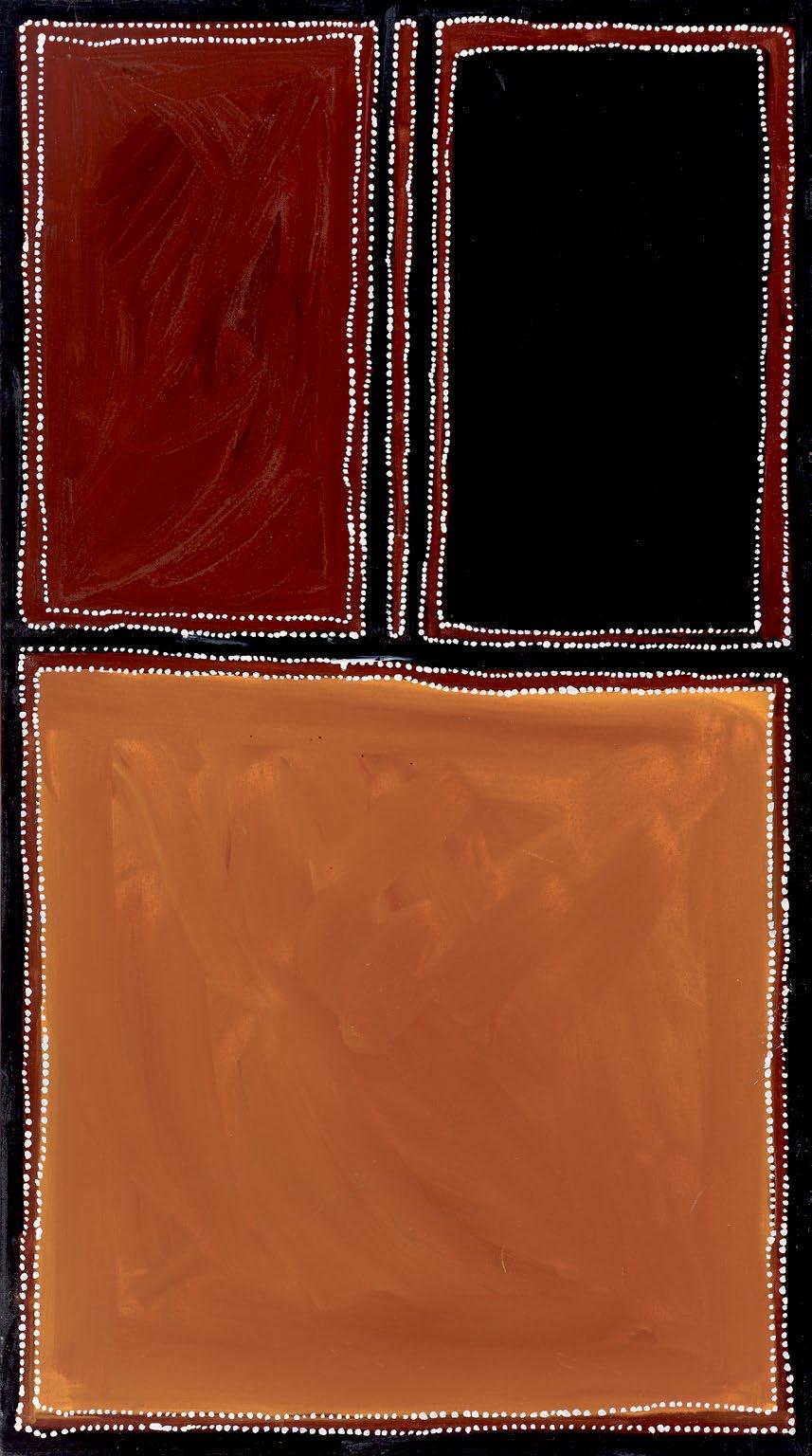
UNTITLED - TEXAS DOWNS, 1997
80 x 160 cm; 83.5 x 163.5 (framed) natural earth pigments on canvas
EST $18,000 - 22,000
PROVENANCE
Warringarri Arts, WA Cat No. AP0097 Private Collection, Vic Lawson~Menzies, Sydney, NSW, 9 November 2005, Lot No. 128 Menzies Estate Collection, Vic
Churchill Cann was born on Texas Downs Station where his father was a stockman and his mother worked in the homestead. He spent most of his working life on Texas as a stockman and horse-breaker, mustering and driving cattle across to the abattoirs at Wyndham. While still a teenager, he worked alongside his father and uncle and their contemporaries Rover Thomas and Queenie McKenzie. Living on country, working cattle in the saddle out bush, Churchill absorbed knowledge about Dreaming stories, traditional healing practices, and sites of special cultural significance from his Elders. From his uncle and grandfather, he learned to make artefacts, repair them with sugarbag wax, prepare kangaroo sinew, and straighten bamboo spears before decorating them with traditional designs.
He began painting in the early 1990s, and first became conspicuous as an artist in 1994 when he was a finalist in the Heritage Art Award at Old Parliament House in Canberra.
In 1997, while working in Kununurra at the Warringarri art centre he collaborated with Rover and Queenie on this singular work, which explores the terrain and significant sites on Texas Downs Station. Here Dinner Creek flows into the Ord River, and Blackfella Creek weaves its way between the hills, sandhills, and black soil plains.

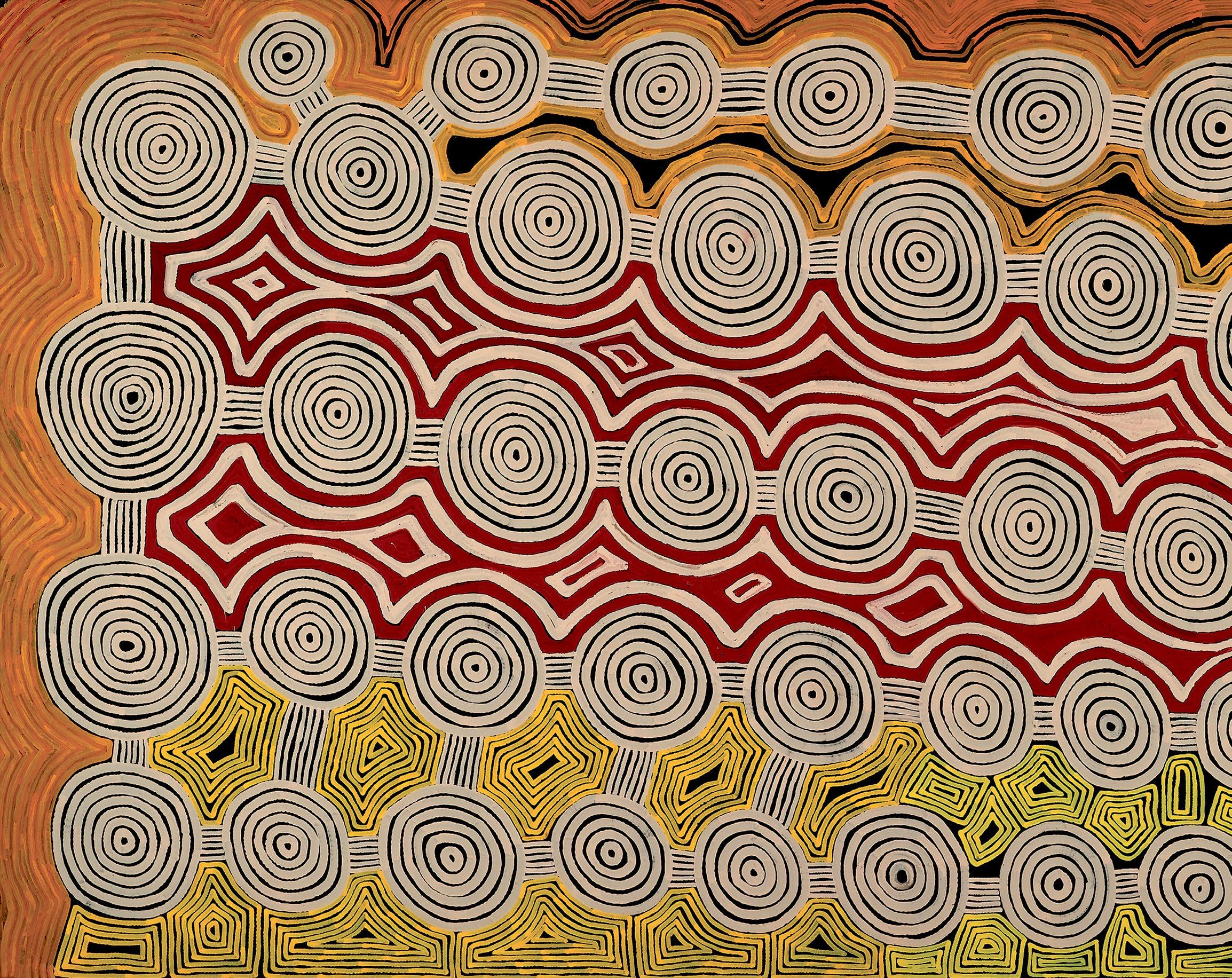
KUMPURALGNA, 1996
187 x 360 cm synthetic polymer paint on Belgian linen
EST $25,000 - 35,000
PROVENANCE
Yapa Art Alice Springs, NT Private Collection, Vic Lawson~Menzies, Sydney, NSW, 23 May 2007, Lot No. 84 Menzies Estate Collection, Vic
In this monumental work, Pintupi artist Ronnie Tjampitjinpa depicts Kampuralagna, an area east of Kintore, close to the Northern Territory and Western Australian border, to which he has links through his father.
In this work, the Tjampitjinpa’s creative genius lies in combining several different traditional ways of depicting important men’s Dreaming sites in a single innovative stylistic format. It imparts the feeling of departure or movement from a particular site onward, through the country, after a period spent sojourning in a particular location for some time.
By referring to the designs originally incised on ceremonial objects, Ronnie Tjampitjinpa was foremost amongst those artists who advanced the perception of male Pintupi art during the 1990s. The technique and the mood he created by manipulating space allowed him to command a greater scale of painting - a feature of his commissioned works post 1999. However as big pictures they remain uncompromising. His mastery of design principles, often using just two or three colours with core iconic symbols, retains a purity that set him apart from his peers.
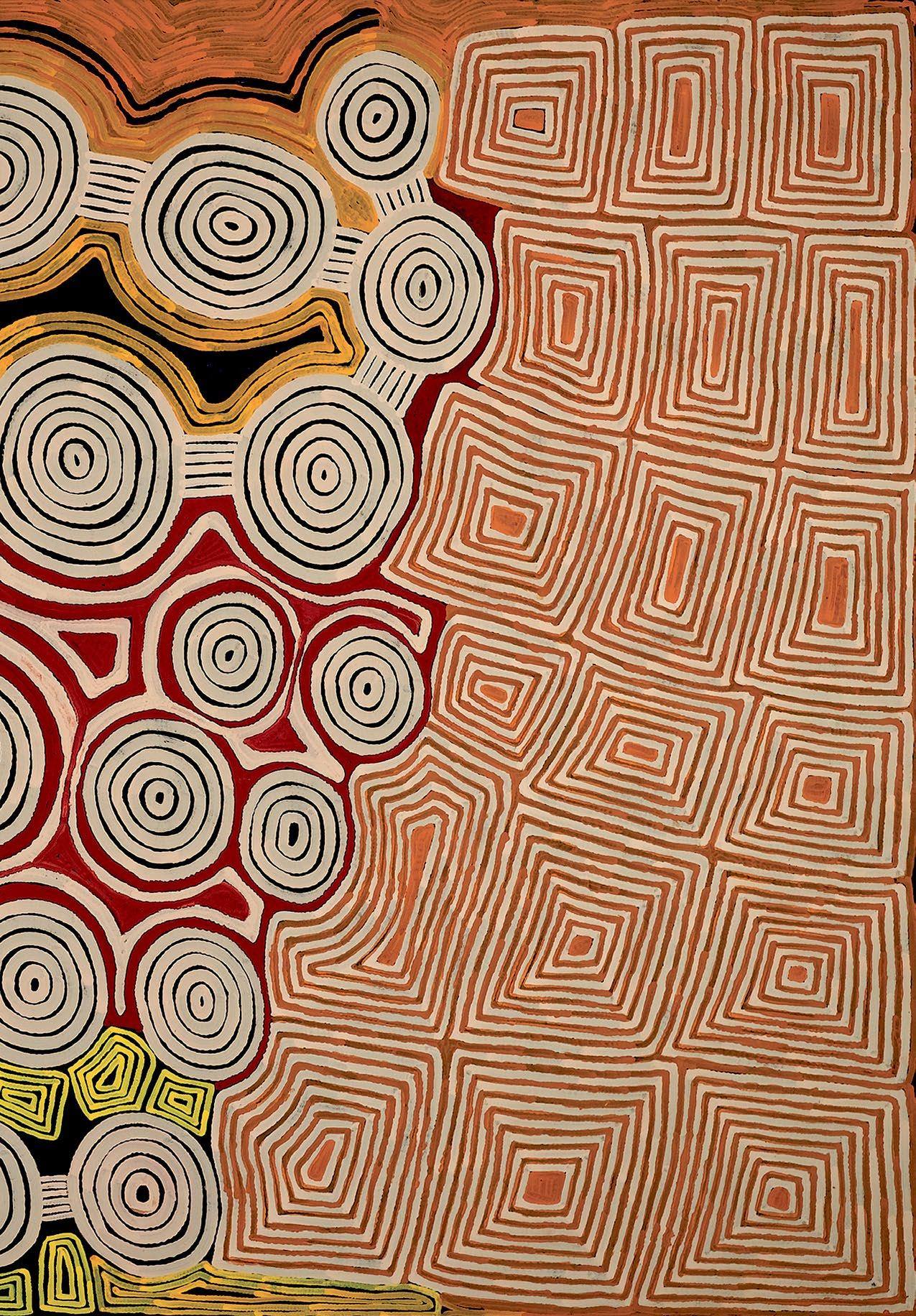
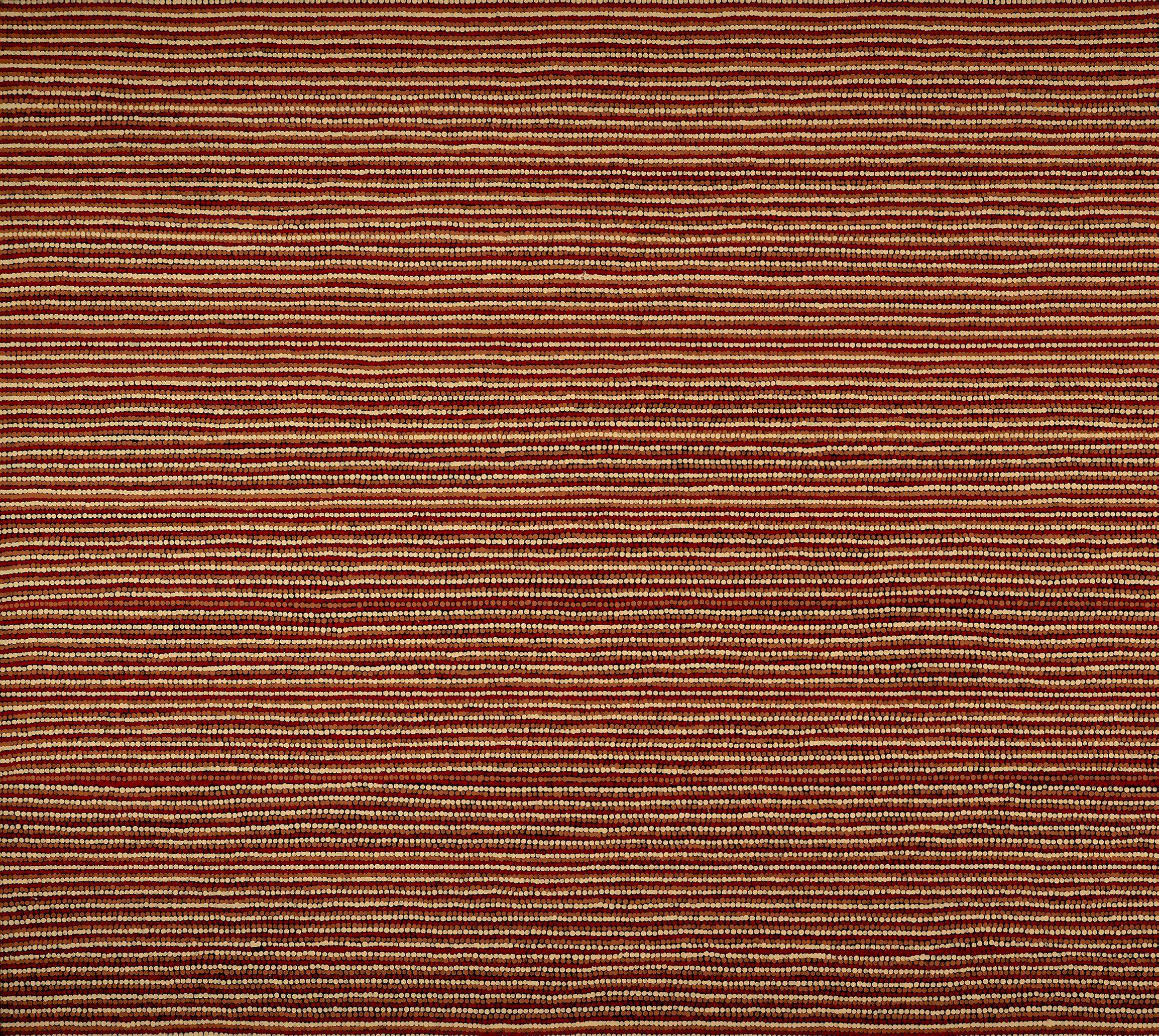
46
TURKEY TOLSON TJUPURRULA (1942 - 2001)
SPEAR STRAIGHTENING, 1997
211 x 364.5 cm synthetic polymer paint on Belgian linen
EST $25,000 - 35,000
PROVENANCE
Kimberley Art, VIC Cat No. KATT 004/97 Private Collection, Vic Lawson~Menzies, Important Aboriginal Art, Sydney, NSW, March 2008, Lot No. 229 Menzies Estate Collection, Vic
Accompanied by a certificate from Kimberley Art and folio of 32 photographs of the artist creating the work
Turkey Tolson was one of the most innovative artists of the Papunya Tula movement. While his early works explored traditional Tingari imagery he was notable for venturing towards more painterly works during the 1980s. These coupled narrative and geographic iconography with an accentuated focus on the intersection of line, colour and texture. His command of abstraction allowed him to convey the vibrant presence of the living desert along with its mysterious underlay of ancestral power. The art world responded enthusiastically to Tolson’s artistic versatility and desire to experiment. He travelled to Paris with Joseph Jurra Tjapaltjarri to create a sand painting as part of the ‘Peintres Aborigines d’Australie exhibition in 1987 and participated in artists residencies away from his beloved homelands and during the early 1990s. In his role as the Chairman of Papunya Tula Artists (1985-95) he proved an effective intermediary between many of the older artists and nonindigenous art buyers and writers at the time.
Turkey Tolson’s emblematic Straightening the Spears at Ilyinggaungau, paintings were amongst of the most influential artworks of the Papunya movement during the 1990s. Composed of parallel lines of alternating colour, their slight irregularities give a nuanced effect that evokes the creative play of light and shade and the shimmering heat of the desert.
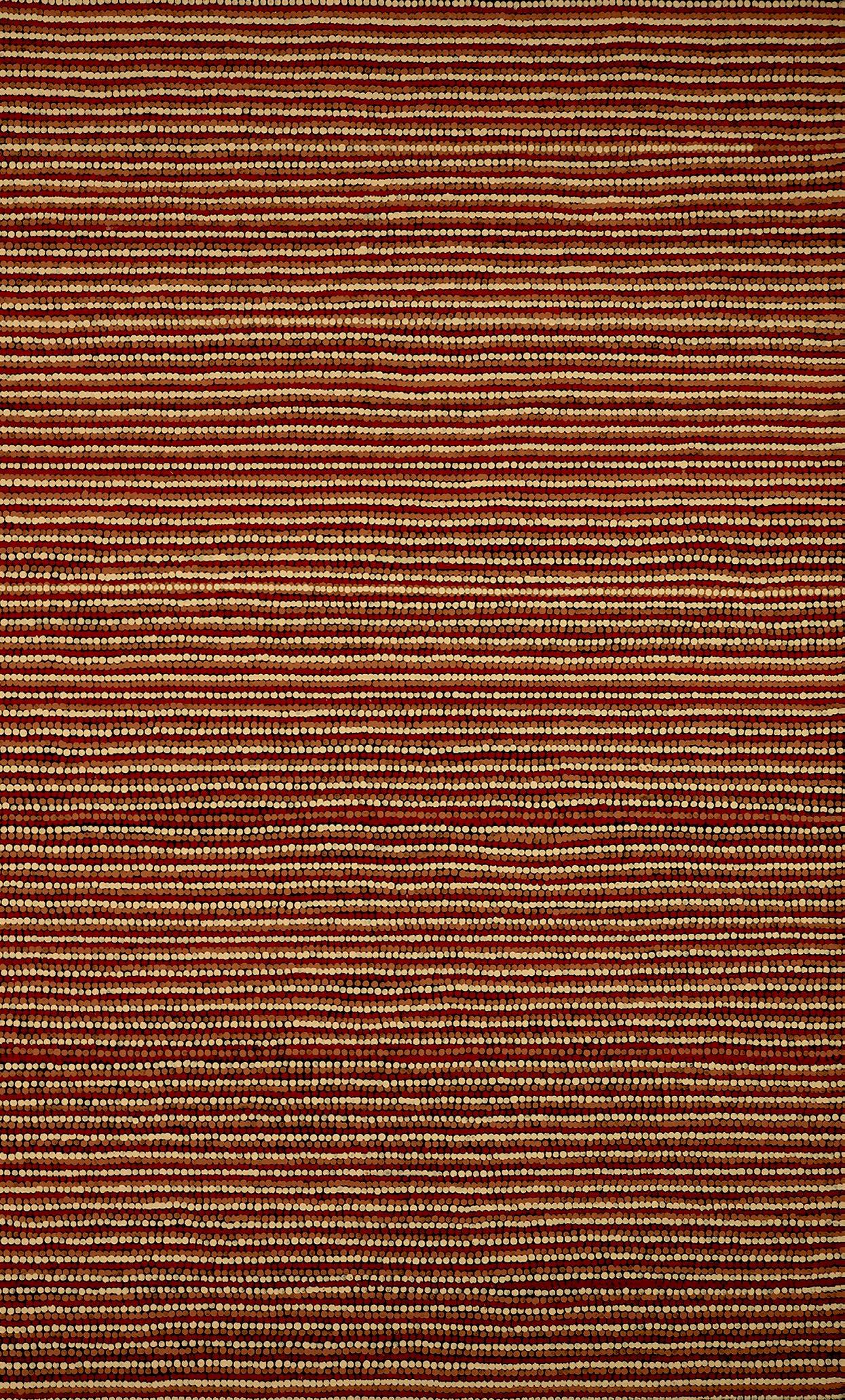
EMILY KAME KNGWARREYE (1910 - 1996)
ALHAKERE - MY COUNTRY, 1994 131 x 231 cm synthetic polymer paint on canvas
EST $30,000 - 40,000
PROVENANCE
Jinta Desert Art, NSW Cat No. SN-251 Private Collection, NSW
Lawson~Menzies, Sydney, NSW, May 2007, Lot No. 114 Menzies Estate Collection, Vic
Accompanied by certificate of authenticity from Jinta Desert Art
Cf. for related works see: Emily Kngwarreye Paintings, Craftsman House, 1998, pp 117-121, Pl. 46-50.
Emily Kame Kngwarreye, Alhalkere Paintings from Utopia, Margo Neale, Queensland Art Gallery, 1998, pp 114 Pl. 72
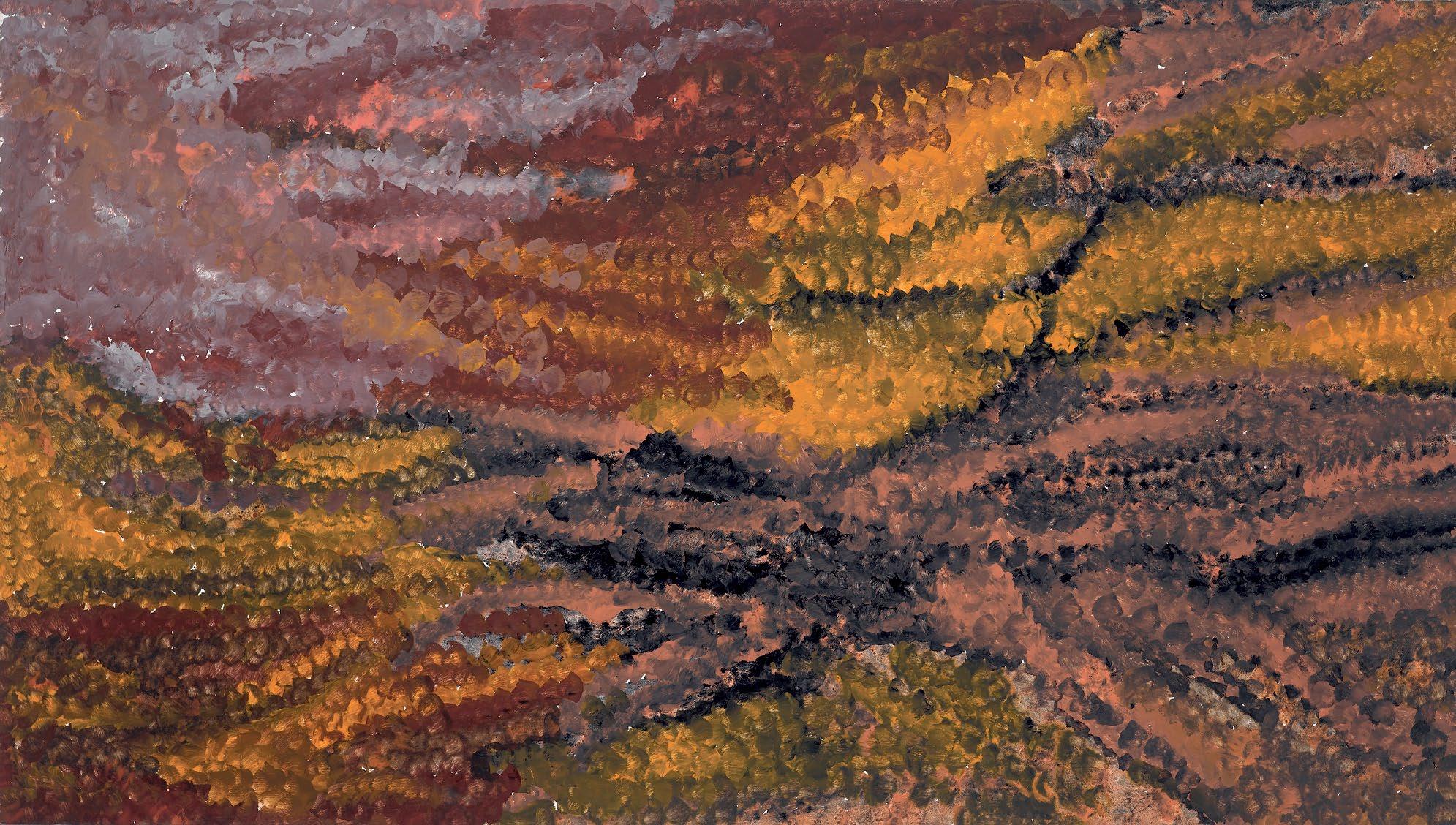
Emily Kgwarreye produced paintings constantly throughout the last eight years of her life, and while she was always happy to go back and produce a work from an earlier stylistic period, a chronological walk through her paintings reveals a line of development that connects them all.
Her early style featured visible linear tracings following the tracks of the Kame (Yam) and animal prints with fields of fine dots partially obscuring symbolic elements and playing across the canvas’s surface. By 1992, her fine dotting and symbolic under-painting gave way to works in which symbols and tracks were increasingly concealed beneath a sea of dots until eventually, they were no longer evident at all. She began using larger brushes to create lines of dots that ran across vibrantly coloured surfaces.
Later Emily’s paintings became more and more structured, as she moved away from depicting country as cloud-like amorphous colour fields. She began applying paint in colourful tracks across the surface of the works rather than underneath as she had prior to 1993. Paintings of this period can be seen as a transition toward her ‘line’ paintings that began to emerge the following year.
In this painting, Emily has represented a vast area of her country. We can see ochre pits and areas of the burnt Spinifex grass that regularly scars the landscape, as well as the arteries of old creek beds that flow with the coming of summer rains.
CLIFFORD POSSUM TJAPALTJARRI (1932 - 2002)

ROCK WALLABY AND POSSUM DREAMING, 1996 118 x 149 cm synthetic polymer paint on Belgian linen
EST $25,000 - 35,000
PROVENANCE
Commissioned by Des Rogers, Vic Cat No CPT/DR211 Private Collection, Vic Deutscher-Menzies, Melbourne, Vic, June 1999, Lot No. 212 Menzies Estate Collection, Vic
Cf. ‘The Art of Clifford Possum’, Craftsman House, Vivien Johnson, 1994 and ‘Clifford Possum Tjapaltjarri’, Vivien Johnson, Art Gallery of South Australia, 2003
The iconography in this painting relates to the initiation of young men through the re-enactment of an ancient ritual corroboree that took place during the Dreaming, at a sacred site near Yuelamu. This ancient corroboree was first conceived by a tribe of Anmatjerre Possums and another of Pitjantjatjarra Rock Wallabies. On their first encounter, they became involved in a fierce territorial battle, which erupted when the ancient Possums ambushed the Rock Wallabies as they arrived at Yuelamu from Port Augusta, on their way to the Top-End (Darwin). Following this bitter battle, the two tribes eventually made peace. They then began to share their language and impart their ancient knowledge through ritual song, dance, body decoration, sand paintings and other secret/sacred practices. The Rock Wallabies and ancient Possums are represented in this painting through their individual tracks, which the animals left behind as they travelled through the desert landscape. The thin parallel lines represent ritual body decoration as well as the linear pattern of movement that the corroboree dancers traditionally follow in this all-important men’s ceremony.
DESERT COUNTRY - KURLYAYI TO NYIRLA, 2007 114 x 174 cm synthetic polymer paint on canvas
EST $3,000 - 5,000
Japingka Gallery, WA Cat No. WJ1854 Lawson~Menzies, Australian Aboriginal Art, Sydney, NSW, November 2007, Lot No. 80 Menzies Estate Collection, Vic
These artists are all senior Wangkajunka custodians who grew up in and around the Great Sandy Desert in the North West of Western Australia.
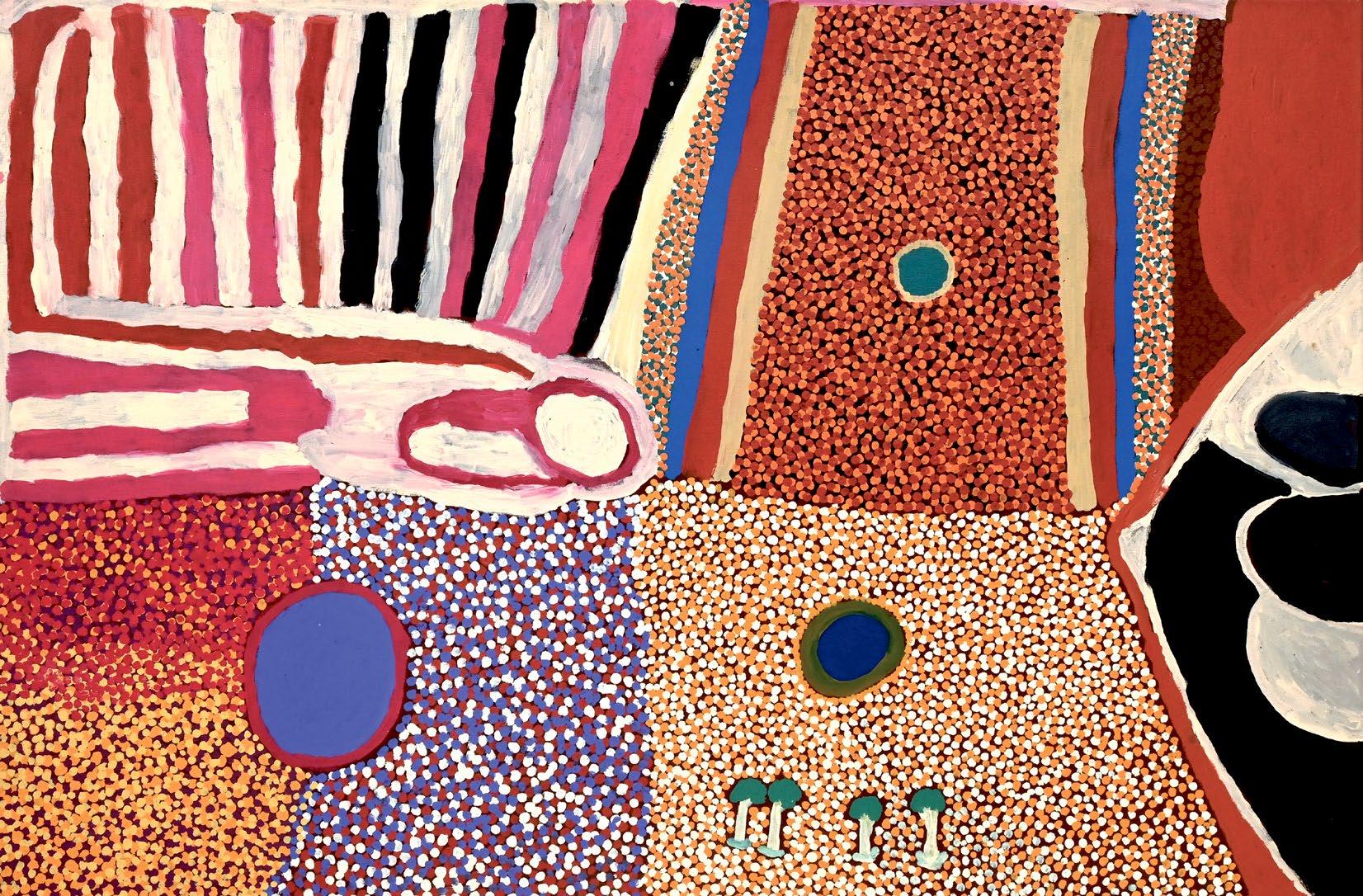
In response to the formation of the historical Canning Stock Route, during the 1940s their families joined the exodus of people to what is presently the remote Wangkatjungka community located 120 km south-east of Fitzroy Crossing. A large part of the population travelled north towards Bililuna, or north-west following a trail of creek beds and waterholes. Many found work on these cattle stations until the introduction of Equal Pay for Aboriginal station workers in 1971, which resulted in many workers being displaced. Christmas Creek Station was established at the historical gathering site for law ceremony and community meetings during the wet season.
The artists collaborated on this painting in the Wangkatjungka Community which is located next to Christmas Creek. Each of the participants sat and painted their country which lies between Kurlyayi and Nyirla as they worked toward the centre of the canvas.
PUKARA, 2005
151 x 98 cm synthetic polymer paint on canvas
EST $1,800 - 2,200
Papulankutja Artists, NT Cat No. 05-825 Private Collection, SA Lawson~Menzies, Sydney, NSW, November 2007, Lot No. 253 Menzies Estate Collection, Vic
Accompanied by a certificate of authenticity from Papulankutja Artists
Born at Yanpan, a rock-hole near Ngatuntjarra Bore around 1940, Jimmy Donegan grew up near Blackstone in Western Australia.
A skilled wood craftsman, he took up painting at the beginning of the millennium and in 2010, won the most prestigious Indigenous art prize in Australia, the National Aboriginal and Torres Strait Islander Art Award.
In this rendition of his grandfather’s country, Jimmy has shown the two snakes (wanampi) that live at Pukara, a sacred men’s site. The two wanampi, father and son, travel from rockhole to rockhole, from Pukara to Kuru Ala and Nyumu.
Donegan had depicted this red sand dune country with its rockholes and small rocky outcrops as intensely coloured fields of dots crossed by lines, signifying the journey of the two snakes above and below the surface of the earth.
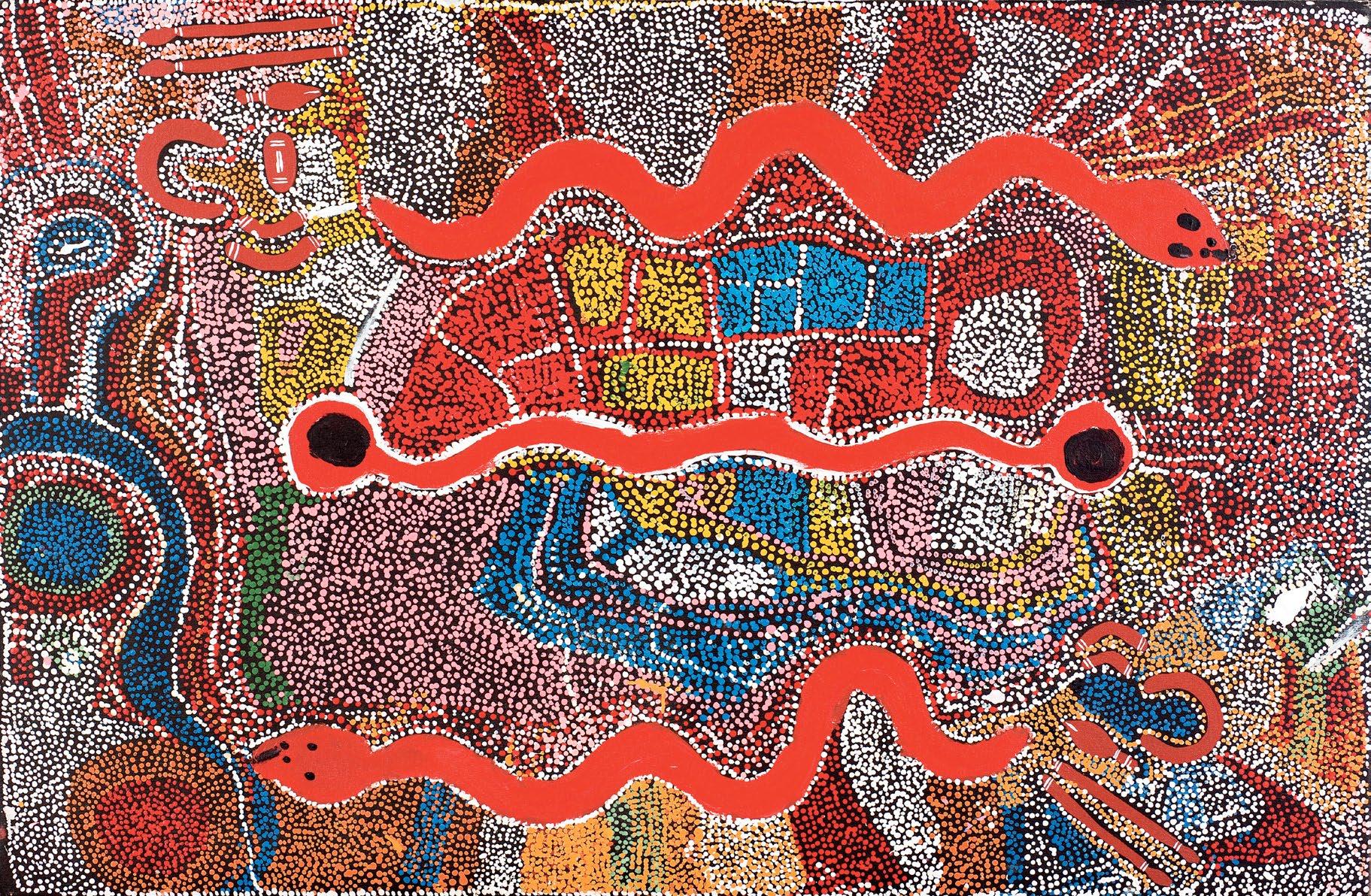
The East Coast of central New Ireland and adjacent islands comprise the epicentre of a unique art style, unlike anything else from Papua New Guinea. While the term ‘Malagan’ is usually applied to the 3-dimensional art of the region, it also encapsulates the whole culture of the Nalik, Noatsi, Madara and Mandalak speaking groups of people.

Traditionally, Malagan ceremonies welcome children into the world, initiate them into adulthood, and, most importantly, guide their spirits after death. After the body had been buried or burnt, gardens were planted and pigs were bred and fattened so that a feast could be prepared, signifying the importance of the departed. In some cases, it could be several years before the final memorial would take place. The feast would be accompanied by ceremonial dances in which the participants wore a range of specific dance masks. Intricate carvings made from the rainforest tree Alstonia Scholaris were ornately painted and decorated with ochre, lime, charcoal, plant sap, fibre, and seeds. The operculum of the shell ‘Turbo petholatus’ was used for the eyes. Inserting the eyes was the final stage in the making of the sculpture thereby imbuing the figure with spirit. Now it had life it had to be respected.
The following pieces from the Rod Menzies collection represent a wide range of items of different use in Malagan culture, produced over a 50-year period from the mid-1940s to the 1990s. The collection was assembled over a number of field trips to New Ireland and remote villages on the Tabar Islands during the 1990s by Harold Gallasch and Neil McLeod. Today, there are very few remaining carved Malagans still extant in the villages where they were collected.
Harold GallaschPrivate Collection, Vic
Deutscher-Menzies, Melbourne, Vic, June 2000, Lot No. 227 Menzies Estate Collection, Vic
Standing almost three metres tall, this Malagan pole features the facial likeness of deceased members of the village community and is displayed at the final phase of a Malagan ceremony called Aruara.
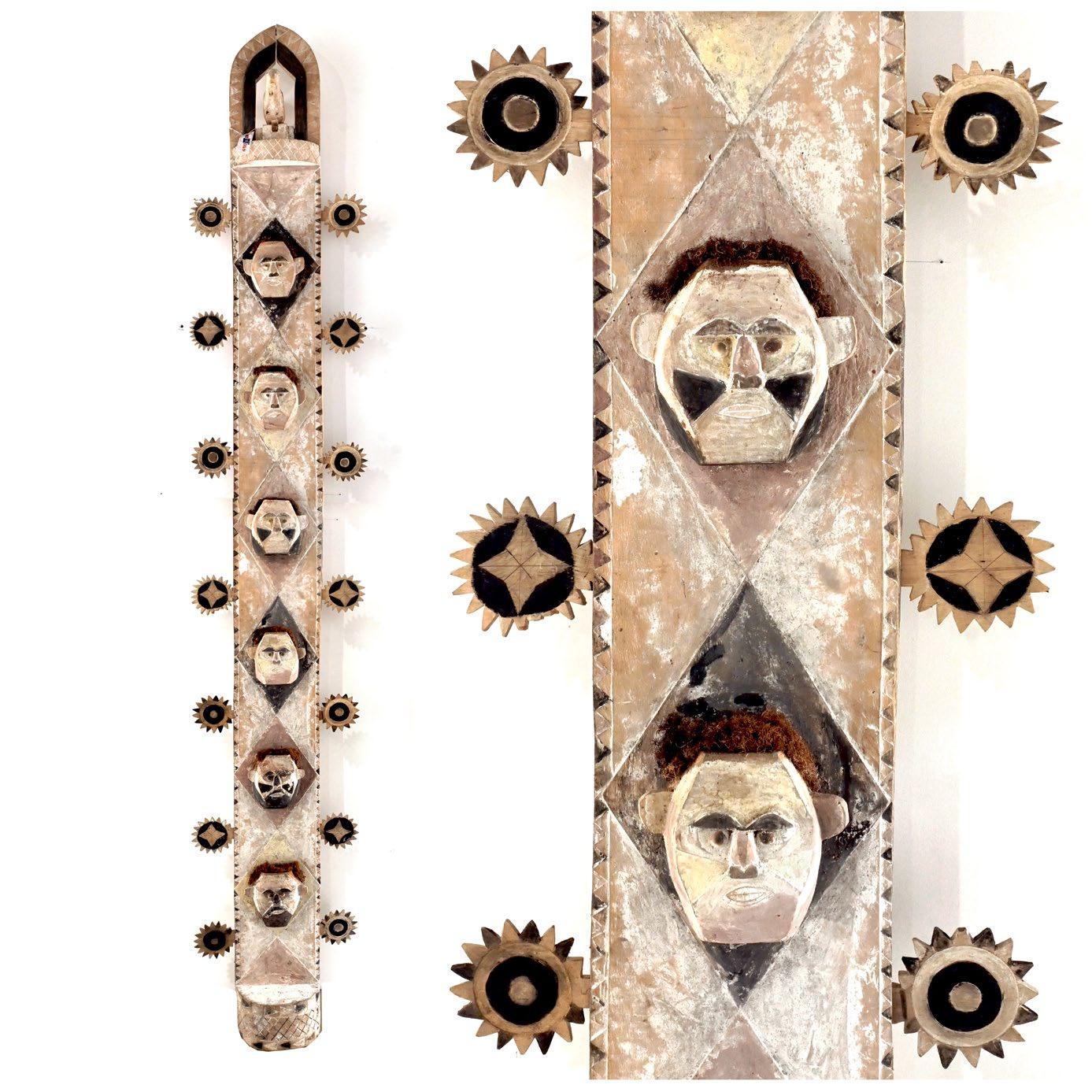
The ritual process of producing Malagan sculptures is complex and timeconsuming. It is as much a part of the festivities as the performance itself. After the sculptures are carved and the wood has dried, they are placed in an enclosure built in or near the cemetery.
The dramatic unveiling of the Malagan figures at the end of the festivities is accompanied by generous feasts and dances at which the spirits of the dead are believed to be present.
MALAGAN MI TEKENINIU, 1994
185h x 22w x 12d cm
Carved in timber of Alstonia scholaris, painted with white lime, red ochre, black charcoal and plant sap, with operculum shell, Turbo petholatus for eyes
EST $1,000 - 1,500
PROVENANCE
Private Collection, Vic
Deutscher-Menzies, Melbourne, Vic, June 2000, Lot No. 230
Menzies Estate Collection, Vic
The Malagan Mi Tekeniniu was created to diffuse grief after mourning.
MALAGAN MORU MORU, 1996
207h x 15w x 13d cm
Alstonia scholaris timber, earth pygments, operculum of Turbo petholatus
EST $2,500 - 3,500
PROVENANCE
Deutscher-Menzies, Melbourne, Vic, June 2000, Lot No. 213 Menzies Estate Collection, Vic
Related work:
M. Gunn, Ritual Arts of Oceania, New Ireland in the Collections of the Barbier-Mueller Museum, Skira Editore, Milan and Musée Barbier-Mueller, Geneva, 1997 pl.116, p.116
Standing just over two meters tall, this Malagan pole is made up of intricately intertwined forms and a complex geometric design.

The figure displays a Kap Kap or circular ornament fashioned in minute detail from shell and worn on the chest as a symbol of clan leadership. The head at the top of the carving features Malagatsak, an archetypal warrior from the pre-contact period mid to late 19 century.

A KIV KIV LING MALAGAN, 1995 597h x 17w x 17d cm
Carved Alstonia scholaris wood and plant fibre, painted with lime, ochre, charcoal, and plant sap
EST $5,000 - 7,000
Tatau village, Tatau Island, PNG Private Collection, Vic Deutscher-Menzies, Melbourne, Vic, June 2000, Lot No. 225 Menzies Estate Collection, Vic
This Kiv Kiv Malagan has a human figure wearing a Kap Kap, a finely articulated shell body decoration worn on the chest to signify chief or warrior status in the village. It was carved for a Malagan feast in Tatau village, Tatau Island.
It was created by Edward Sali who lived amongst a number of renowned carvers including Launa Aianis and Urban Langiri.

MALAGAN MAGSTALATSAK, 1992
650h x 48w x 20d cm
Alstonia scholaris timber and vegetable fibre, painted with lime, charcoal, red ochre, plant dye
EST $6,000 - 8,000
PROVENANCE
Collected after the ceremony at Matlik Village, New Ireland, PNG Private Collection, Vic Deutscher-Menzies, Melbourne, Vic, June 2000, Lot No. 223 Menzies Estate Collection, Vic
This substantial carving was produced for a Malagan ritual in the early 1990s.

MALAGAN WORA WAWA FRIEZE, c.1970
285h x 42w x 12d cm
Alstonia scholaris timber, painted with white lime and overpainted with red ochre, black charcoal and plant sap (from root of wild ginger) with operulum of Turbo petholatus
EST $1,500 - 2,500
PROVENANCE
Collected after the ceremony at Matlik Village, Tabar Island
Private Collection, Vic
Deutscher-Menzies, Melbourne, Vic, June 2000, Lot No. 226 Menzies Estate Collection, Vic
Intricately carved in light wood, this work represents a fish in high relief with distinctive Malagan features.
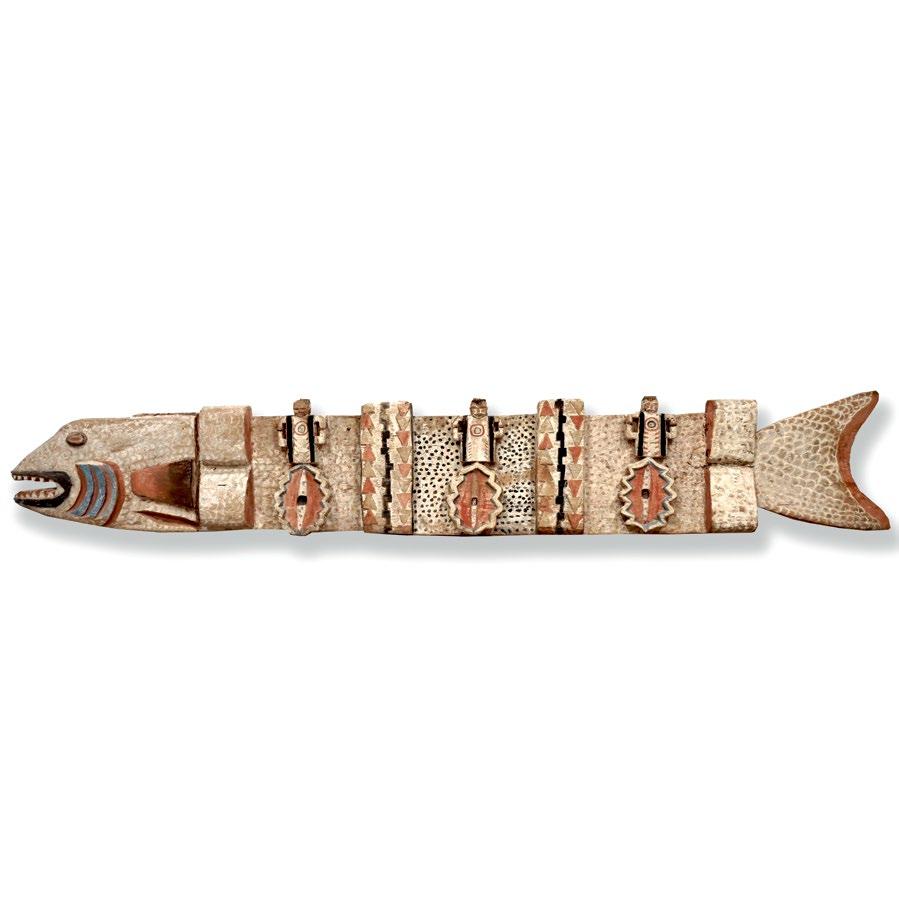
MALAGAN CANOE, 1985
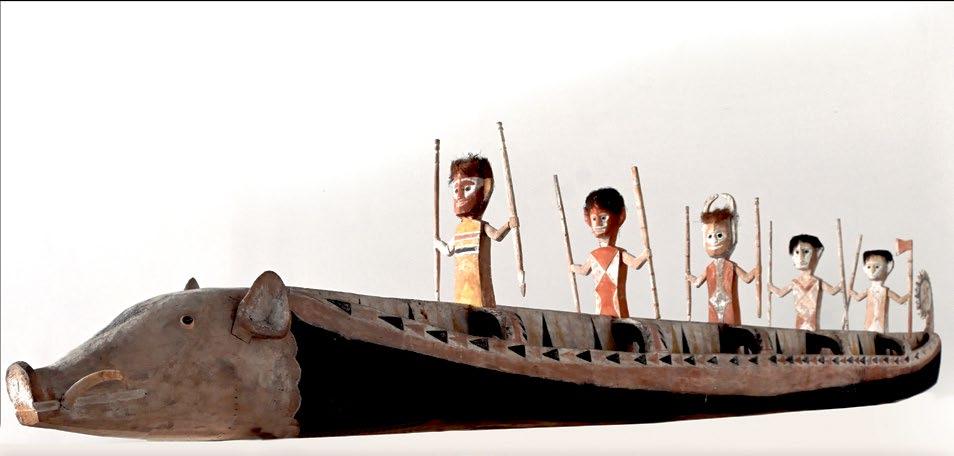
358L x 61h x 41w cm
Timber from Alstonia scholaris with vegetable fibre, painted with lime, charcoal, red ochre and plant sap (yellow)
EST $4,000 - 6,000
PROVENANCE
Private Collection, Vic
Deutscher-Menzies, Melbourne, Vic,
June 2000, Lot No. 206
Menzies Estate Collection, Vic
WALL FRIEZE, 1975
39h
EST $900 - 1,200
Collected by a Government worker in New Ireland, PNG Private Collection, SA Deutscher-Menzies, Melbourne, Vic, June 2000, Lot No. 212 Menzies Estate Collection, Vic
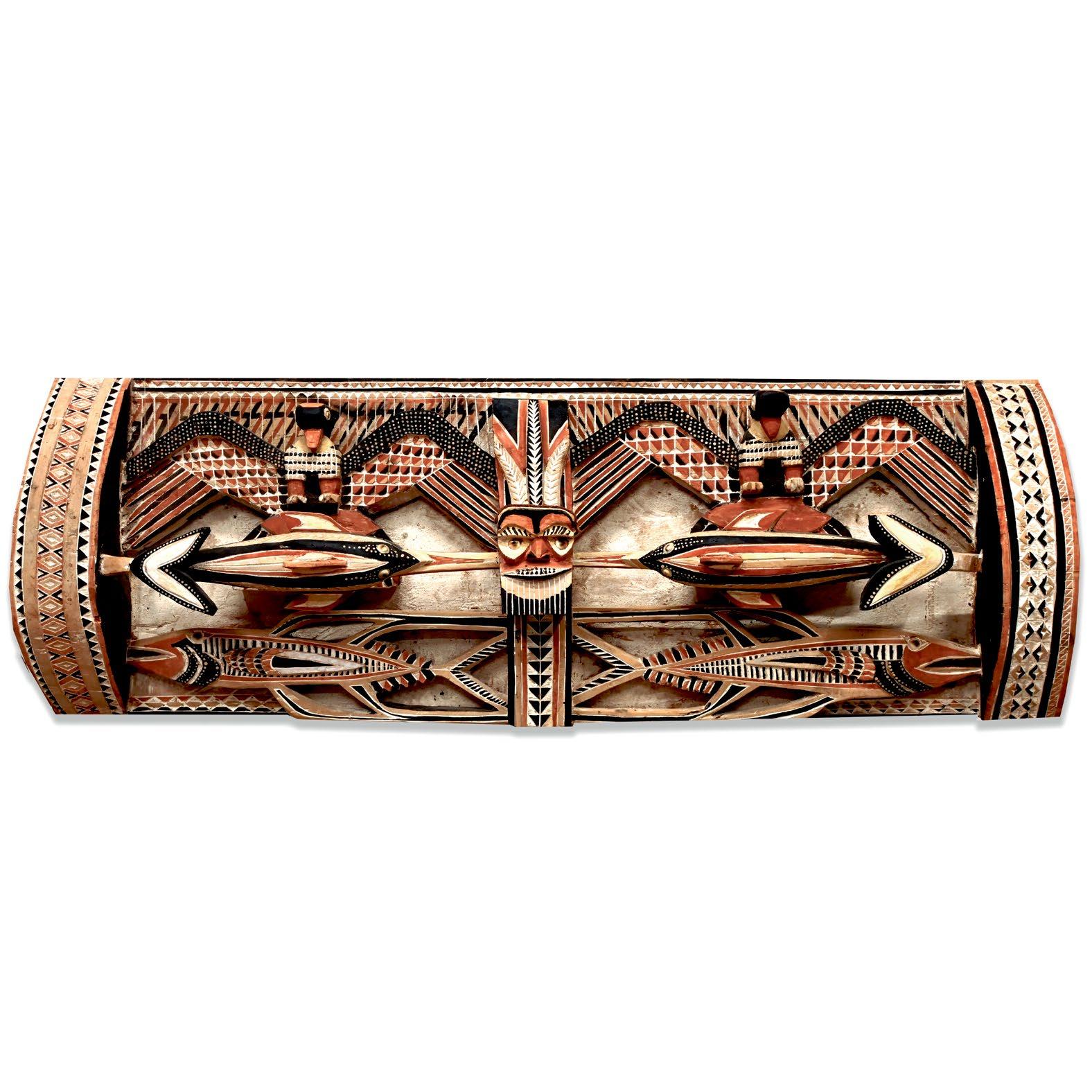
Cf. For stylistically similar works see: Louise Lincoln, Assemblage of Spirits, Idea and Image in New Ireland, George Braziller, New York, 1987, pl. 38, pp 140-141
Intricately carved in light wood, this frieze features figures in high relief with distinctive Malagan features, including a face at the centre with large circular eyes, and grinning mouth; four carved fish; and two representations of Sizuel, shown sitting on the moon. To the right and left of Sizuel, are rays of light that emanate from the moon.
Legend has it that a Marsalai, or spirit, entered the smoke of a fire and drifted up towards the moon. When people prepare for a long voyage by canoe, they petition Sizuel, requesting him to exert his influence over the moon to provide favourable weather for their journey.
ARTIST ONCE KNOWN
YUAT RIVER SHIELD, c.1970
160h x 29w x 12d cm
natural earth pigments on carved wood
EST $800 - 1,500
PROVENANCE
Collected at Yuat River near Keram in the Sepik River region, PNG Private Collection, Vic
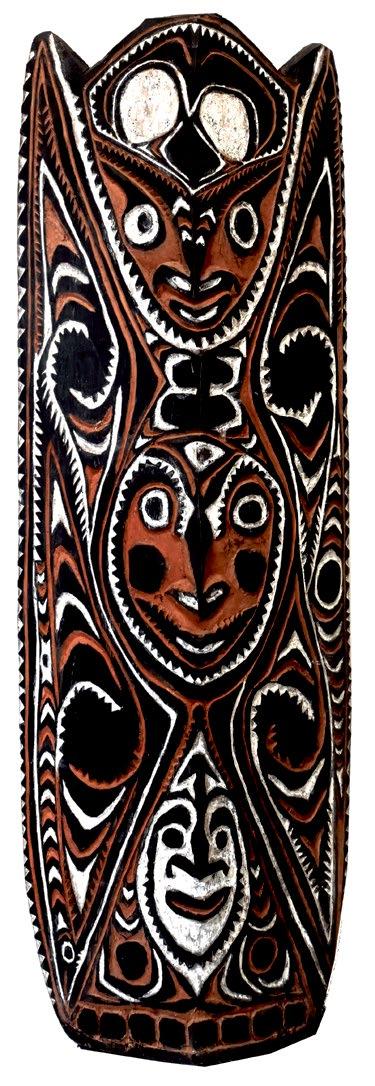
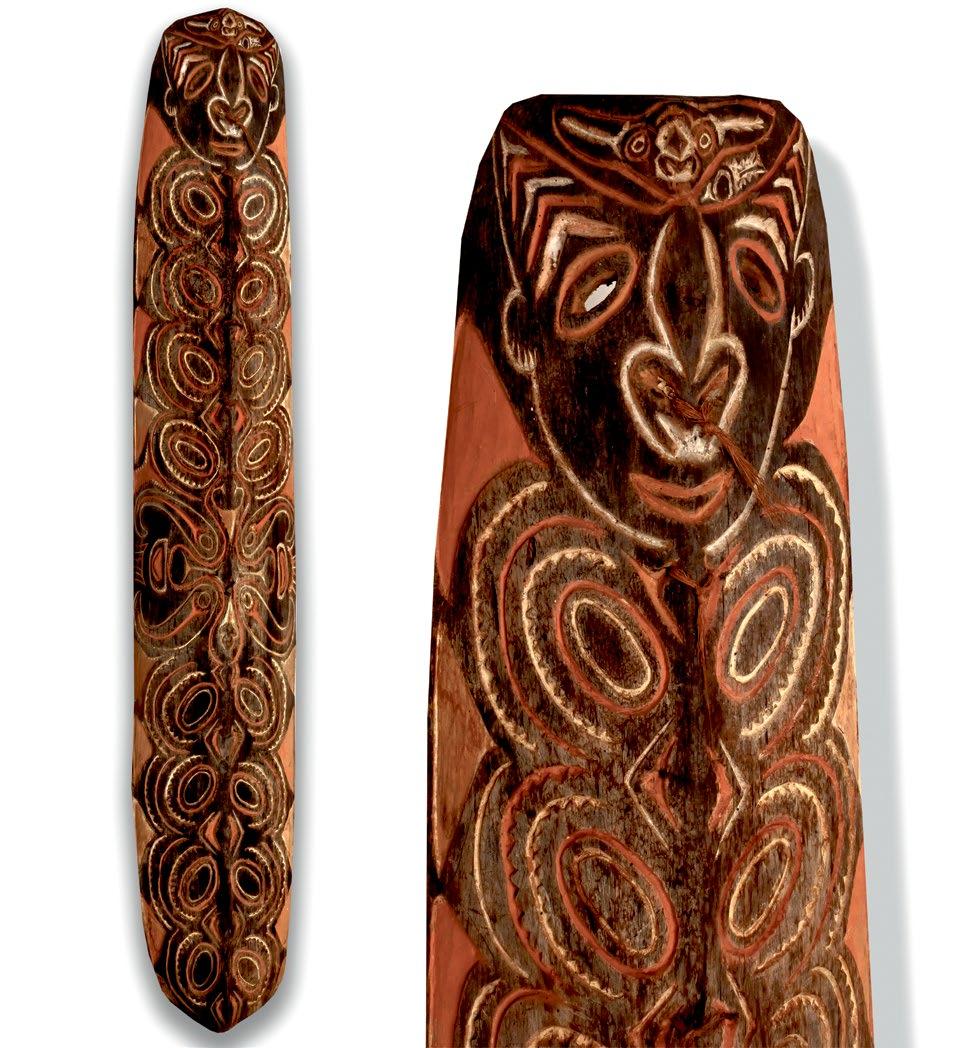
Menzies Estate Collection, Vic
ARTIST ONCE KNOWN
YUAT RIVER SHIELD, c.1990
130h x 23w x 8d cm
natural earth pigments on carved wood
EST $600 - 900
PROVENANCE
Collected at Yuat River near Keram in the Sepik River region, PNG Private Collection, Vic Menzies Estate Collection, Vic
MALAGAN LUNET CER MI, 1996
167h x 20w 20d cm
Carved post of Alstonia scholaris timber, painted with white lime, red ochre, black charcoal, and plant sap, with eyes of the operculum of Turbo petholatus


EST $1,200 - 1,600
PROVENANCE
Private Collection, Vic
Deutscher-Menzies, Melbourne, VIC, June 2000, Lot No. 216 Menzies Estate Collection, Vic
MALAGATSAK MARUMARUA, c.1950
70h x 14.5w x 14.5d cm
Carved timber of Alstonia scholaris, painted with white lime, red ochre, black charcoal and plant sap
EST $800 - 1,200
PROVENANCE
Private Collection, Vic
Deutscher-Menzies, Melbourne, VIC, June 2000, Lot No. 215 Menzies Estate Collection, Vic
MALAGAN VANIS, 1998
112h x 63w x 25d cm
EST $1,600 - 2,600
Private Collection, Vic Deutscher-Menzies, Melbourne, Vic, June 2000, Lot No. 210 Menzies Estate Collection, Vic
Malangan Vanis, or Tatanua masks, are produced in the northern part of New Ireland and Tabar Island.They are commonly used at funeral rites, which both bid farewell to the dead and celebrate the vibrancy of the living. Used in exclusively men’s ritual, the mask does not represent a particular individual but rather the characteristics, and capabilities of a male in a cultural sense. It is meant to contain strong spiritual power which is employed by its wearer throughout the dance towards the end of the Malagan funeral ceremony. Each colour represents a certain action. Red evokes the spirits of those who have died from violence; black is associated with warfare, while white is believed to have the power to enact magic.
This stylised interpretation of a male face features a dove, a flying fish and snakes from the land and sea.
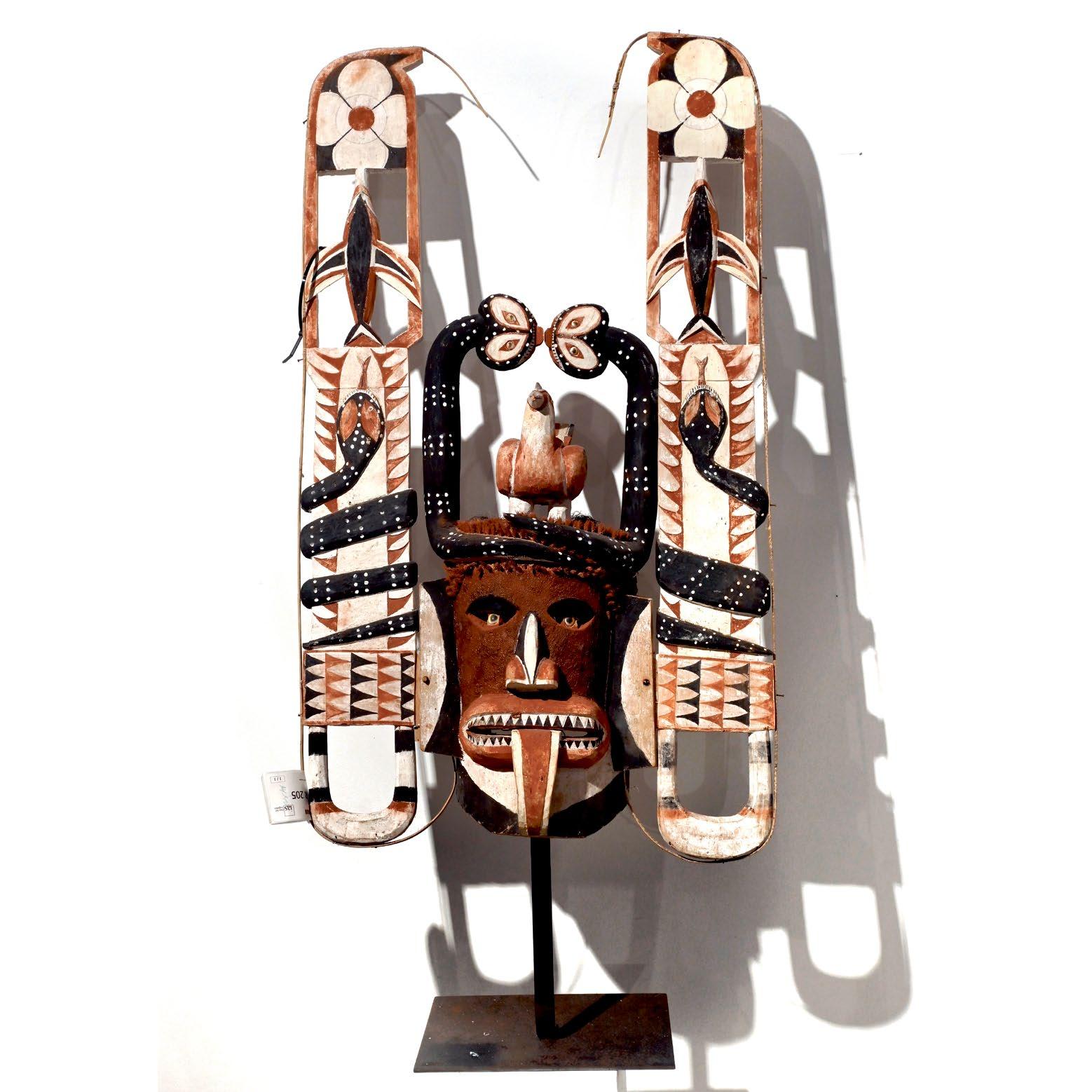
VIRIM VANIS MALAGAN, 1994
77.5h x 48w x 35d cm
Timber of the Alstonia scholaris, carved and painted with ochres and earth colours using fixative.
EST $1,200 - 2,200
Private Collection, Vic Deutscher-Menzies, Melbourne, Vic, June 2000, Lot No. 207 Menzies Estate Collection, Vic
Malangan Vanis, produced in the northern part of New Ireland and Tabar Island, are commonly used at funeral rites, which both bid farewell to the dead and celebrate the vibrancy of the living. Used in exclusively men’s ritual, the mask represents the characteristics and capabilities men held in high regard culturally. It is meant to contain strong spiritual power which is employed by its wearer throughout the dance towards the end of the Malagan funeral ceremony.
This intricate example is one of the last Vanis made by Hosea Linge who was regarded as one of the finest practising carvers in New Ireland during the 1980s.
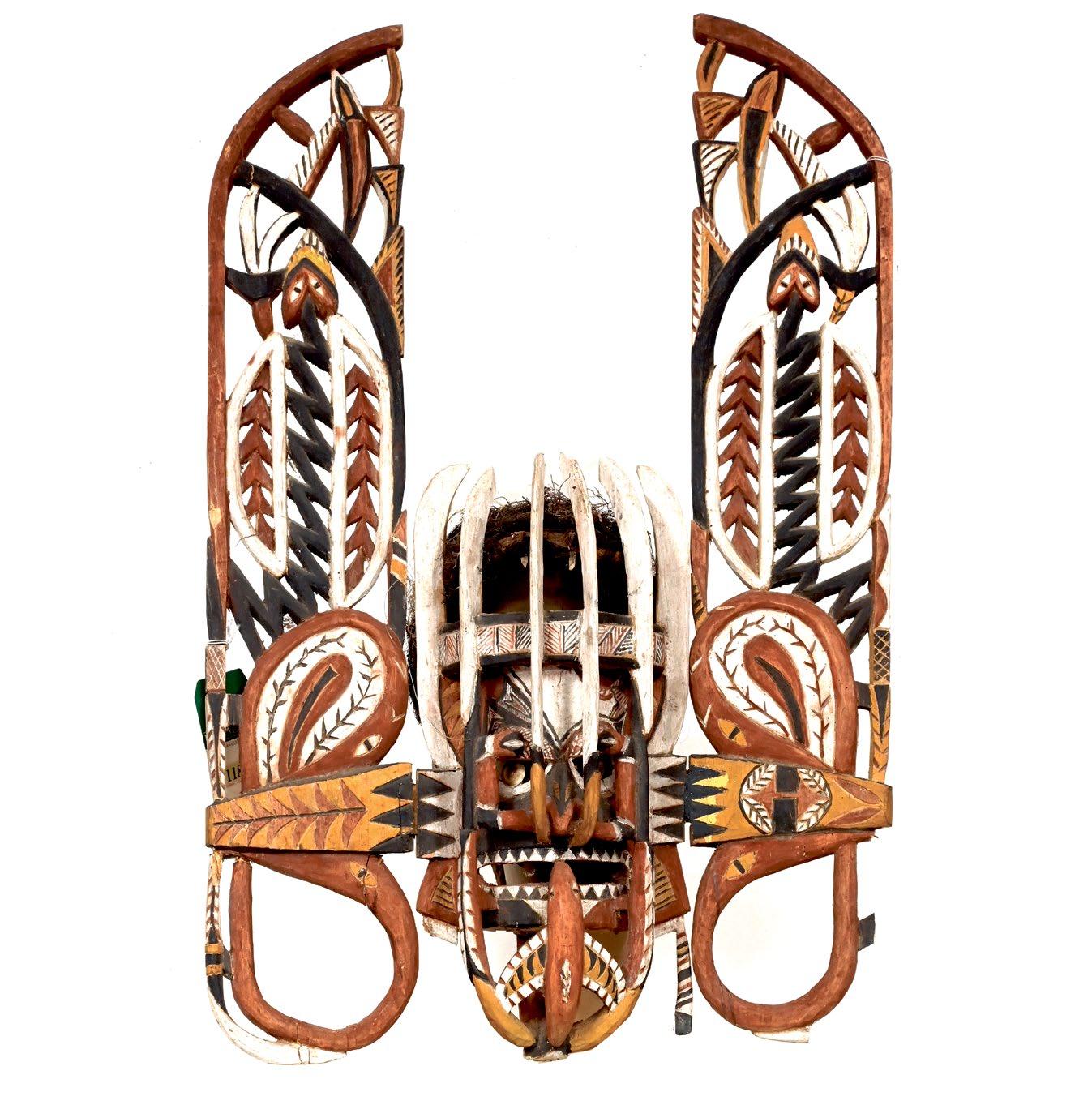
EST $700 - 1,200
Private Collection, SA
Deutscher-Menzies, Melbourne, Vic, June 2000, Lot No. 209 Menzies Estate Collection, Vic
Cf. For a similar work see: M. Gunn, Ritual Arts of Oceania, New Ireland in the Collections of Barbier § Mueller Museum, Skira Editore, Milan 1997 and Musée Barbier Mueller, Geneva, 1997, pl. 93, p. 82

Malagan ceremonies are large, intricate traditional cultural events that take place in parts of New Ireland province in Papua New Guinea. The term Malagan refers to the entire living culture for the people of the New Ireland archipelago east of New Guinea. Each Malagan carving has its own story relevant to the particular clan, village and island within the archipelago.
This mask was created for use in the Malagan Ceremony to remove evil spirits and curses from the village.
66
BEN SISIA (c.1925 - 2010)
TANTANUA MASK, 1998
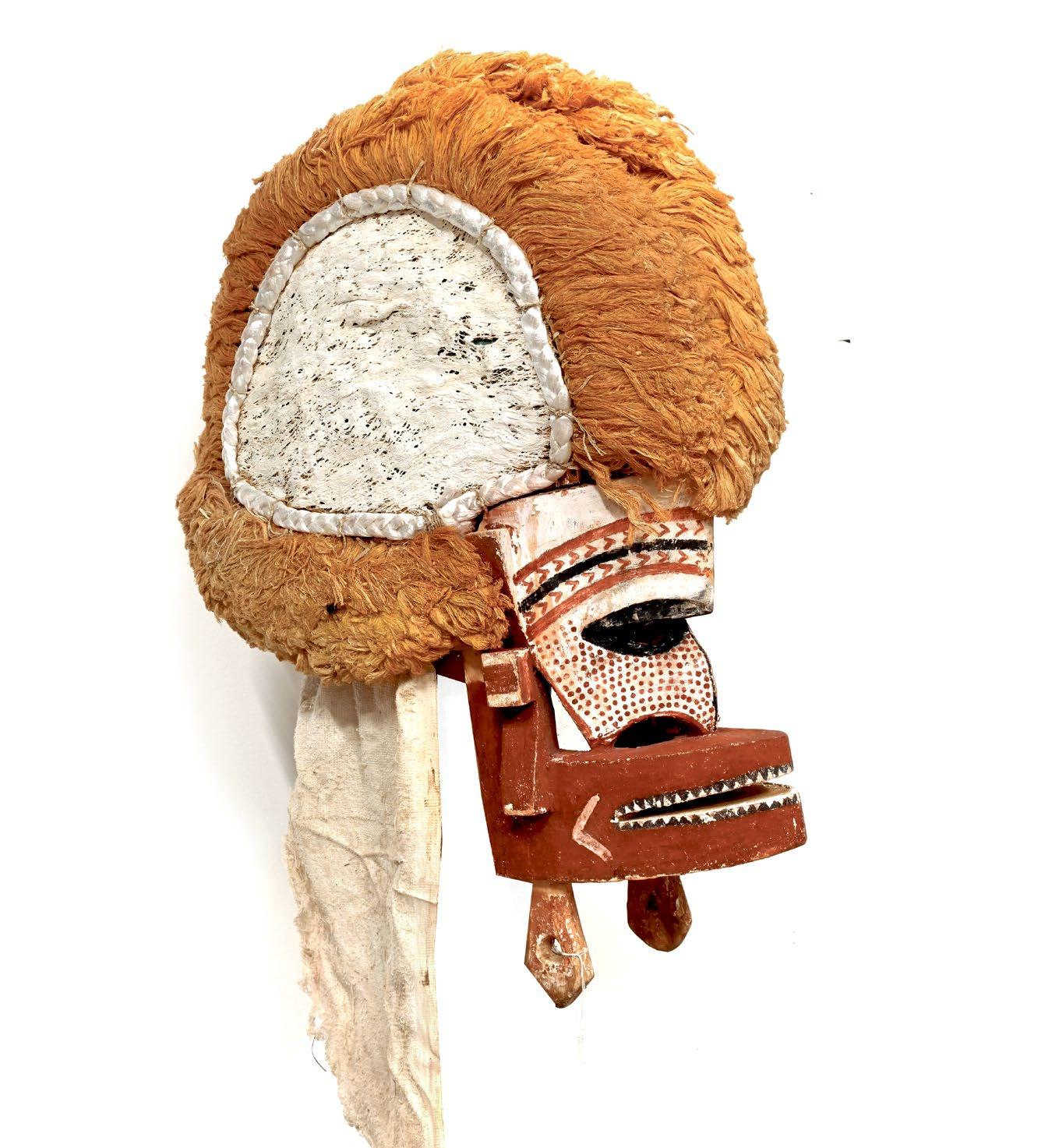
87h x 23w x 48d cm
Carved Alstonia scholaris wood with beaten tree bark fibre, tapa bark, coconut husk, lime, ochre, charcoal, plant sap and operculum of the Turbo petholatus shell.
EST $1,200 - 1,800
New Ireland, PNG Private Collection, Vic Deutscher-Menzies, Melbourne, Vic, June 2000, Lot No. 208 Menzies Estate Collection, Vic
The Tatanua mask, from New Ireland, is part of a rich sub-collection of objects related to the Malangan funerary complex. The word tatanua derives from the word tanua meaning soul or spirit and tatanua dance masks are worn in malangan ceremonies to honour the dead. The masks are distinguished by their carved softwood openwork frame with protruding facial parts. The upper section characterised by a crest made of vegetable fibres and paperbark bound on a split rattan framework that is decorated on each side with natural pigments and lime applied to the exterior. These masks quite accurately represent earlier hairstyles worn by men during ceremonies.
GOR GOR SURIDA, c.1930
58h x 15w x 14d cm
natural earth pigments and lime on carved wood
EST $2,000 - 3,000
PROVENANCE
Collected in 1996 from Matlik Village, Tabar Island
Private Collection, Vic
Deutscher-Menzies, Melbourne, Vic, June 2000, Lot No. 221
Menzies Estate Collection, Vic
This Malagan figure, created during the classical period following first contact, was originally collected from a cave on Tabar Island.

Decorated in earth pigments and lime, the torso reveals a finely articulated Kap Kap, the highly prized shell body ornament worn on the chest to signify clan leadership or warrior status.
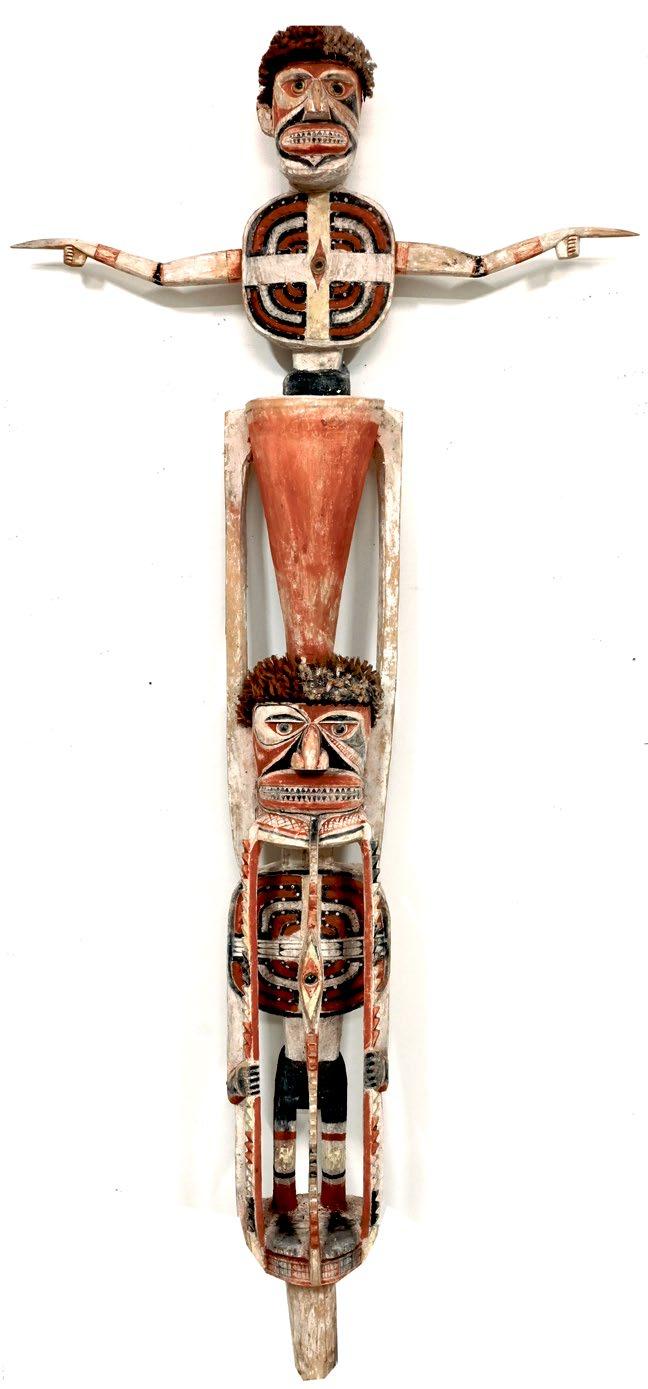
Malagan Terengran, 1995
201h x 82w x 21d cm
Carved timber from Alstonia scholaris, painted with lime, black charcoal, red ochre, plant sap, with plant fibre and opercula of the shell, Turbo petholatus.
EST $2,000 - 2,500
PROVENANCE
Private Collection, Vic
Deutscher-Menzies, Melbourne, Vic, June 2000, Lot No. 222
Menzies Estate Collection, Vic
Related work: P.J. Hallinan, Revelation of the Malagans, The Ritual Art of New Ireland, Sydney (exhib cat), 1990 pl. 44, p.33
The several figures on this Malagan represent ancestors associated with the story for this object.. The carving can often be named after them. Carved into each wing is the “Eye of the Fire”, represented by Tumsiu shells.
TJUPURRULA
(c.1920 - 2001)
KALIPYINPA, 1978
61 x 91.5 cm synthetic polymer paint on canvas
EST $4,000 - 6,000
PROVENANCE
Papunya Tula Artists, NT Cat No. JW781128 Private Collection,Vic Lawson~Menzies, Fine Australian and International Art, October 2003, Lot No. 78 Menzies Estate Collection,Vic
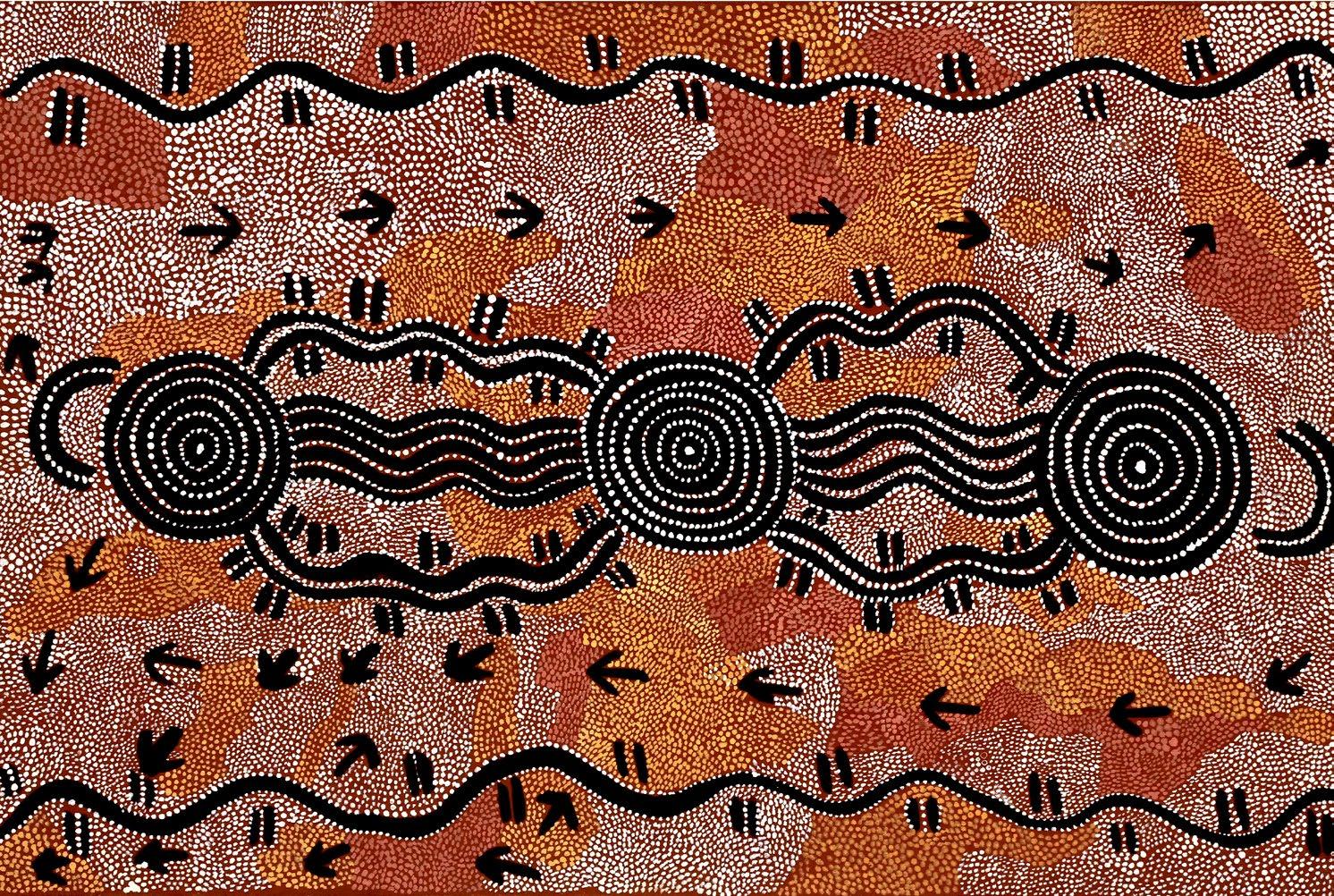
Accompanied by a certificate of authenticity from Papunya Tula
Kalipinypa is a Water Dreaming site some 500 km north west of Alice Springs. During creation, a great storm. erupted at this place. Whirlwinds lifted the dust in spirals. Heavy rain fell and there was much lightning. The downpour was so heavy that the water flowed along the ground, lifting leaves, logs and other debris. A very deep and permanent rock hole was formed.
Kalipinypa is the most western point of a chain of Water Dreaming sites which run from west to east.This line of travel is conceived by the movement of mythological storm ancestors, crossing the path of another which came from the east.
Johnny Warangula has used the most classical iconography associated with this site. The sets of concentric circles symbolise the rock hole site of Kalipinypa while the central sets of adjoining concentric circles indicate running water, the floodwaters associated with the downpour. Both the outside sinuous lines and the double lines that join the concentric circles represent ‘Winpa’ the lightning ancestor splitting the heavy grey rain clouds (indicated by the short parallel bars).
This is but an abridged version of the long narrative which accompanies this painting.
TINGARI CYCLE, 2001 122 x 61 cm synthetic polymer paint on Belgian linen
EST $1,000 - 1,500
PROVENANCE
Gallery Gondwana, NT Cat No. 6719DG
Private collection, NSW
Lawson~Menzies, Sydney, NSW, November 2004, Lot No. 9 Menzies Estate Collection, Vic
Dr. George Tjapaltjarri was a traditional healer and respected spiritual leader who lived around Jupiter Well until the early 1960s, when contact was first made with white society.
In this painting the black and white roundels are both ceremonial body designs and the rocky outcrop terrain of the site called Ungarla where men’s initiation ceremonies (Malliera) were conducted in underground caves.
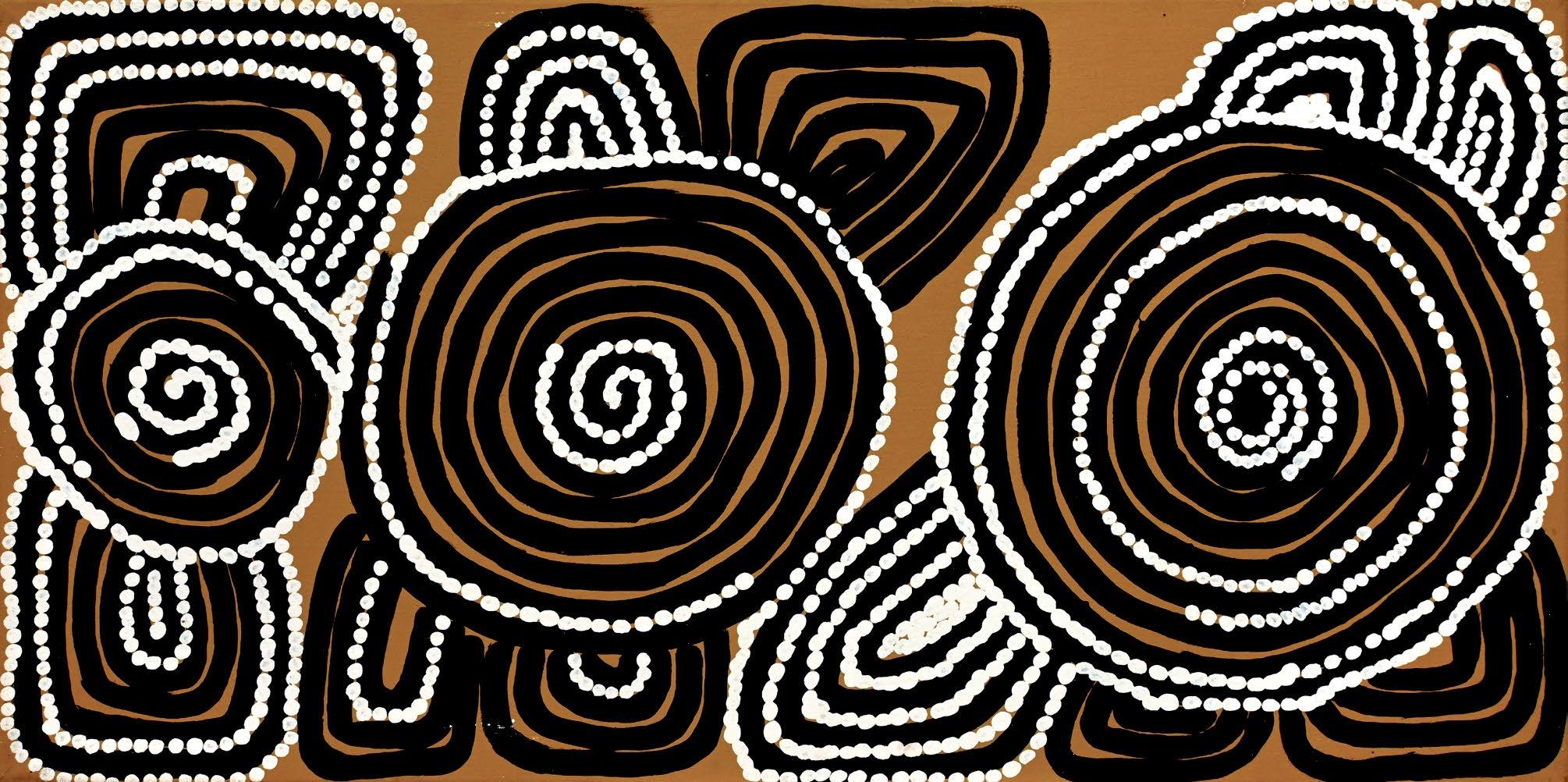
These ceremonies refer to the travels of the Tingari ancestors over vast stretches of country, who performed rituals, creating and shaping particular sites. The Tingari Men were usually followed by Tingari Women and accompanied by novices. Their travels and adventures are enshrined in a number of song cycles.
These creation stories partly form the teachings of post-initiatory youths at the same time providing the basis for contemporary customs. Their intimate details are of a secret nature and not shared with outsiders.
MICK GILL TJAKAMARRA (1919 - 2002)
NGAPA TJUKULPA - WATER DREAMING, 1995 60.5 x 91 cm synthetic polymer paint on canvas
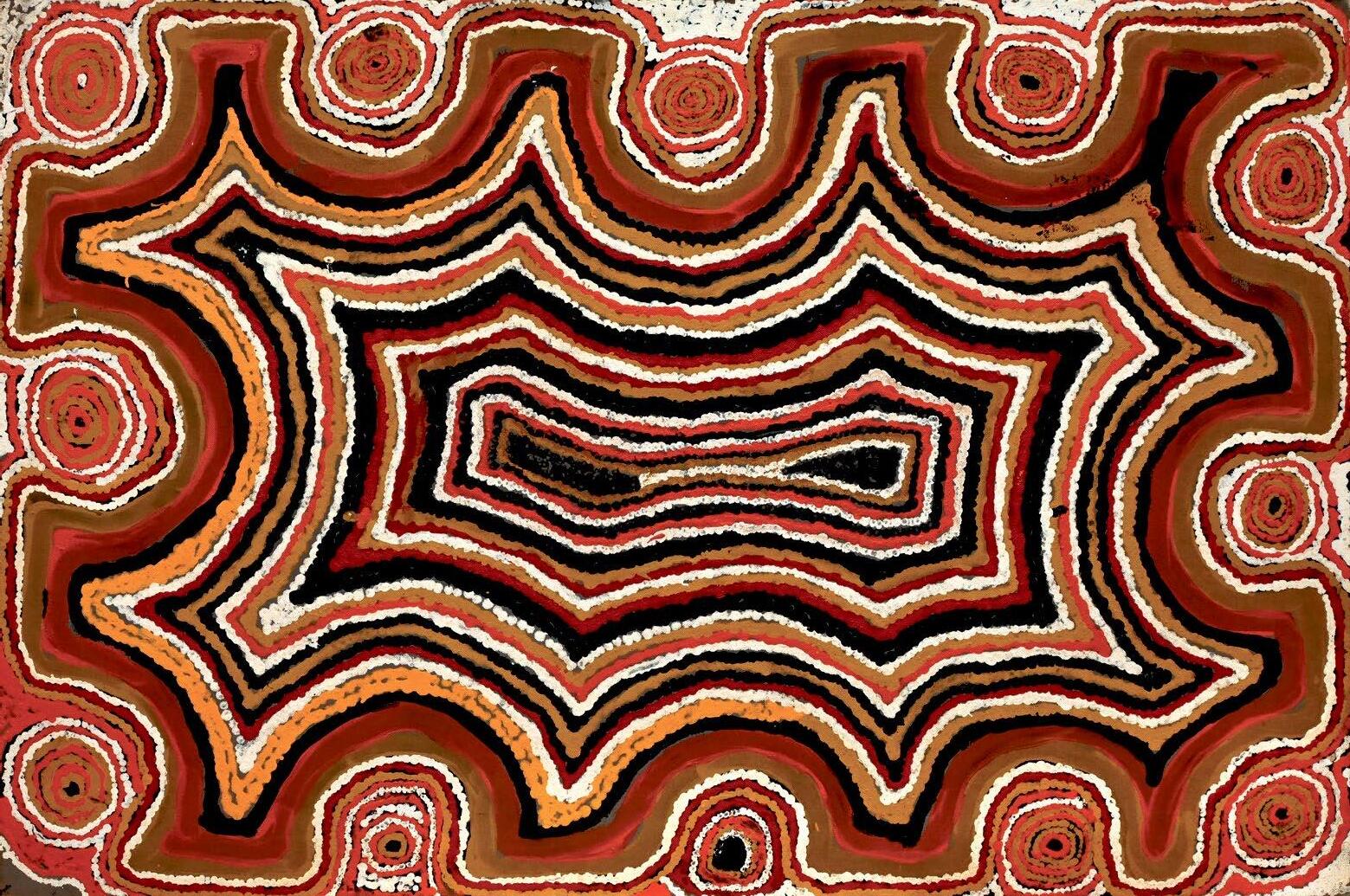
EST $600 - 800
Warlayriti Artists, WA Cat No. 11/95
Lawson~Menzies, Sydney, NSW, July 2005, Lot No. 155 Menzies Estate Collection, Vic
This painting depicts the place where Mick Gill Tjakamarra used to live when he was a young man. The central area shows where a powerful water spirit comes up out of the ground. It is where rainmaking ceremonies call up thunder and lightning. Amongst the Kukatja inhabitants, these are referred to as Ngapa Tjukulpa (Water Dreaming). Such activities are believed to have formed the features of the land with its many clay pans, creeks, and salt lakes during the creation period.
72
WALANGKURA NAPANANGKA (c.1946 - 2014)
UNTITLED, 2001
122.5 x 61 cm
synthetic polymer paint on Belgian linen
EST $2,200 - 2,800
PROVENANCE
Papunya Tula, NT Cat No. WN0107077

Sotheby’s, Melbourne, Vic, November 2005, Lot No. 180
Menzies Estate Collection, Vic
As one of the last generations to remember a childhood lived in the desert hunting and gathering with her family, Walangkura Napanangka recalls the stories of country and the location of specific sites of her traditional homeland west of the salt lake of Karrkurutinjinya (Lake Macdonald) in her paintings.
In this small delicate work, she has depicted the sandhills and rockholes that are important for Women’s Dreaming in the region of Kintore and Kiwirrkurra.
Walangkura’s early works, created from 1996 onward, are characterised by masses of small markings and motifs covering the canvas. In this painting, her favourite colour, a deep sandy orange, predominates, effectively accentuated by complimentary cream and white.
73
ESTELLE INYIKA HOGAN (1927 - )
UNPUN, 1999
80.5 x 60 cm synthetic polymer paint on Belgian linen
EST $900 - 1,200
Spinifex Arts Project, WA Cooee Art, NSW Cat No. #3211 Private Collection, TAS Lawson~Menzies, Sydney, NSW, May 2006, Lot No. 281 Menzies Estate Collection, Vic
Estelle Inyika Hogan has painted the area where she was born. The work is centred on Baltatatjara, an important site for the Minyma Tjuta (Seven Sisters) story and several other Dreaming stories including the Wati Kutjara (Two Men) and Kalaya (Emu) story. As Estelle is the senior custodian of a place that has special significance for both men and women, the content of her paintings is carefully defined, and its interpretation involves a level of ‘assumed’ knowledge.

MIRRINTJII,
74
Spinifex Arts Projects, WA Cat No. C440 Cooee Art, NSW Cat No. #3110 Private Collection, NSW Lawson~Menzies, Sydney, NSW, November 2007, Lot No. 79\ Menzies Estate Collection, Vic
EST $900 - 1,200
Anne Hogan walked in from the desert to Cundeelee Mission with her family when still a child to escape a long period of drought, as well as British nuclear testing at Maralinga.
She moved with her family and a core group of older people back to country and set up camp at Yakadunya, just north of the Nullarbor Plain in the early 1980s. By 2001, she had become a senior law woman, and joined the Spinifex artists for painting trips to record and document her extensive knowledge of the region.
In this work Anne painted the area where the Kaling-Kaling tree, a type of eucalypt which is laden with tjuratja, a sweet sticky white gum, can be found. The painting is a map of the sites where she grew up and all the places of significance to her.
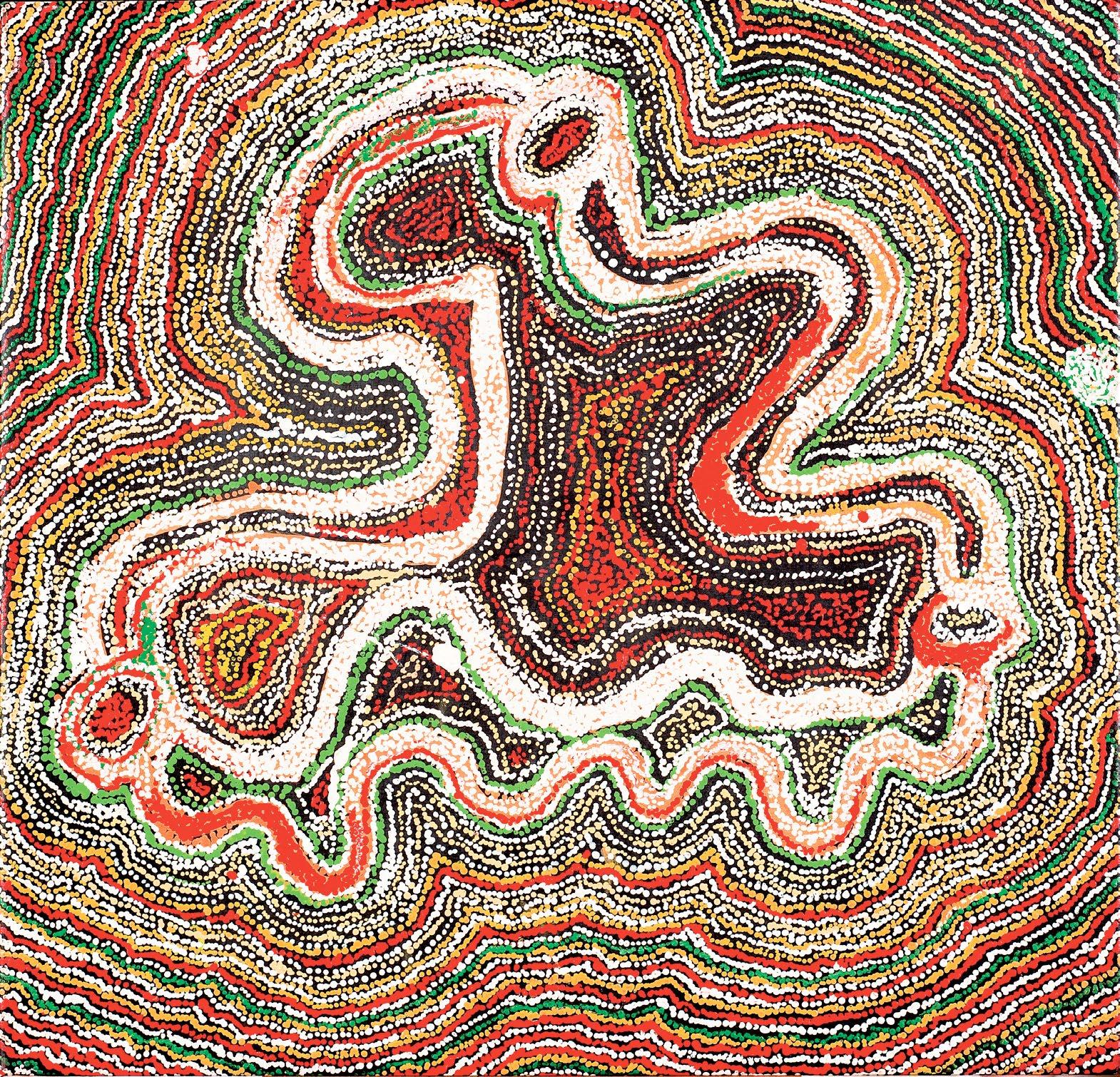
87.5
EST $1,800 - 2,200
Niagara Galleries, Vic Cat No. RNC 2002 Private Collection, Vic Lawson~Menzies, Sydney, NSW, March 2008, Lot No. 271 Menzies Estate Collection, Vic
Rosella Namok’s paintings reflect her personal response to the environment, cultural values, and traditional stories of the east coast community of Lockhart River on Cape York in Far North Queensland with a modern sensibility in her distinctive style. She emerged as a member of the Lockhart River ‘Art Gang’ that burst onto the contemporary art scene in the late 1990s.
In this reflective work, rhythmic parallel lines placed obliquely to the vertical, evoke the impression of rain across the water. Viewed from the beach as the rain stirs the fish beneath the tidal waters and mangroves, the artist sits pensively watching the fish jump and the birds flying past in the afternoon.
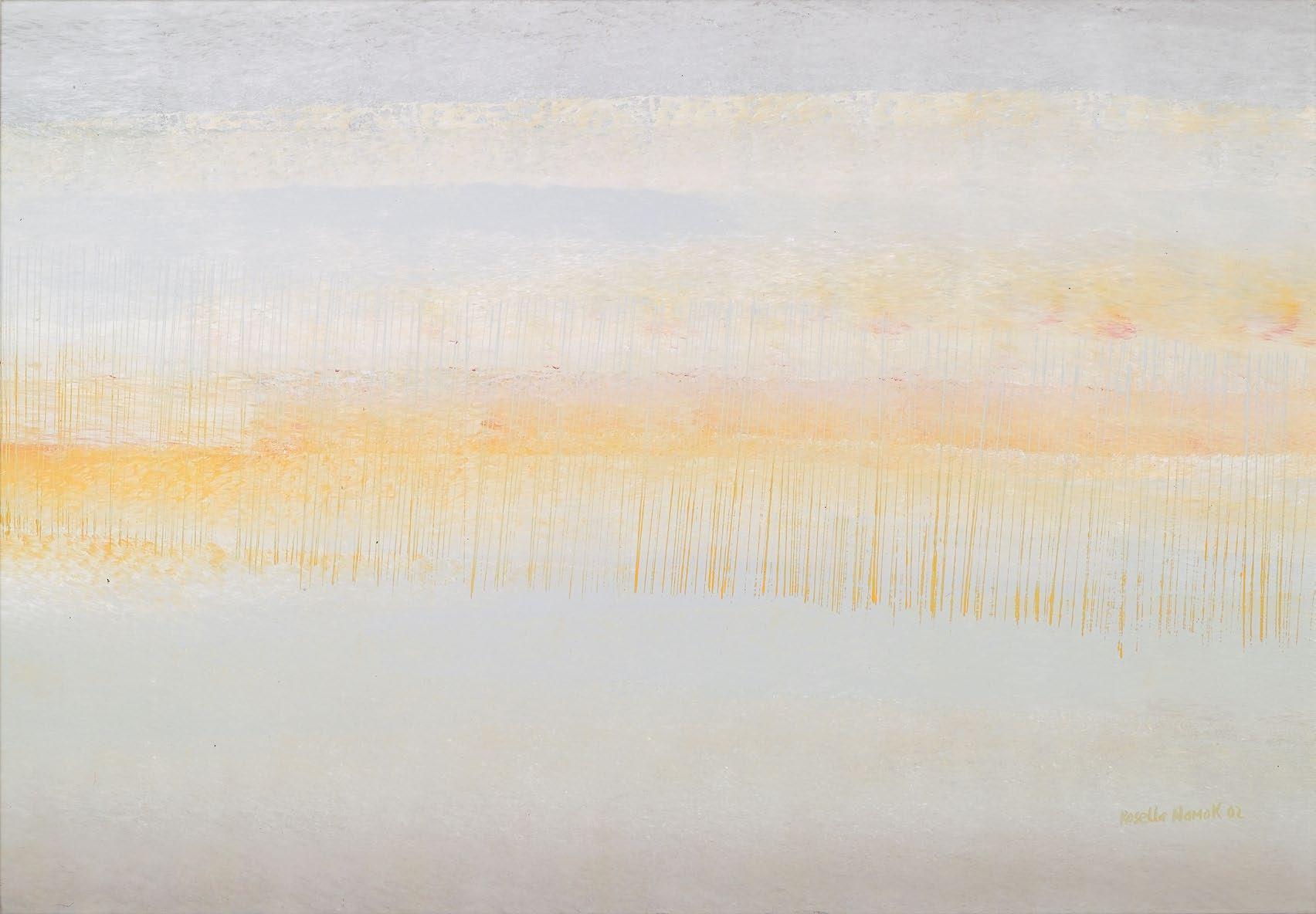
KUDDITJI KNGWARREYE (1938 – 2017)

MY COUNTRY, 2005
152.5 x 183 cm synthetic polymer paint on canvas
EST $4,000 - 6,000
Aboriginal Gallery of Dreamings, Vic Cat No. #10862
Menzies,Australian & International Fine Art, Sydney, NSW, March 2010, Lot No. 115
Menzies Estate Collection, Vic
The younger brother of the late Emily Kame Kngwarreye, Kudditji had a traditional bush upbringing in the Utopia region. Prior to painting, he had numerous jobs throughout the Central desert as a stockman and worked in mineral and gold mines. He became a traditional custodian of many important Dreamings of the land and Men’s Business, as well as ceremonial sites located in his country at Utopia Station, about 230 km north east of Alice Springs.
With a heavily loaded brush, he painted his country using broad strokes and a combination of bold colours and soft fusions, accentuating the natural colours of land and sky over various seasons. This painting depicts an interpretation of the Emu Dreaming site and ceremonies associated with Men’s Business.
ROSELLA NAMOK (1979 - )
NEW HOUSE - PARA HOUSE, 2001 176 x 126 cm synthetic polymer paint on canvas
EST $3,000 - 5,000
Lockhart River Arts & Culture Centre, Qld, Cat No. RN280701 Hogarth Galleries, Aboriginal Art Centre, NSW Private Collection, VIC Lawson~Menzies, Sydney, NSW, May 2006, Lot No. 38 Menzies Estate Collection, VIC
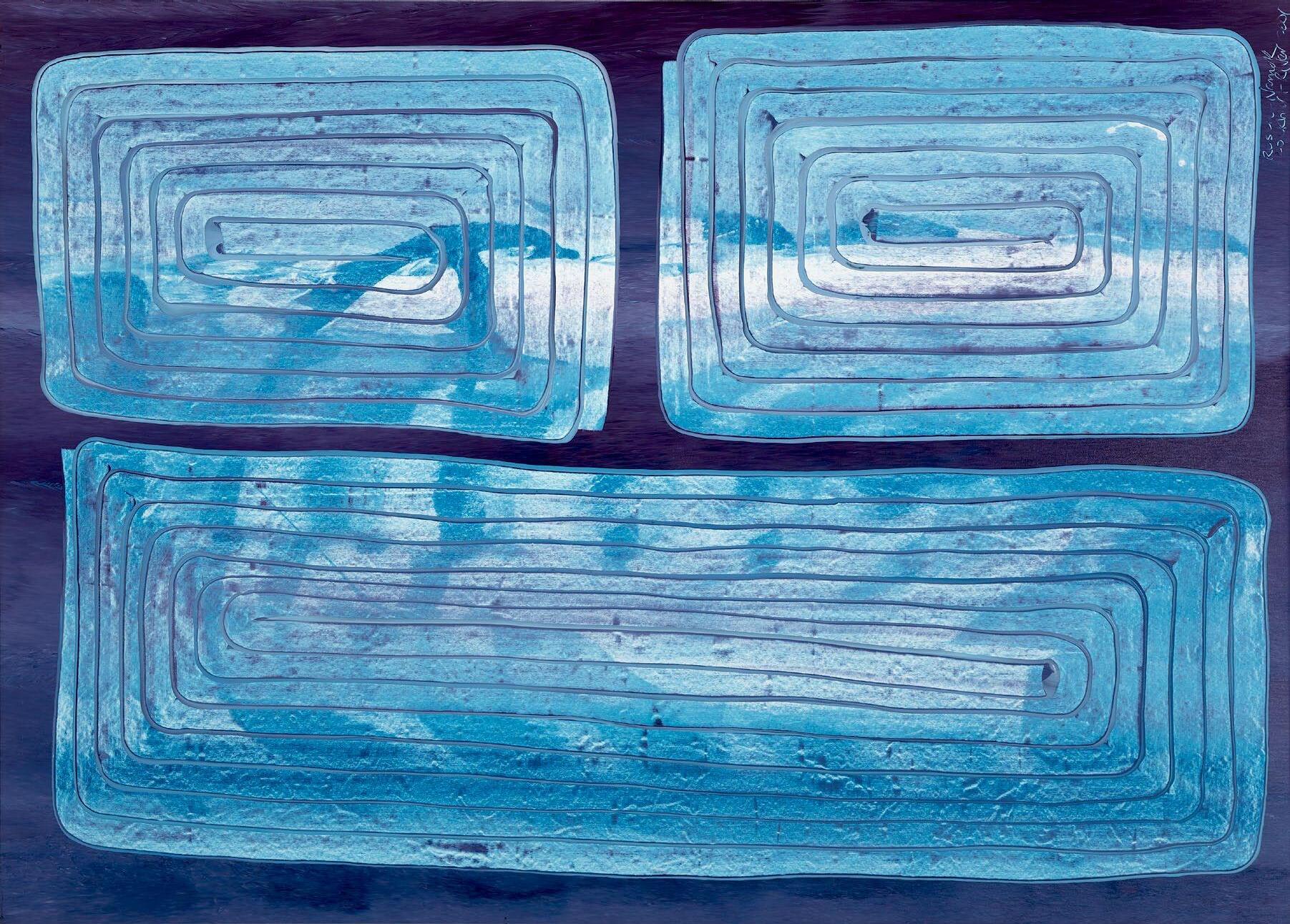
Rosella Namok’s paintings reflect her personal response to the environment, cultural values, and traditional stories of the Lockhart River community on the east coast of Cape York in Far North Queensland.
The ‘culture and stories’ of which Namok paints revolve loosely around her social and physical or natural environment featuring events such as hunting and fishing expeditions, weather patterns of rain and wind, or the stories of Kapay and Kuyan, the two opposing moieties that govern marriage relations in Namok’s Ungkum community. Also apparent in Namok’s work are themes relating to traditional knowledge of country including kinship relations as well as tribal law as it affects both the individual and their community. In fact, it was her wish to explore and establish her correct lineage, her ‘right place’ within the whole, that initially sparked much of the imagery that takes shape throughout the entire scope of Namok’s art.
UNTITLED, 2006
76 x 101 cm; 82 x 107.5 (framed) synthetic polymer paint on Belgian linen
EST $4,000 - 6,000
Agathon Galleries, NSW Cat No. AGND1206060014 Private Collection, NSW Lawson~Menzies, Sydney, NSW, November 2007, Lot No. 52A Menzies Estate Collection, VIC
Accompanied by a certificate of authenticity from Agathon Galleries
Senior Pitjantjatjara elder Tommy Watson, was in his 70s when he began painting on canvas in 2001, and by the time this small work was created in 2006, he had taken the Indigenous art world by storm.
Watson became renowned for works that conveyed immense visual power through rich but minimal colour fields that explored the terrain of his homeland, Anamarapiti, in the far reaches of the Western Desert. Judith Ryan, the senior curator of Indigenous art at the National Gallery of Victoria, was the first to note that Watson’s ‘incandescent’ work was ‘inward and liturgical’ in common with the early boards of the Pintupi men who founded the Western Desert art movement.

79
JUDY NAPANGARDI WATSON (c.1925 - 2016)
SNAKE VINE, 1995
203 x 109 cm synthetic polymer paint on canvas
EST $9,000 - 12,000
PROVENANCE
Kimberley Art, Vic Cat No. KAJW 04/95 Private Collection, Vic Lawson~Menzies, Sydney, NSW, 30 May 2006, Lot No. 151 Menzies Estate Collection, Vic
Warlpiri artist Judy Napangardi Watson was born in 1925 at Yarungkanji, Mt Doreen Station. She grew up living a traditional lifestyle, travelling extensively with her family on foot across their Ancestral country on the border of the Tanami and Gibson Deserts in the Northern Territory. Long periods of time were spent living at Mina Mina and Yingipulangu, country rich in food sources and Jukurrpa (Dreaming).
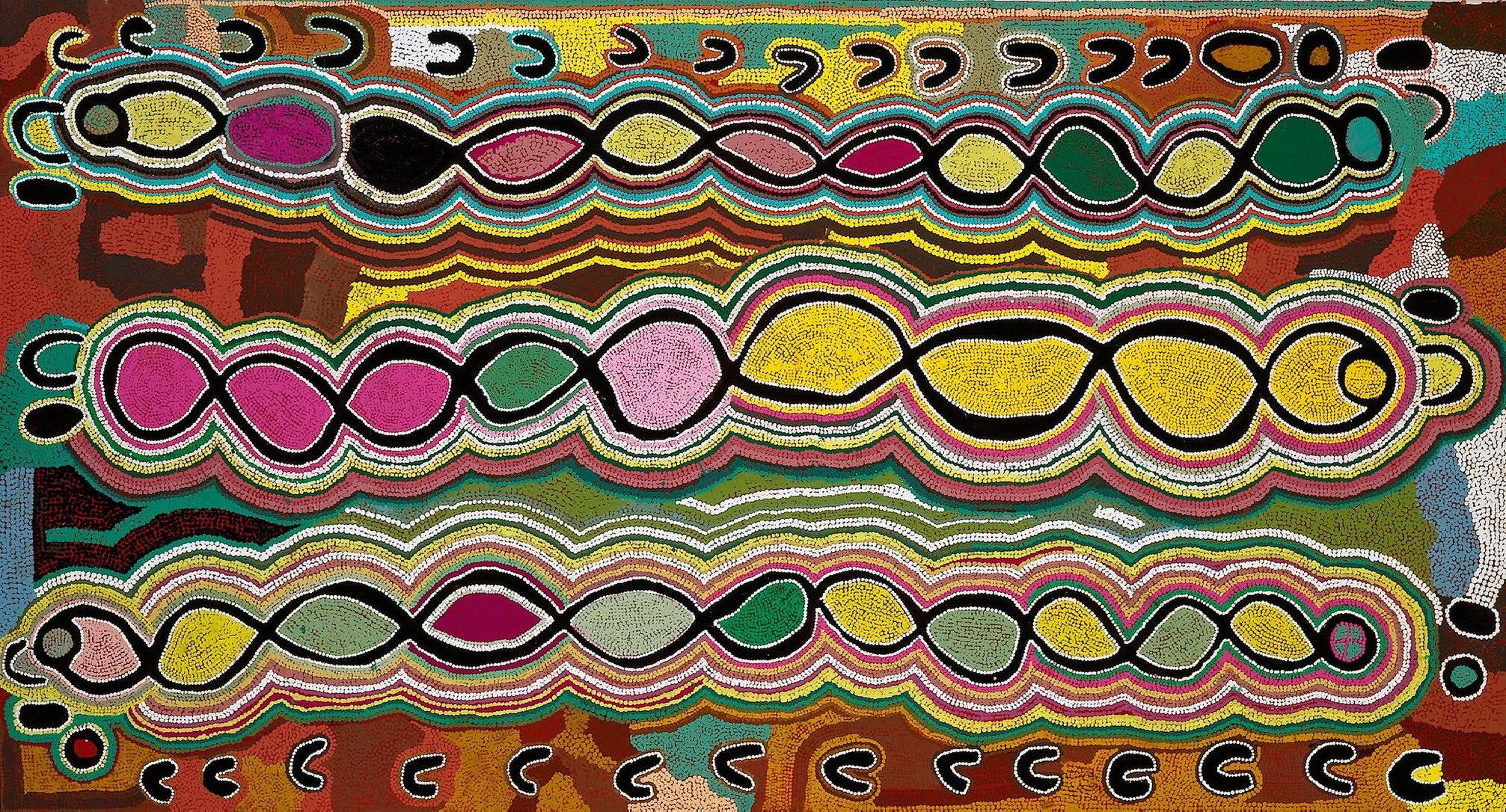
Judy began her artistic life in the mid 1980s, developing her own unique style after initially learning to paint from her elder sister, Maggie Napangardi Watson. The sisters painted alongside one another for several years at the Warlukurlangu Art Centre, which has become known for its many female artists, vibrant use of colour and large collaborative projects.
The Snake vine (Ngalyipi) is an important ceremonial item used to bind branches and feathers to the dancers’ bodies. It grows on and around gum trees, and in ceremonial contexts is associated with the initiation of young Japangardi and Japanangka men. It is also used to make shoulder straps for carrying water and food containers, as well as for medicinal purposes. The plant can be made into a tourniquet for curing headaches and as a bandage for cuts and sores.
JULIE DOWLING (1969 - )
BURRUP (TRIPTYCH), 2012
91.5 x 122 cm (each) ); 91.5 x 366 cm (total) synthetic polymer paint and red ochre on canvas
EST $5,000 - 7,000
PROVENANCE
Gift from the artist to the Burrup World Heritage Fighting Fund, WA Lawson~Menzies, Sydney, NSW, November 2013, Lot No. 57 Menzies Estate Collection, Vic
EXHIBITED
Australian Indigenous Art Triennial: Culture Warriors, National Gallery of Australia, Canberra, 13 October 2007 - 10 February 2008
Besides portraiture, for which she is best known, Julie Dowling’s work also bears broader significance, exploring contentious social and political issues including the ‘stolen generation, Native Title, and the environmental effects of pollution. Her subjects are always potent with political meaning and her style is always direct and confrontational, but not hostile.
This theme was included in Julie Dowling’s work for the Australian Indigenous Art Triennial: Culture Warriors at the National Gallery of Australia in 2008 and directly confronts the toxic emissions being released into the atmosphere, by Woodside Energy’s Burrup Hub project in North Western Australia. It was donated by the artist to raise funds to support this important environmental cause.

LONG TOM TJAPANANGKA (1930 - 2006)
SNAKE TRAVELLING WEST, 1999
121.5 x 214 cm synthetic polymer paint on Belgian linen
EST $6,000 - 8,000
PROVENANCE
Jinta Desert Art Gallery, NSW Cat No. SN-3279
Private Collection, NSW
Lawson~Menzies, Sydney, NSW, November 2006, lot 34 Menzies Estate Collection, Vic
Accompanied by certificate of authenticity from Jinta Desert Art
Cf. for a comparative work see: ‘Tradition Today, Indigenous Art in Australia’, Art Gallery of NSW, 2004,154-155
Long Tom Tjapanangka was born in 1929 at the Meereni range south of Haast Bluff settlement. His childhood was coloured by trips on foot across the vast desert regions along the border of Western Australia, to a small community near Alice Springs known as Areyonga. As a young man he was a skilled stockman and later became a masterful “tracker” working with police to track down fugitives.
When he began painting in 1993, his childhood experiences of travelling across desert served him well. It did not take him long to establish his career as an artist. He won the Northern Territory Art Award and the Australian Heritage Art Award, Canberra in 1994; the Alice Springs Art Prize in 1996; and the National Aboriginal and Torres Strait Islander Art Award in 1999. In 2000 he was represented in the Adelaide Biennale.
In this painting, the carpet snake, is travelling west of Irantji Range to Mikarnta waterhole. The hills are the metamorphosed backs of a band of Emu ancestors that travelled along this route during creation. The waterhole has a spring with running water which, although not visible in the painting, is the subject of important men’s law, a fact that was foremost in the artist’s mind when rendering the image.

TINGARI, 2002
183 x 153.5 cm natural earth pigments on Belgian linen
EST $4,000 - 6,000
PROVENANCE
Yapa Art, NT Kimberley Art, Vic Cat No. RT 200213
Menzies, Australian & International Art, Sydney, NSW, March 2010, Lot No. 147 Menzies Estate Collection, Vic
Ronnie Tjampitjinpa’s works first appeared in Papunya Tula exhibitions during the 1970s, and later in commercial art galleries in Sydney and Melbourne throughout the 1980s. He won the Alice Springs Art Prize in 1988 and this was followed by successive solo exhibitions at Gallery Gabrielle Pizzi in 1989 and 1990.
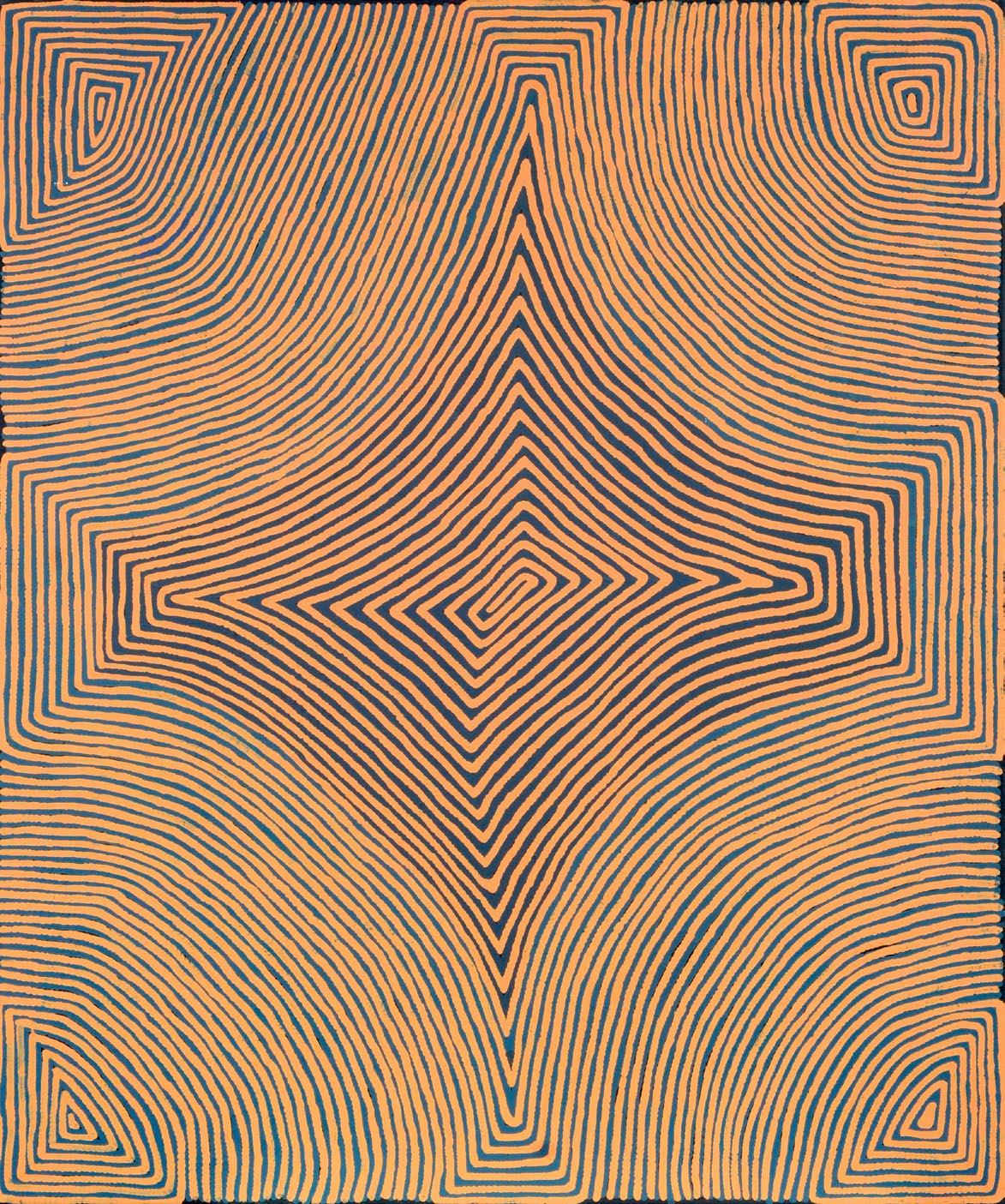
His reductive, linear works first appeared in the mid 1990s. While it may be challenging to reconcile these contemporary images with their traditional content, the overall shimmer he effects with seemingly minimal application radiates the artist’s authority and self-assuredness.
This painting represents a site on the Tingari creation songline. Since events associated with the Tingari cycle are of a secret nature no further details are given.
NAMARARI TJAPALTJARRI (1926 - 1998)
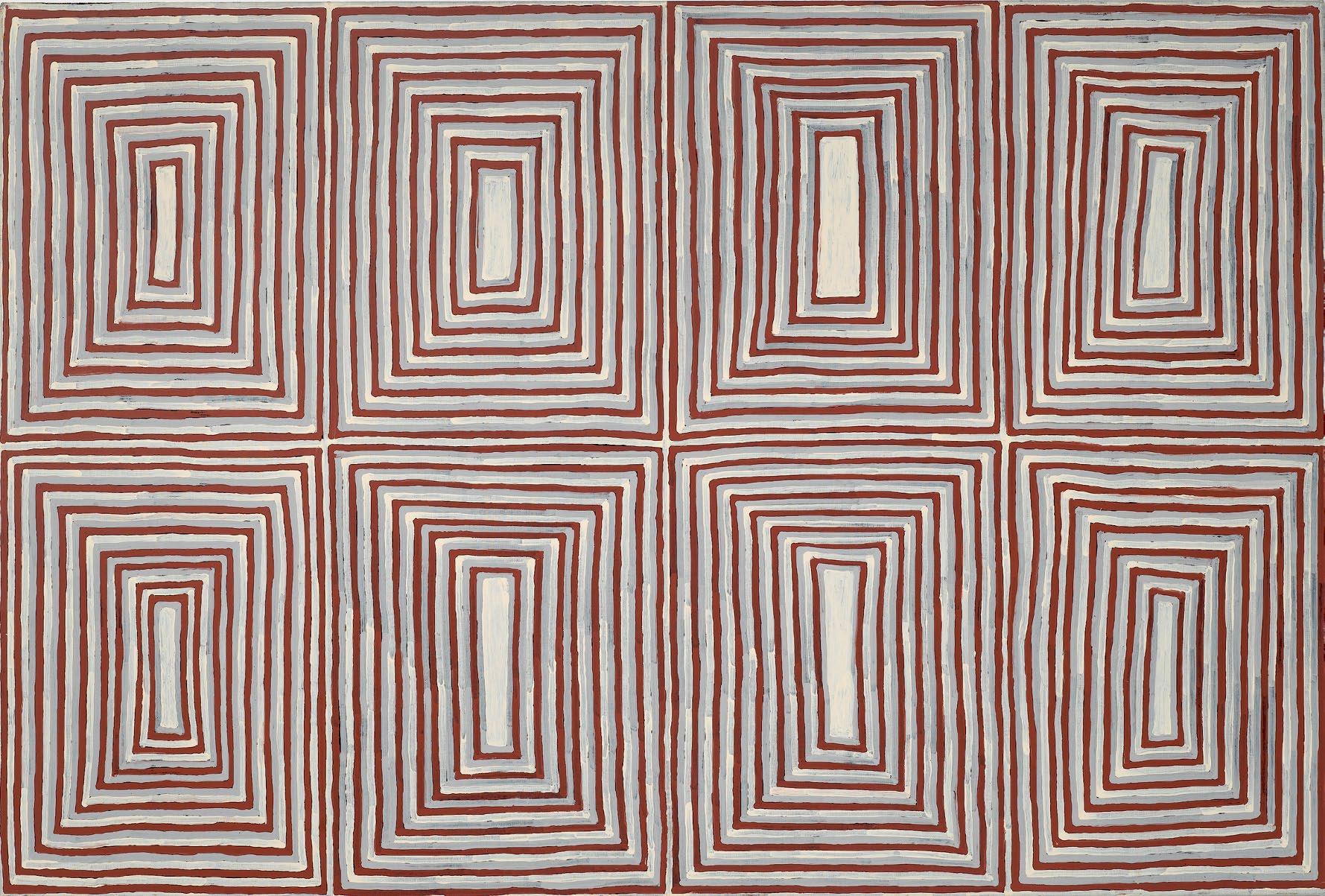
TINGARI, 1995 120 x 179 cm synthetic polymer paint on canvas
EST $12,000 - 16,000
Yapa Art, NT Kimberley Art, Vic Cat No. KA00254 Isarte Collection, Milan, Italy Lawson~Menzies, Sydney, NSW, May 2007, Lot No. 72 Menzies Estate Collection, Vic
Mick Namarari was born at Marnpi, south west of Mount Rennie and was on the Papunya community council when Geoff Bardon arrived there to teach art in 1971. He was one of the first to express an interest in painting for Bardon and was a founding member of Papunya Tula Artists upon its establishment during the following year.
Namarari was a prolific painter during the 1980s and, toward the end of his career in the mid-1990s, his works tended to become more atmospheric and minimalist than the figurative and iconographic imagery that characterised his earlier work. By referring to the designs originally incised on ceremonial objects such as hair pins and churungas, Namarari, along with George Tjungurrayi and Ronnie Tjampitjinpa, were foremost amongst those Pintupi male artists who advanced the perception of their art during the 1990s.
MICK NAMARARI TJAPALTJARRI (1926 - 1998)
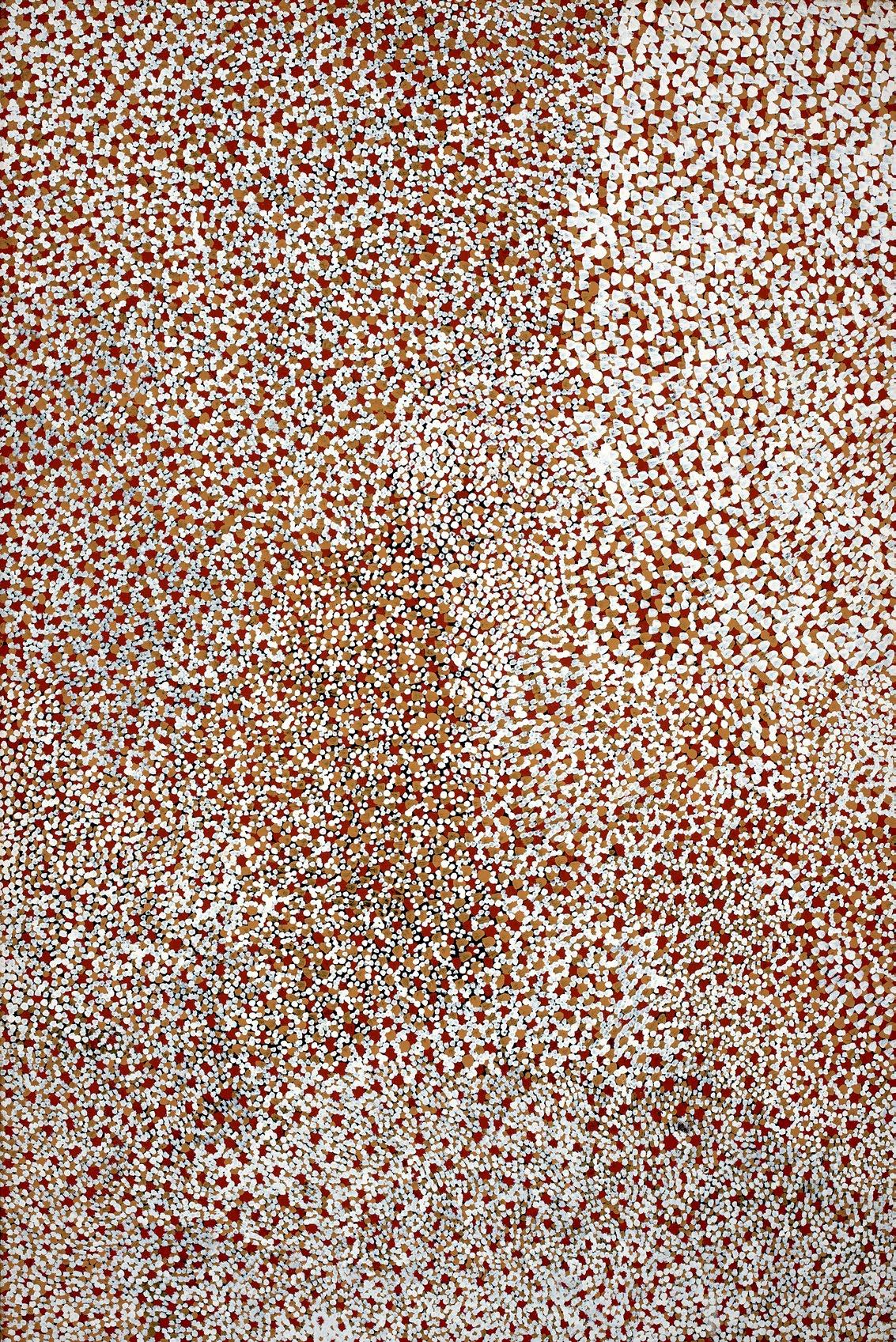
MOUSE STORY (DREAMING), 1997
182.5 x 122 cm synthetic polymer paint on Belgian linen
EST $3,000 - 6,000
PROVENANCE
Warumpi Arts, NT Cat No. KAMNT 003/97
Kimberley Art, Vic Cat No. KA00517
Lawson~Menzies Important Aboriginal, Sydney, NSW, June 2009, Lot No. 183
Menzies Estate Collection, Vic
Accompanied by certificates of authenticity from Warumpi Arts and Kimberley Art and 1 photograph of the artist holding the painting
This painting was completed a year before Mick Namarari’s death is an outstanding example of his later style, which, while deceptively simple in its execution, has a powerful inherent energy resulting in a painted surface which pulsates and oscillates, drawing the viewer’s eye through a complex and masterful visual landscape.
The story depicted is the Mouse Dreaming at Tunginpa, a hill north west of Kintore. The overall dotting represents the footprints of each mouse and of Kampurarrpa, an edible berry, which is eaten by the mouse. Men of the Tiapaltiarri kinship are custodians for the ceremonies associated with this mythology.
CLIFFORD POSSUM TJAPALTJARRI (1932 - 2010)

ROCK WALLABY AND POSSUM DREAMING, 1996
82 x 152 cm synthetic polymer paint on canvas
EST $16,000 - 22,000
Commissioned by Des Rogers,Vic Cat No. DRSN204 Aboriginal Arts Australia, Alice Springs, NT Private Collection,Vic Lawson~Menzies, Sydney, NSW, May 2005, Lot No. 81 Menzies Estate Collection,Vic
Clifford Possum’s unique artistic style is characterised by an innovative use of spatial configuration. Throughout the 1980s and 1990s he continued to compile a powerful body of work which was most notable for its brilliant manipulation of three-dimensional space and the introduction of western iconography and figurative imagery, which stood out from a background of highly descriptive dotting in order to convey certain elements in his narratives.
The Dreaming stories depicted in this magnificent work include Mala (Rock Wallaby) associated with Marrunga west of Mount Wedge and its travels south west to Ayres Rock and Pitjantjatjarra country. The concentric circles are their campsites. These two old men were of the Tiangala kinship group and whilst at this site they led young initiates through part of the law. The travels of Tjukunypa, the Possum ancestors, both on top of and underneath the ground, in and about the area known as Tuirri on nearby Napperby Station, is also included. The undulating lines are the tracks of the possum’s tails, which are flanked by their characteristic, paw marks. Dingo Dreaming also passes through this country.
86
RONNIE TJAMPITJINPA (c.1943 - 2023)
TINGARI, 1994/1995 120 x 182 cm synthetic polymer paint on Belgian linen
EST $5,000 - 7,000
Yapa Art, NT
William Mora Gallery, Vic Menzies Estate Collection, Vic
Although he began painting in the early 1970s, Ronnie Tiampitinpa’s reductive, linear works first appeared in the mid 1990s. While it may be challenging to reconcile these contemporary images with their traditional content, the optical effect created through minimal application, speaks to the artist’s authority and self-assuredness.
This painting represents an aspect of the Tingari creation cycle. The design elements refer to an old Tingari Woman and her Two Children, who represent thunder and lightning. They travelled from the north to Wilkinkarra (Lake Mackay).The Old Woman made her camp on the south side of Lake Mackay, while thunder and lightning continued to travel southward.
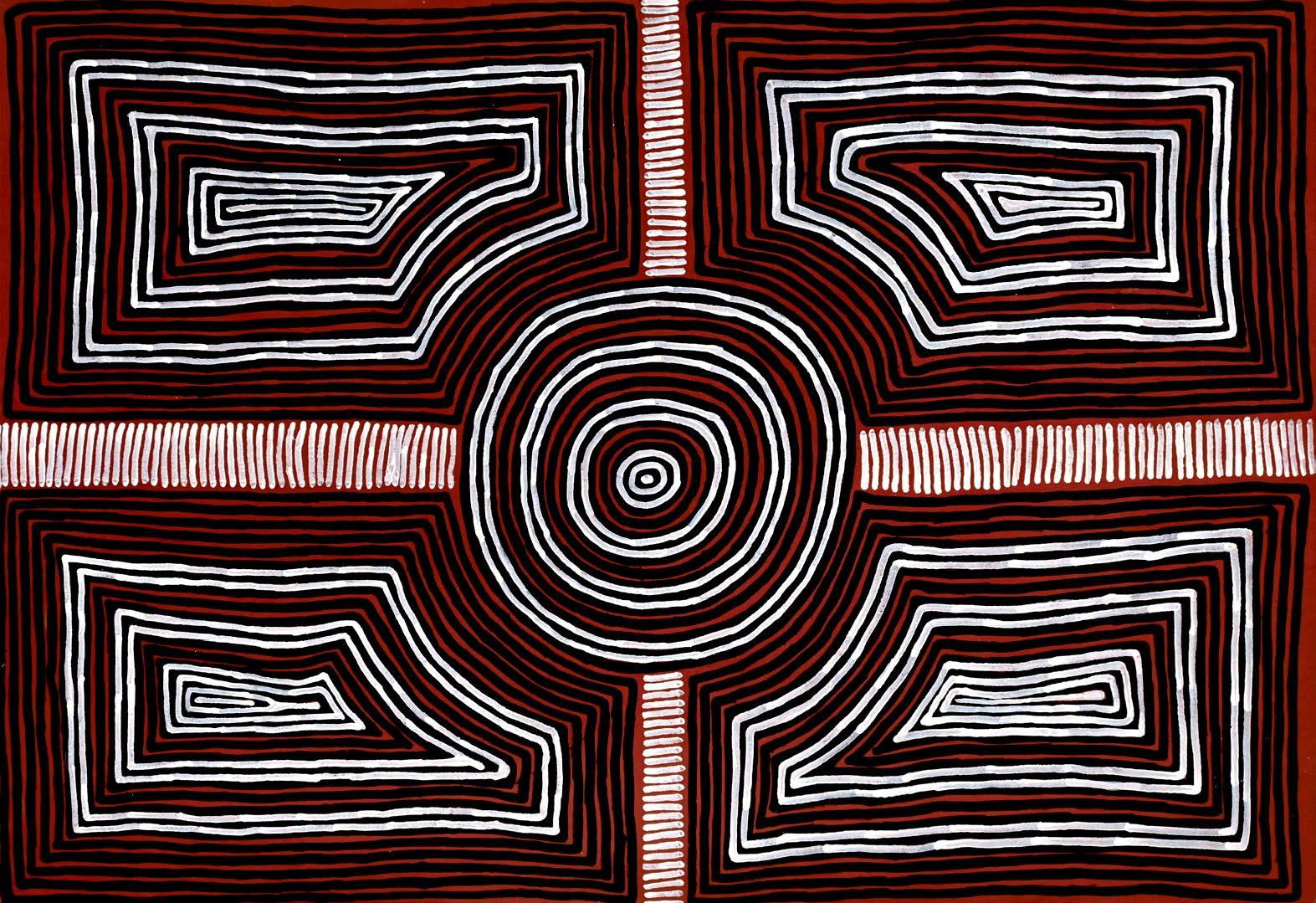
87
TURKEY TOLSON TJUPURRULA (1942 - 2001)
UNTITLED (SPEAR DREAMING), 1995
137 x 87 cm synthetic polymer paint on Belgian linen
EST $2,500 - 3,500
PROVENANCE
Aboriginal Galleries of Australia, Vic Cat No. AGA6387 Private Collection, Vic Lawson~Menzies, Sydney, NSW, February 2011, Lot No. 231 Menzies Estate Collection, Vic
EXHIBITED
Icons of Australian Aboriginal Art, Australian High Commission, Singapore, 2001; The Art Centre of Christchurch, New Zealand, 2003
Turkey Tolson Tjupurrula was among the first of a slightly younger generation of artists who began painting at Papunya in 1973. From the outset he was distinguishable as one of the centres most innovative artists.
Tolson introduced his Spear Straightening imagery around 1990 and returned to it again and again thereafter. In the Dreaming, the artist’s ancestors, the Mitukatjirri Men, travelled from a claypan at Tjukula to llyingaungau, a rocky outcrop far to the west of Alice Springs, where they made camp. At this time a group of men entered the country from Tikari to the north. A fight ensued after which the Mitukatjirri Men travelled to the nearby cave where they made their ceremonies.
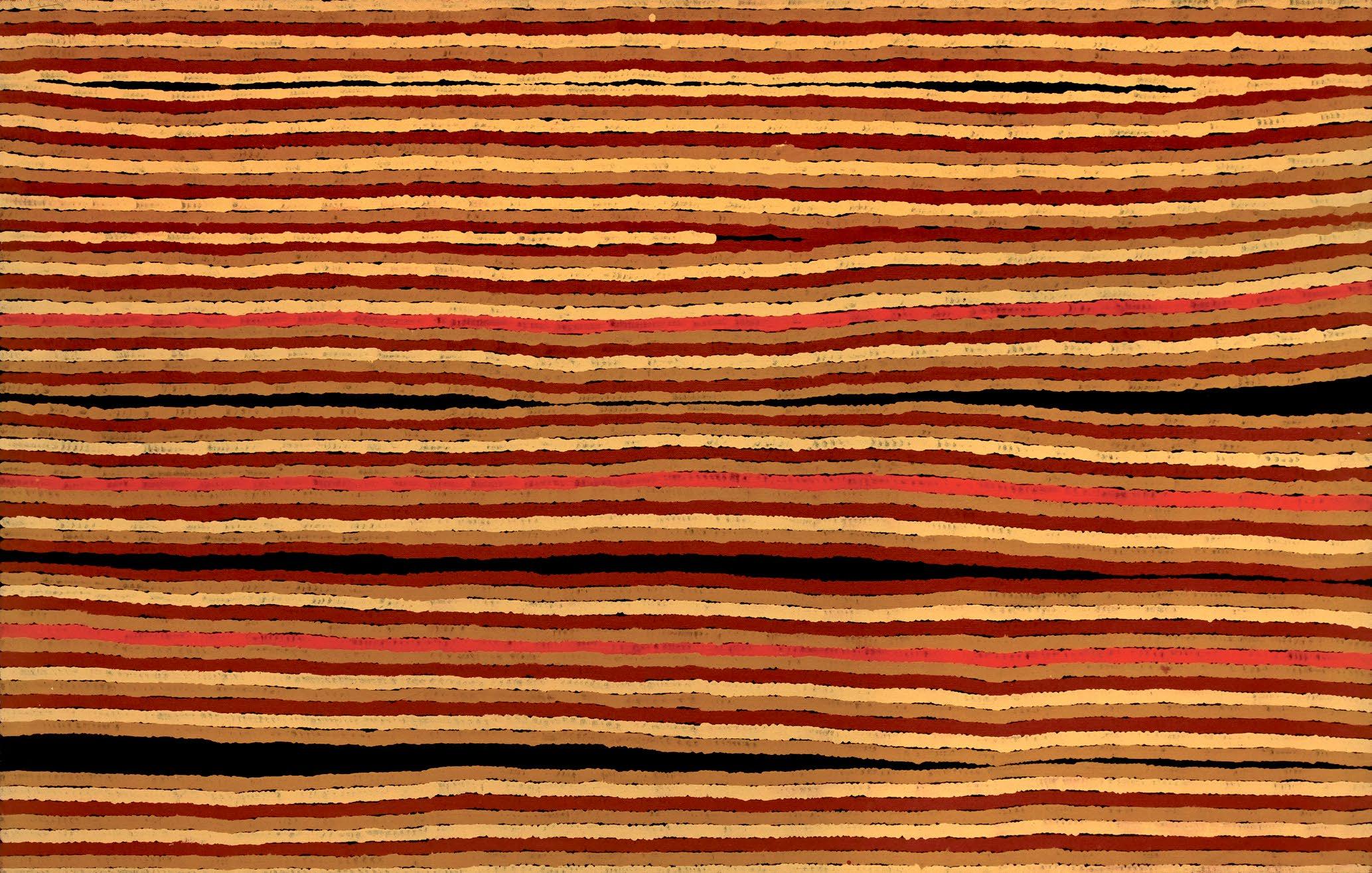
The parallel bands represent spears which the men straightened by warming the wood over a fire, bending them in to shape as they waited for the men from Tikari to arrive.
The painting evokes the shimmering heat and vast distances of the artist’s country.
ALICE NAMPITJIMPA (1945 - 2020)
TALI - SANDHILLS, 2004 122 x 166 cm synthetic polymer paint on Belgian linen
EST $2,000 - 3,000
PROVENANCE
Ikuntji Art Centre, NT Cat No. IK05AN270
Kimberley Art, Vic Cat No. KA00514
Lawson~Menzies, Important Aboriginal Art, Sydney, NSW, June 2009, Lot No. 200 Menzies Estate Collection, Vic
Accompanied by certificate of authenticity from Ikuntji Art Centre and Kimberley Art
Alice Nampitjinpa was born in 1943 near Talaalpi, a swamp in the desert near the Western Australian border. Her father was Uta Uta Tjangala, who was one of the original Papunya Tula painters.

Alice began painting during the Kintore Haasts Bluff collaborative canvas project in 1993 inspired by her rich cultural heritage, stories and lore.
Her main story is the porcupine (Tjilkama) which lives in the sand hills (Tali) north west of Kintore. Etched through the tali are the marks left by hairstring bags dragged across country by the men whilst out hunting. Her use of bright colours such as orange and yellow mirror the ochres that are used in ceremonial body painting.
89
GREENY PURVIS PETYARRE (1930 - 2010)
YAM DREAMING, 2001
264 x 120 cm synthetic polymer paint on canvas
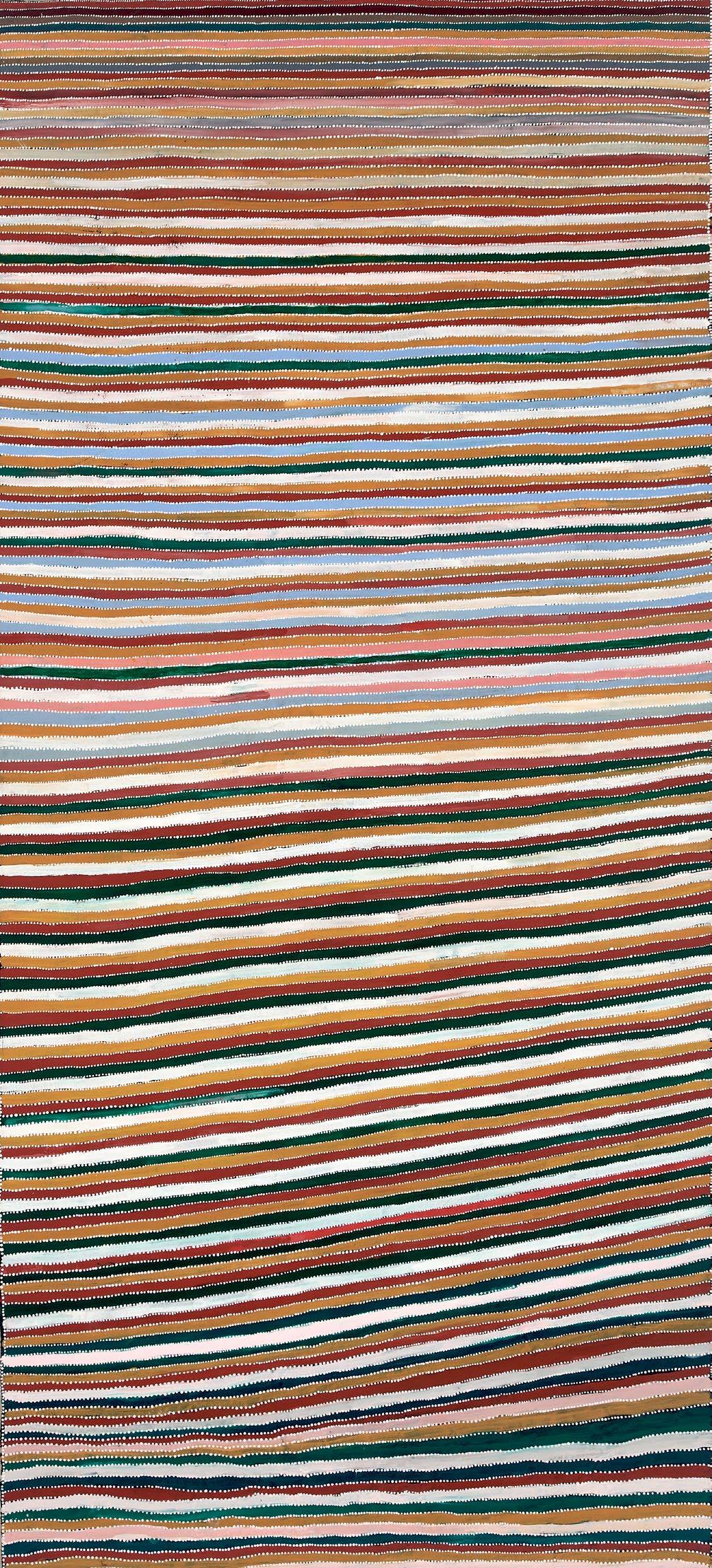
EST $1,800 - 2,200
PROVENANCE
Mbantua Gallery, NT Cat No. MB012829
Private Collection, NT Lawson~Menzies, Sydney, NSW, May 2006, Lot No. 64 Menzies Estate Collection, Vic
The artist was a highly respected elder in Utopia and the nephew of the late Emily Kngwarreye. His paintings reflect his unpretentious personality: quietly unassuming but emanating a feeling of endurance and respect.
In this painting the artist portrays elements associated with the Yam Dreaming in colours that indicate the different stages and seasons in the growth and appearance of the yam seed as it matures.
90
MINNIE PWERLE (1910 - 2006)
AWELYE ATNWENGERRP , 2000 126.5 x 95.5 cm synthetic polymer paint on canvas
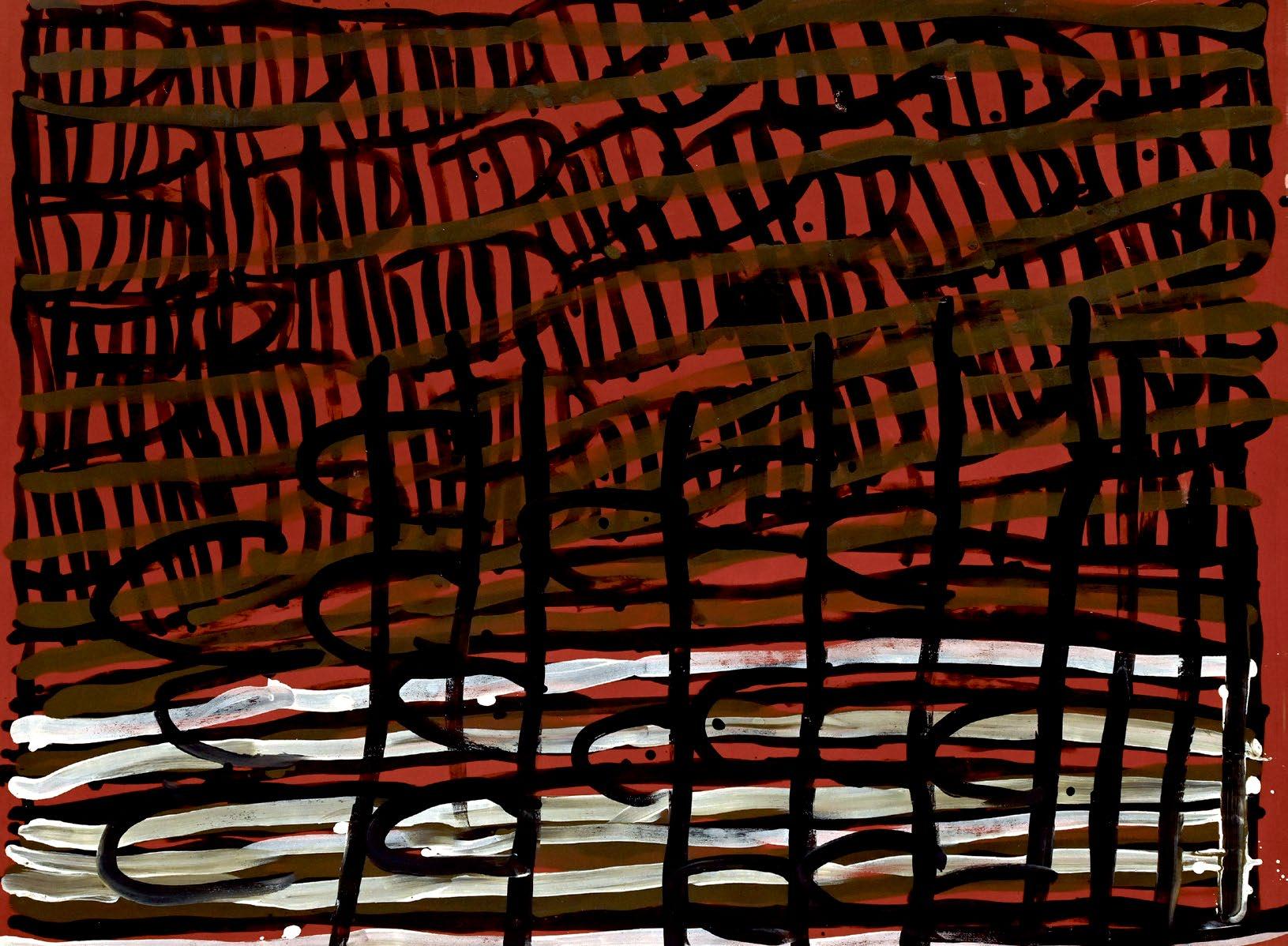
EST $3,500 - 4,500
Dacou Gallery, SA Private Collection, NSW Lawson~Menzies, Sydney, NSW, 23 May 2007, Lot No. 169 Menzies Estate Collection, Vic
Accompanied by a certificate of authenticity from Dacou Gallery
Minnie was born at Atnwengerrp in the Utopia region and her husband was the brother of the famed artist Emily Kame Kngwarreye. While Minnie resembled Emily in her body paint and gestural vigour, her Dreaming and the subject of her art was the bush melon and its seed, rather than the yam or ‘bush potato’.
The bush melon fruit is collected by women and eaten immediately or cut into pieces, skewered on pieces of wood and then dried to be eaten over the coming months when bush tucker is scarce. The tiny melon bush with its sweet fruit was once abundant and fruiting in the summer season, but is now hard to find.
In this work, lines represent the breast designs painted on the top half of the women’s bodies during ceremonies enacted to ensure the bush melon’ abundance.
REGINA
BASKET WEAVING, 2004
92 x 67.5 cm synthetic polymer paint on Belgian linen
EST $1,200 - 1,800
Peppimenarti Community Council, NT Agathon Gallery, NSW Cat No. 17 Private Collection, NSW Lawson~Menzies, Sydney, NSW, February 2011, Lot No. 212 Menzies Estate Collection, Vic
Accompanied by a certificate of authenticity from Peppimenarti Community Council
Regina Pilawuk Wilson is a Ngan’gikurrungurr woman from the Daly River region in the Northern Territory who has exhibited her paintings both nationally and internationally, since winning the General Painting category at the Telstra National Indigenous and Torres Strait Islander Award in 2003.
Beyond her unique aesthetic, there lies a history of community service and leadership. Together with her late husband, Harry Wilson, she was the founder of the Peppimenarti community, and a fierce advocate for Durrmu Arts and the wider Indigenous arts sector.
From a distance Regina Wilson’s works appear as ethereal textures created through subtle plays of colour, yet on closer inspection, intricate weaving patterns breathe through her paintings as if this master weaver were speaking directly to the viewer.

92
ROMA NYUTJANGKA BUTLER (1959)
WATI, MINYMA, TIITJI, 2005 147x 94.5 cm synthetic polymer paint on canvas
EST $3,000 - 3,500
PROVENANCE
Irrunytju Arts, WA Cat No. IRR05442
Vivien Anderson Gallery, Vic Lawson~Menzies, Australian Aboriginal Art, Sydney, NSW, November 2007, Lot No. 99

Menzies Estate Collection, Vic
EXHIBITED
Xstrata Coal Emerging Indigenous Art Award 2006, Queensland Art Gallery, Brisbane, Qld
Pitjantjatjarra artist Roma Bulter was born in 1959 at Wilu rockhole and grew up at Ernabella mission in S.A. After travelling as a child by camel to Warburton, she went to the mission school before settling on her grandfather’s country at Irrunytju (Wingellina) in the Goldfields-Esperance region in Western Australia.
The title of this work Wati, Minyma, Titji literally means man, woman and child in the Anangu language. However, these terms imply that the man and woman are fully initiated custodians, and are recognised as having ritual authority within their community and tribe.
Having undertaken religious ‘rites of passage’ they know a vast array of songs, stories and dances and have visited special places of power - sacred siteswithin their country, such as the site depicted in this important work.
93
TIMOTHY COOK (1958 - )
JILAMARA DESIGN, 2001
87.5 x 79.5 cm natural earth pigments on Belgian linen
EST $600 - 800
Jilamara Arts and Crafts, NT Cat No. 529-01 Lawson~Menzies Australian Aboriginal Art, Sydney, November 2007, Lot No. 326 Menzies Estate Collection, Vic
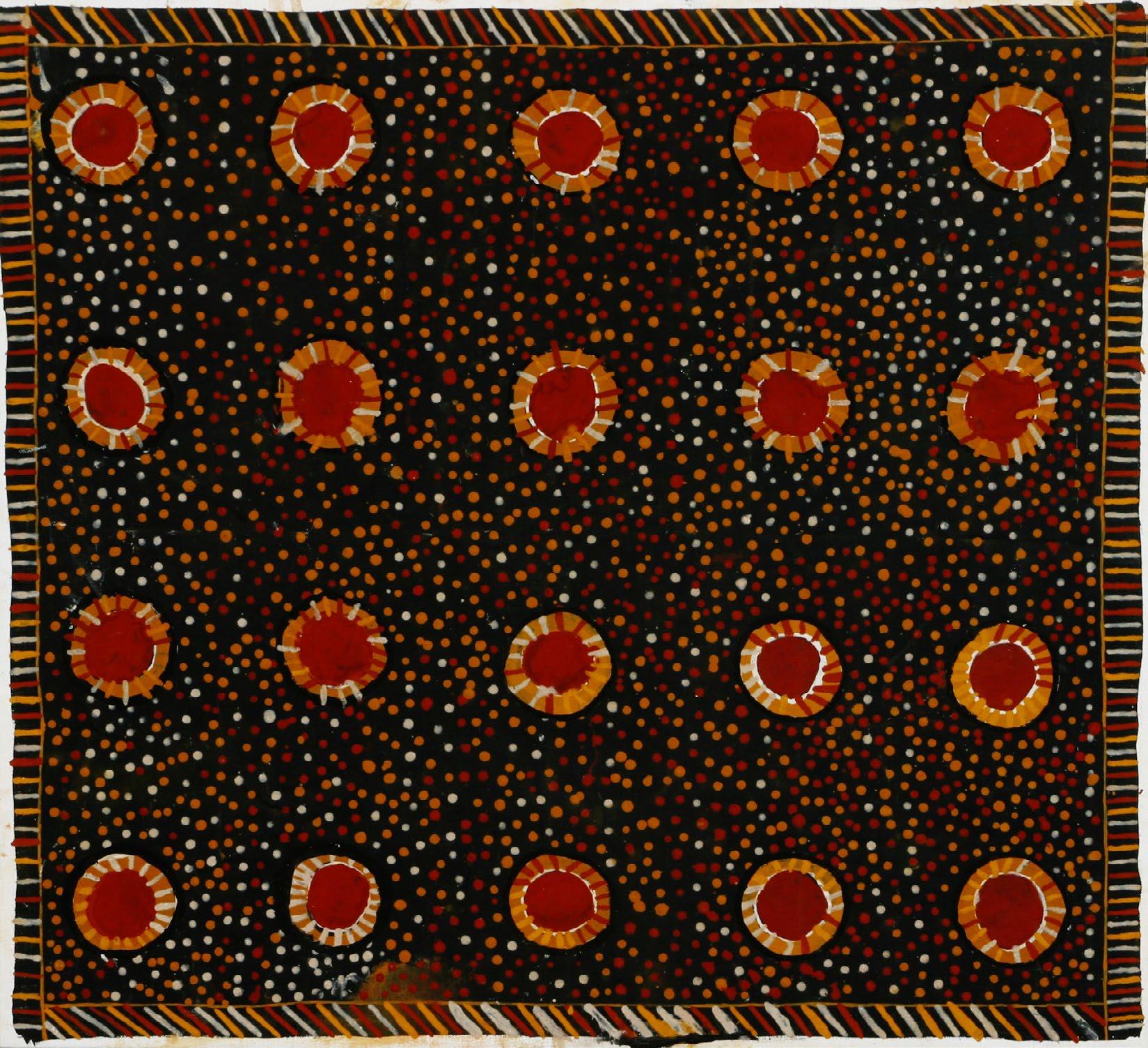
Born 1958 on Melville Island,Timothy Cook began painting in the mid 1990s and quickly became one of the most radical interpreters of early Tiwi works.
The traditional Tiwi ceremony of kulama (or yam) is a recurrent subject in Cook’s work, and its circular motif has several echoes in Tiwi culture. This ceremony is a coming-of-age ritual that occurs when the kulama yams are harvested. It is performed in the early dry season around a circular fire-pit when a conspicuous halo appears around the full moon.Elders of both sexes sing and dance for three days welcoming the boys into adulthood. The boy is then renamed with his true man’s name. The moon is a potent metaphor for life and death in the Tiwi Islands. It is home to the adulterous Tapara from the Tiwi mortuary narrative of Pukumani, which also features Purukapali, his wife Waiyai, and their baby son Jinani.
Timothy is renowned for paintings in natural earth pigment characterised by loose, gestural, spacious designs. These are composed with pure instinct and without hesitation.
JILAMARA, 1997
EST $700 - 900
Jilamara Arts & Crafts, NT Private Collection, NSW Lawson~Menzies, Sydney, NSW, May 2005, Lot No. 163 Menzies Estate Collection, Vic
Born in the bush on Melville Island, Freda had only painted for ceremonies under the influence of her father, who created designs on ceremonial Pukumani poles, prior to 1996. She was already 68 and frail when she created her first canvases and works on paper at Jilamara Arts.
From the outset, her favourite subject was the Japartinga tree orchid, a delicate small blossom that grows in the bush during the dry season. The designs associated with this plant were carefully applied, through deliberate, methodical, brush strokes and combinations of dots, lines, and blocks of colour which imbued her artworks with their rhythm, movement, and energy.
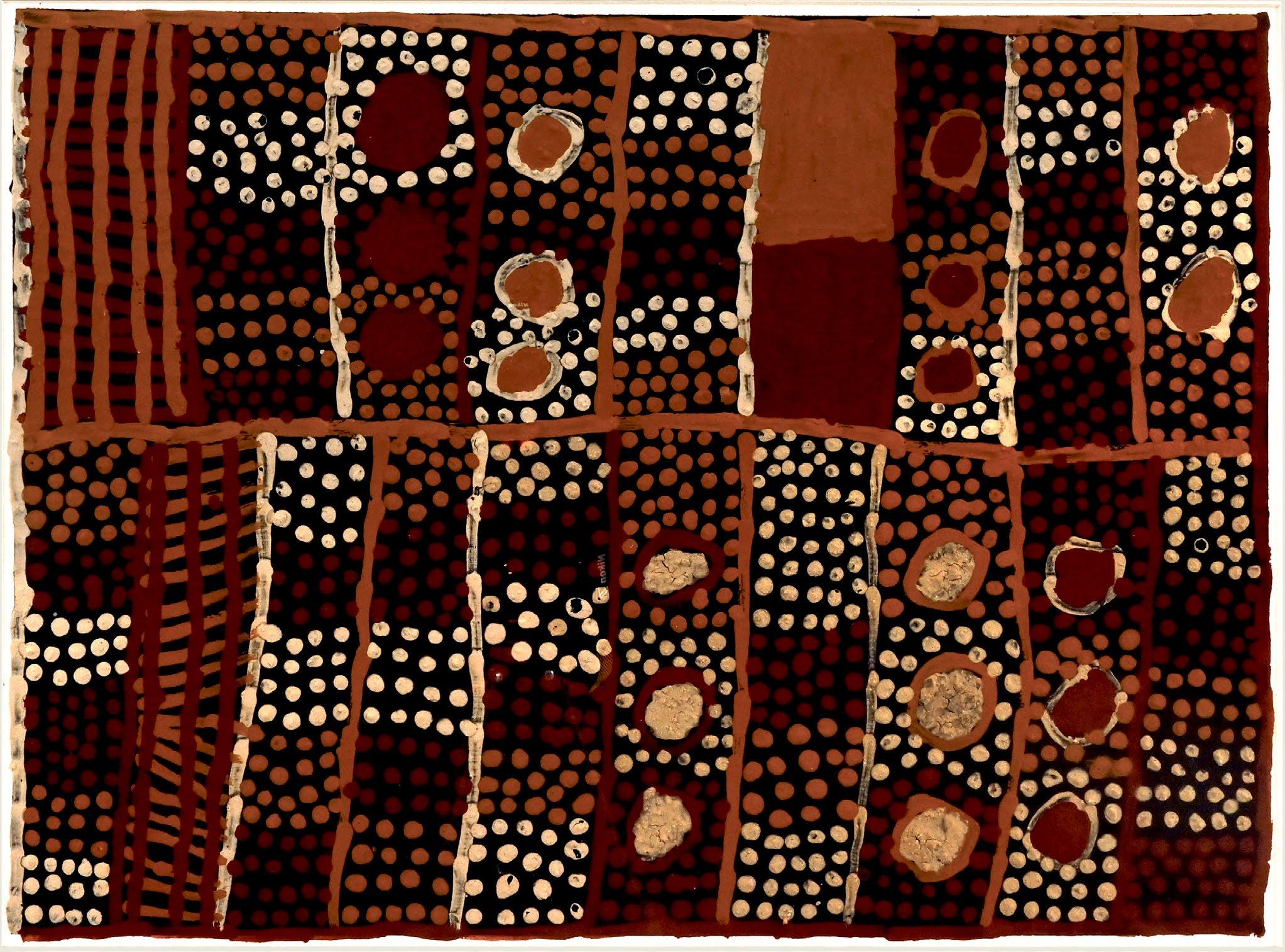
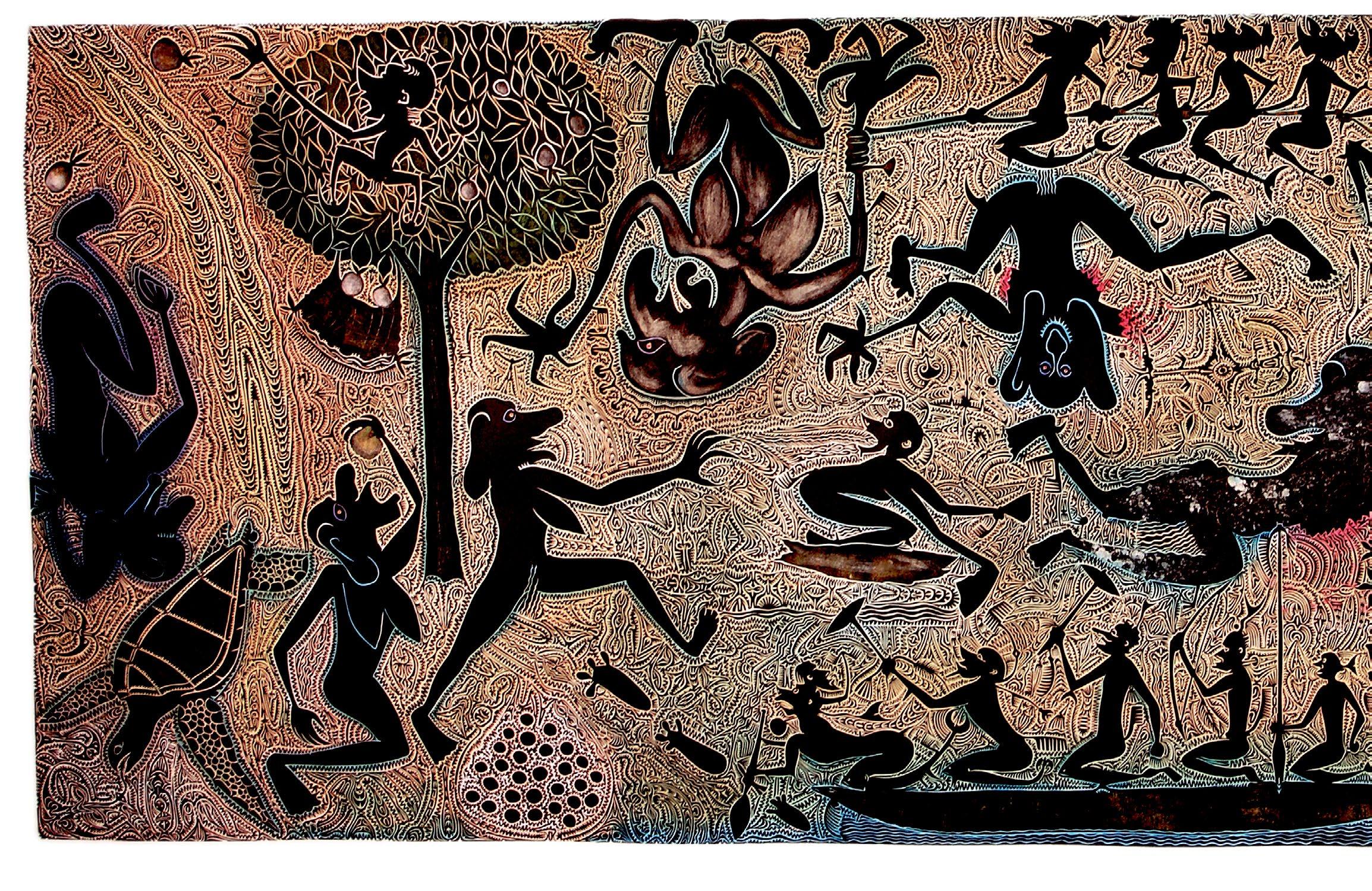
95
DENNIS NONA (1973 - )
DHOGAI ZUG, 2005
108 x 260 cm hand-coloured linocut
EST $3,000 - 5,000
Studio Editions Tremblay NFP, Qld Aboriginal Art Print Nework, NSW Cat No.DN090 Private Collection, NSW Lawson~Menzies, Sydney, NSW, November 2007, Lot No. 74 Menzies Estate Collection, Vic
Born on Badu Island in 1973 Nona was taught traditional woodcarving as a young boy. He began his artistic career in 1989 and pioneered the development of the highly intricate linocut prints and the graphic storytelling that has become unique to the Torres Strait Islands.
In prints such as this, Nona relates the entire narrative with all the characters and events in one image. To link the work he creates a matrix of delicately lined clan patterning, thereby binding the story to its place of origin. Through this technique, Dennis Nona almost single-handedly sparked a cultural revivification amongst artists in the Torres Strait Islands.

Within Nona’s work there is a celebration of island myths and legends, of how humans, animals, plants, and landscape received their meaning from epic or magical events in the past. It was a society where men, women, sorcerers and witches came to their final grief by being transformed into sea creatures or cast into the sea to become the islands and rocky outcrops evident throughout the Western Torres Strait Islands today.
This particular work relates the story of the Dhogai (witch) who lived on Zurath Island and whose breasts became a rock that can be seen to this day lying in the tidal waters between Zurath and Kulbaikulbai Islands. The detailed narrative is provided in the accompanying documentation.
Dennis Nona was the overall winner of the National Aboriginal & Torres Strait Islander Art Award in 2007 and has won the NATSIA Works on Paper prize on two other occasions.
96
BROOK ANDREW (1970 - )
BLUSH, 2000
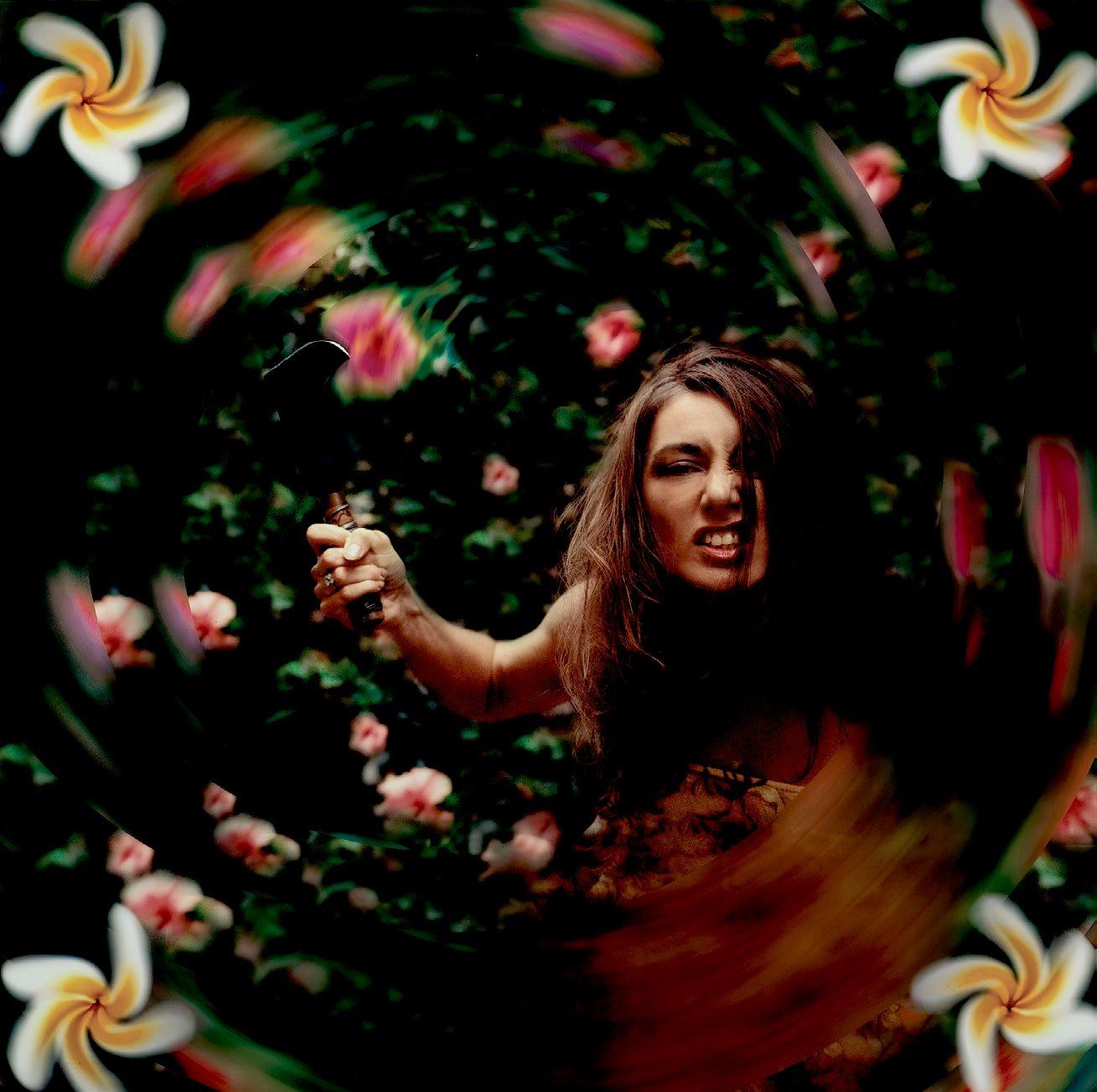
49.5 x 50 cm inkjet print on paper
EST $1,200 - 1,600
Mahoney’s Galleries, Vic (label attached verso) Gallery Gabrielle Pizzi, Vic Private Collection, Vic Deutscher-Menzies, Sydney, NSW, June 2007, Lot No.14 Menzies Estate Collection, Vic
EXHIBITED
POLEMICS Gallery Gabrielle Pizzi & The Woolmark 2000, Melbourne Fashion Festival, Melbourne, February 2000
LITERATURE
Page, M. POLEMICS, Gallery Gabrielle Pizzi, Melbourne, p.2 (illus., p.5)
Through his work, in a variety of areas, Brook Andrew is a fervent and forthright social commentator who explores the history of race relations in Australia, as well as colonialism, ethnography, cultural identity, gender politics, globalisation, and other themes. By employing powerful post-modern imagery, delivered with sociological savvy and slick visual appeal, his highimpact, high-energy works are both beautiful and humorous. Created on a large scale, and produced in a refined yet glossy pop style, his works are provocative, challenging, and visually dynamic.
NYUJU STUMPY BROWN (1924 - 2011)
KINDI - COUNTRY FOR KINDI TREE, 2001 65 x 73.5 cm synthetic polymer paint on canvas

EST $1,000 - 1,300
Mangkaja Arts, WA Cat No. MW0617
Michel Sourgnes Fine Arts, Qld Outback Alive, Qld Lawson~Menzies, Australian Aboriginal Art, Sydney, NSW, November 2007, Lot No. 317 Menzies Estate Collection, Vic
Senior law woman Nyuju Stumpy Brown was a custodian for ancestral lands at Ngapawarlu, in the Great Sandy Desert. During an art career that spanned from the 1980s until 2008, she recreated the desert sites that she knew from her childhood, focusing on the Dreaming stories that belong to Ngapawarlu, Warrawarra, Jirntijirnti and other water sites along the Canning Stock Route.
A large group of ancestral women are said to have passed along this country during the Dreamtime as they travelled toward Alice Springs. The rock holes are surrounded by sandhill country scattered by small trees.




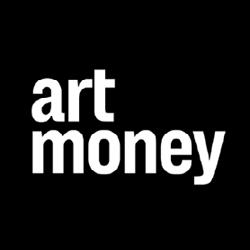
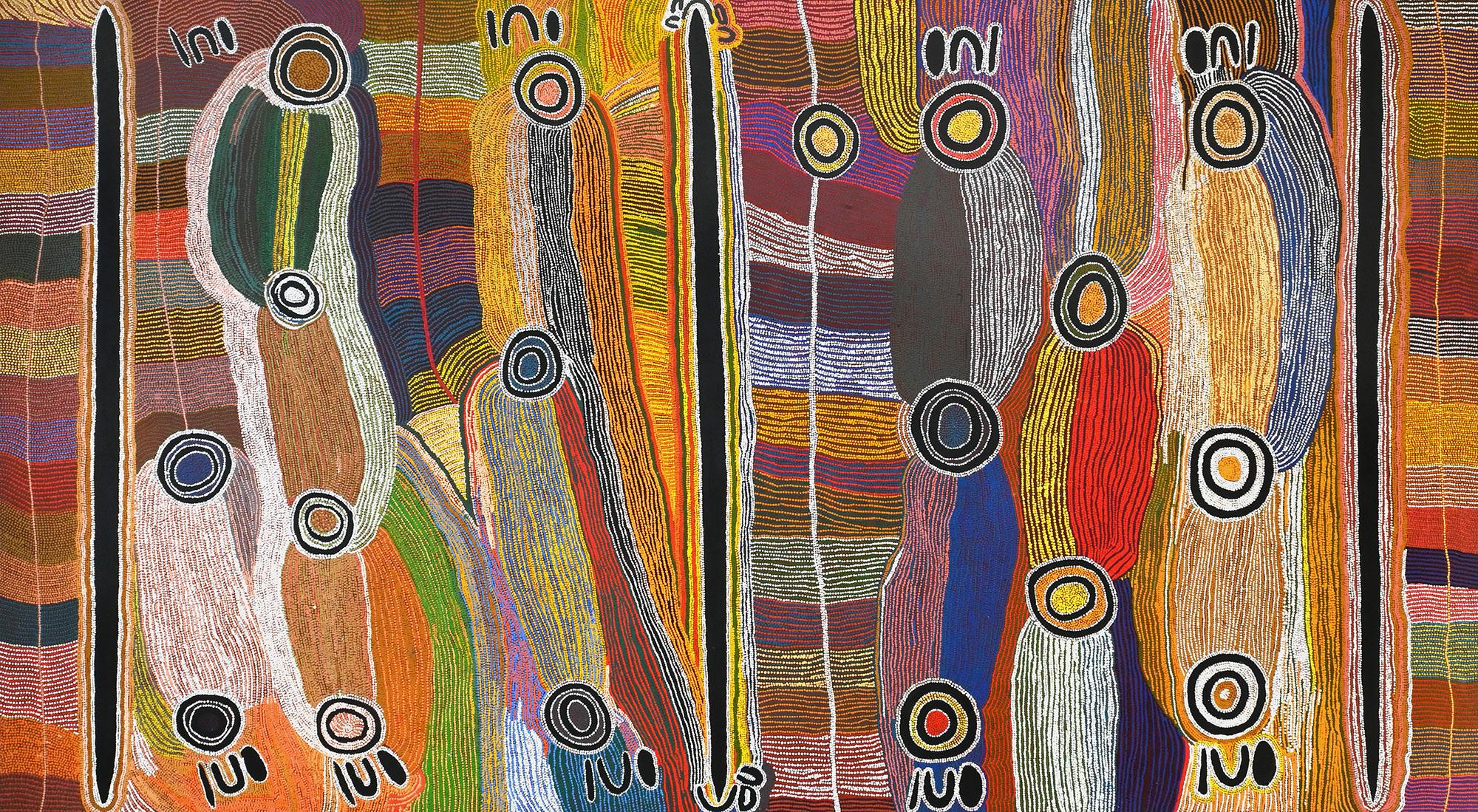

PROUDLY SPONSORED BY MUNDA WINES
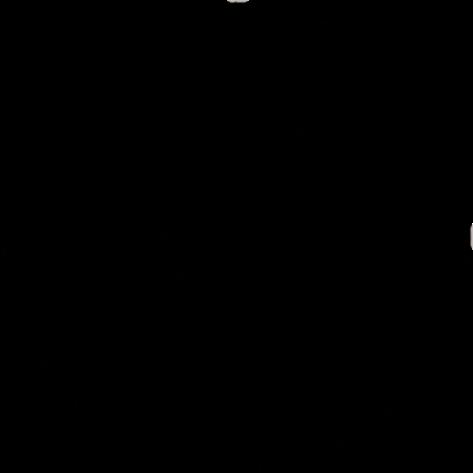
Ancient soils, ancient culture.
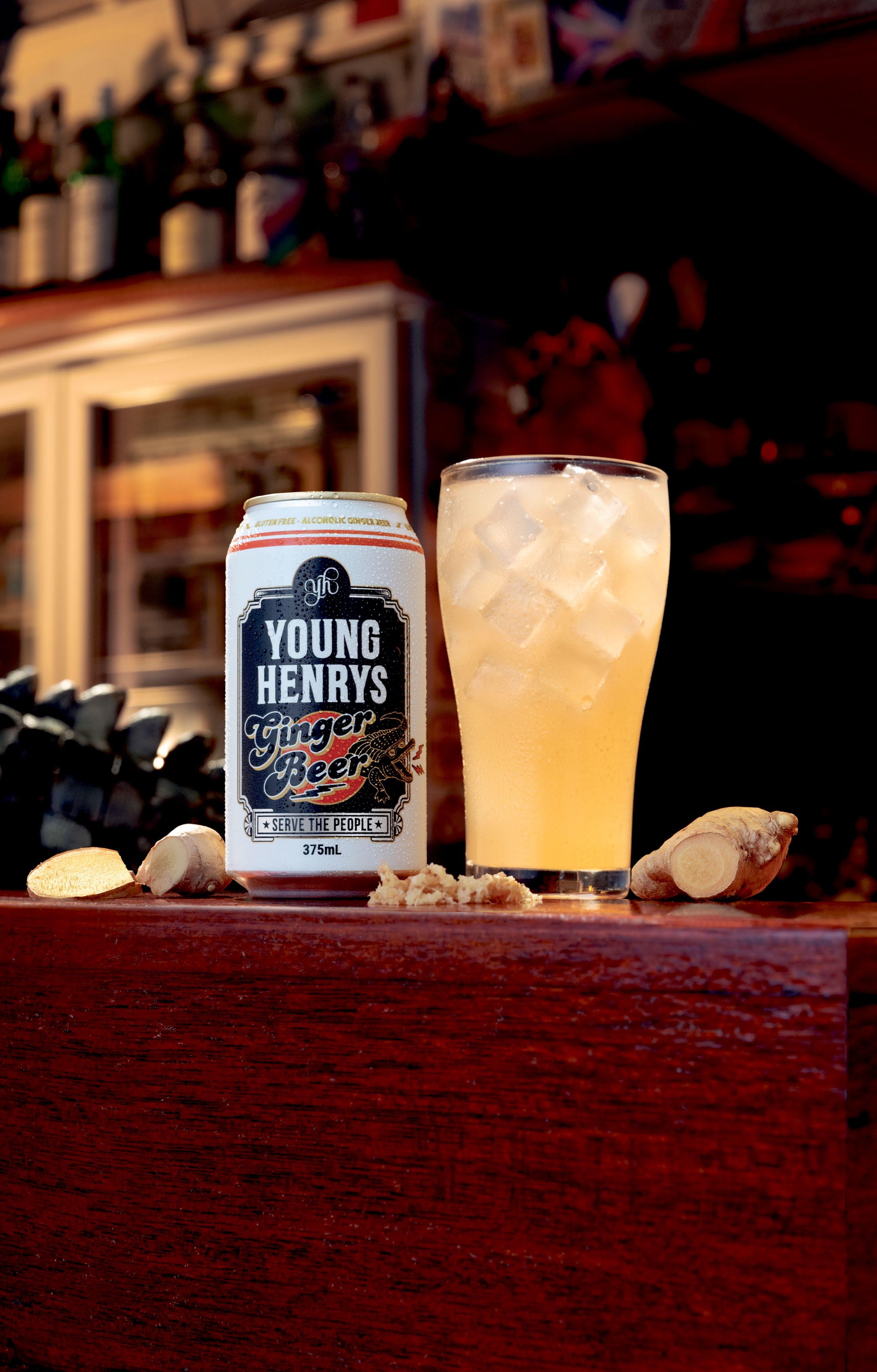
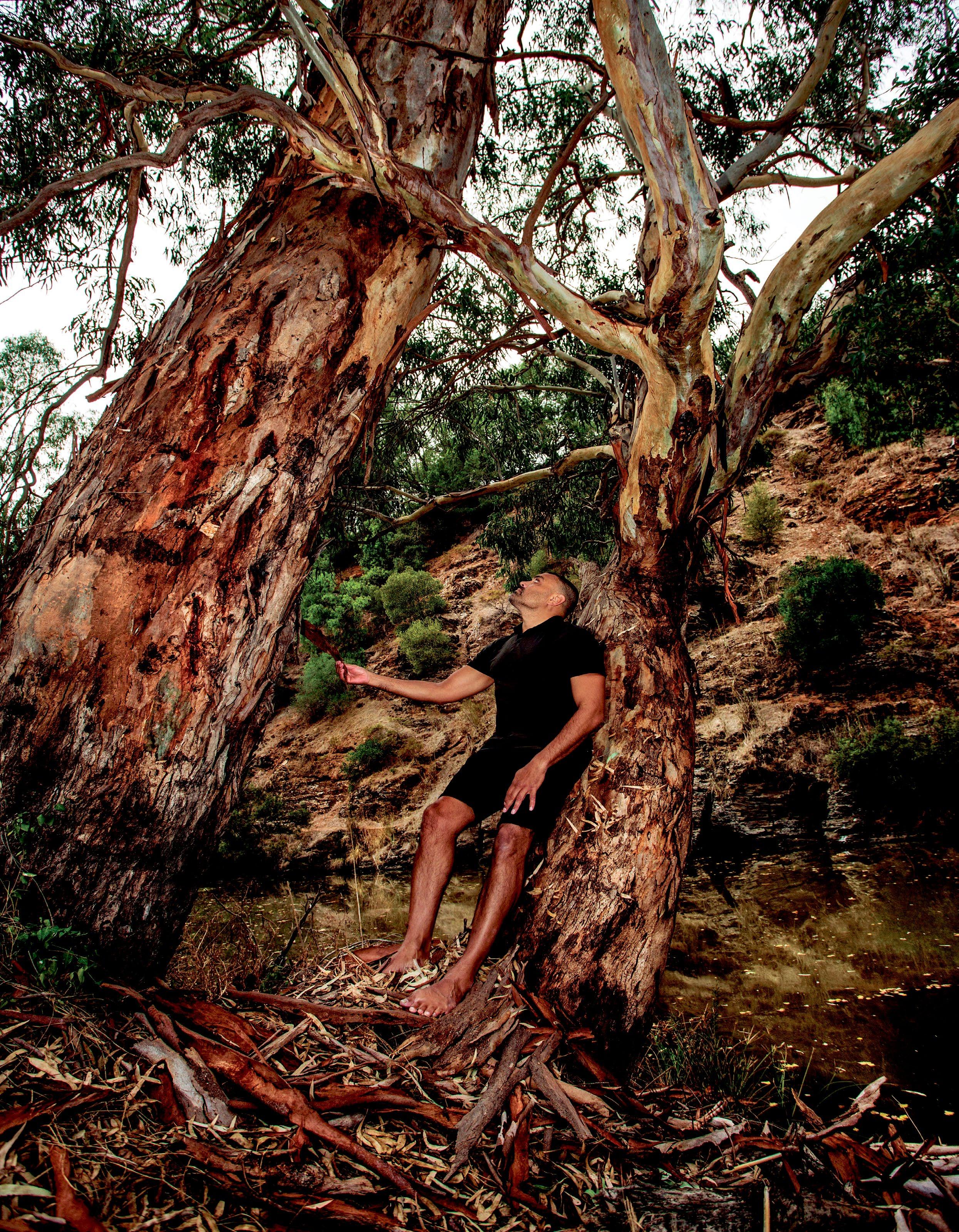

The price range listed against each lot reflects the opinion of the art specialists as to what they expect the hammer price each artwork may achieve and is informed by realised prices for comparable artworks in the secondary market. These estimates are intended as a guide only and may sell outside of these ranges. Pre-sale estimates do not include buyer’s premium or other charges where applicable.
The reserve is the minimum price that the vendor will accept for each lot and the lot can not be normally sold lower than this amount. This information is not provided to prospective buyers.
Prospective buyers must register to bid prior to the auction.
There are five ways to bid at a Cooee Art auctions
In person – Our auctions are open to the public and held at our premises at 17 Thurlow Street, Redfern. We welcome your attendance if you are in Sydney.
Online – Whether you are just a suburb away or halfway around the world you can bid for all Cooee Art lots in the comfort of your home or office, live and in real-time on our dedicated auction website at auction.cooeeart.com.au or on Invaluable.
Each artwork will be listed with the known provenance or history of ownership. Non disclosure may indicate that the prior history and provenance was unknown to Cooee Art. All artworks sold through the Cooee Art auctions come with a certificate of authenticity from our auction house. We do endeavour to track down the original certificates from the sellers of the artworks prior to the sale, however, these are sometimes misplaced and are no longer available.
Absentee – For those who prefer not to attend the auction in person or bid online, you can leave an Absentee bid with us by filling in the form found at the back of this catalogue, or whilst at the viewing in our Showroom. By leaving your maximum bid on any lot, the Auctioneer will bid on your behalf up to, but not above, this amount. If the other bidder(s) drop out before your highest bid, you will win the work for the next bidding increment, which may be less than your maximum bid.
For the full terms and conditions, please visit www.cooeeart.com.au/buy-and-sell/buying-from-a-cooeeart-auction/
Absentee on the website - Here you can leave a bid online for any lot right up until the auction starts at 7pm.You will be notified if someone outbids you before the auction. If you are outbid by someone in the room or on the phones during the auction, you will miss out. A good strategy is to leave the highest bid you are willing to buy the artwork for and the computer will keep bidding on your behalf up to that amount.Your maximum amount is confidential, so you may win the lot for a much lower amount.
The copyright of the artworks listed in this catalogue belong to the artist or their estate and used under licence by Cooee Art. The buyer must not reproduce or otherwise use the images or text without prior written consent. Cooee Art has paid the cost of copyright via the Copyright Agency, 2022.
Telephone - By using this option, you can bid on any lot from the comfort of your home, anywhere in the world. You will be called 2 - 3 lots before your selected lot comes up and one of our staff will act on your behalf, being your eyes, ears, and spokesperson for the evening. It is also advisable to leave a Cover Bid (which acts the same way as an Absentee Bid) so that if we are unable to reach you on the night, the person calling can then step in and bid for you up to your Cover Bid amount.
Some lots consigned for this auction may be subject to the Resale Royalty for Visual Artists Act 2009. Any payments due under the obligations of the Act will be paid by the vendor.
Bidding typically opens below the listed pre-sale estimate and proceeds in the following increments (however it is at the discretion of the auctioneer, and may vary)
Between and Increments of $0 $1,000 by $50
$1,000 $2,000 by $100
$2,000 $5,000 by $200
$5,000 $10,000 by $500
$10,000 $20,000 by $1000
$20,000 $50,000 by $2,000
$50,000 $100,000 by $5,000
$100,000 $200,000 by $10,000
$200,000 $500,000 by $20,000
$500,000 $1,000,000 by $50,000
$1,000,000 and over by $100,000
A buyer’s premium of 25% (including GST) is added to the hammer price of each lot. The hammer price is the last bid that is accepted by the auctioneer.
The fall of the auctioneer’s hammer indicates the bid has been accepted and the work is sold, the buyer assumes full responsibility for the lot from this time.
The day after the sale, the Post-Sale team will send you an Invoice. The final amount due will include the hammer price, the 25% buyer’s premium, and the service fee charged by Invaluable if you are using their services. Electronic Bank Transfer is the simplest payment method and your invoice will include our bank details. A 2% surcharge applies to Visa, MasterCard, and AMEX payments. Alternatively, payment may be made by cheque, cash or eftpos. Please note: payments made by cheque are subject to a 5-day clearance before goods can be collected.
If buyer is an Australian resident, a 10% GST is included in the following instances
a.In the final hammer price when buying from a GST registered vendor
b. When additional fees are required i.e. shipping
c. Buyers Premium
All collection notifications, shipping options, and requests for carrier recommendations are to be emailed to our Auction Administration email address auction@cooeeart. com.au. Cooee Art will endeavour to supply you with the best and most cost effective option for shipping your artwork to you, but you are not obliged to use this service and may organise your own transport options. Please inform us as soon as possible of your preferred method. Proof of identification is required upon collection. Lots not collected within 7 days of the sale may incur costs associated with external storage and freight. Should you request that Cooee Art wrap and/or pack your goods and arrange postage of your items for you, a fee will apply, and whilst all care is taken, we accept no responsibility for any damage.
(Mr/Mrs/Ms/Miss) Name (please print)
Business name
Address City State Postcode
Telephone/Mobile Email
Indigenous Fine Art Auction Catalogue (single issue) $35*
*price includes G.S.T. postage and handling. Additional $10 per catalogue for international orders
(Mr/Mrs/Ms/Miss) Name (please print)
Business name
Address City State Postcode
Telephone/Mobile Email
Subscription payment by: Visa AMEX Mastercard
Name on card
Card number Expiry date
Signature Date
SALE NO.: 13
THE ROD MENZIES ESTATE | INDIGENOUS AND OCEANIC ART COLLECTION | PART I
8 NOVEMBER 2023, 7:00PM AEST LOTS 1 - 96
17 THURLOW STREET REDFERN NSW 2016
please email or post this completed form to:
COOEE ART
17 THURLOW STREET REDFERN NSW 2016
tel: +61 (02) 9300 9533
auction@cooeeart.com.au
Tax invoice required
please email or post this completed form to:
COOEE ART
17 THURLOW STREET REDFERN NSW 2016
tel: +61 (02) 9300 9533
auction@cooeeart.com.au
(Mr/Mrs/Ms/Miss) Name (please print)
Billing adress (PO Box insufficient)
Address City State Postcode
Telephone numbers for auction in order of preference
Country
SALE NO.: 13
THE ROD MENZIES ESTATE | INDIGENOUS AND OCEANIC ART COLLECTION | PART I
8 NOVEMBER 2023, 7:00PM AEST LOTS 1 - 96
17 THURLOW STREET REDFERN NSW 2016
please email or post this completed form to:
COOEE ART
17 THURLOW STREET REDFERN NSW 2016
tel: +61 (02) 9300 9533
auction@cooeeart.com.au
*Not including buyer’s premium or GST (where applicable). bids are made in Australian dollars. Telephone bids must be received a minimum of twenty-four hours prior to auction. All telephone bids received will be confirmed by phone or email. In the event that confirmation is not received, please resubmit or contact our office. Please refer to the Buyers Terms & Conditions of Auction found at www.cooeeart.com.au/buying-from-acooee-art-auctions for information regarding sales.
By completing this form, I authorise COOEE ART to contact me by telephone on the contact number(s) nominated. I understand it is my responsibility to enquire whether any Sale-Room Notices relate to any lot on which I intend to bid. I also understand that should my bid(s) be successful, a buyer’s premium of 25% (inclusive of GST), will be added to the final hammer price.
I accept that COOEE ART provides this complimentary service as a courtesy to its clients, that there are inherent risks to telephone bidding, and I will not hold COOEE ART responsible for any error. A member of the Cooee Art team will contact you a few minutes before your indicated desired lots.The Cover Bid Price will be used should a member of staff not be able to reach you. Should your final bid be successful, you will be obliged to pay the final bid price plus buyer’s premium of 25% (incl of GST) of the final bid amount.
RECEIVED BY
DATE
TIME
BIDDER NO.
(Mr/Mrs/Ms/Miss) Name (please print)
Billing adress (PO Box insufficient)
Telephone/Mobile
Country
SALE NO.: 13
THE ROD MENZIES ESTATE | INDIGENOUS AND OCEANIC ART COLLECTION | PART I
8 NOVEMBER 2023, 7:00PM AEST
LOTS 1 - 96
17 THURLOW STREET REDFERN NSW 2016
please email or post this completed form to:
COOEE ART
17 THURLOW STREET REDFERN NSW 2016
tel: +61 (02) 9300 9533
auction@cooeeart.com.au
*Not including buyer’s premium or GST (where applicable). bids are made in Australian dollars. Absentee bids must be received by 2pm the pay of the auction. All absentee bids received will be confirmed by phone or email. In the event that confirmation is not received, please resubmit or contact our office.
Please refer to the Buyers Terms & Conditions of Auction found at www.cooeeart.com.au/buying-from-acooee-art-auctions for information regarding sales.
By completing this form, absentee bidders request and authorise COOEE ART to place the following bids acting as agent on their behalf up to and including the maximum bid specified. Lots will be bought at the lowest possible bid authorised by the bidder in absentia.
I understand it is my responsibility to enquire whether any Sale-Room Notices relate to any lot on which I intend to bid. I also understand that should my bid(s) be successful, a buyer’s premium of 25% (inclusive of GST), will be added to the final hammer price.
COOEE ART provides this complimentary service as a courtesy to clients and does not accept liability for errors and omissions in the execution of absentee bids. Should your bid be successful, you will be obliged to pay the final bid price plus buyer’s premium of 25% (incl of GST) of the final bid price.
INTERNAL USE ONLY
RECEIVED BY
DATE TIME
BIDDER NO.
1 © Robert Campbell Junior / Copyright Agency, 2023
2 © Walangkura Napanangka / Copyright Agency, 2023
3 © Nyurapayia (Mrs Bennett) Nampitjinpa / Copyright Agency, 2023
4 © Boxer Milner /Copyright Agency, 2023
5 © Nyurapaiya (Mrs Bennett) Nampitjinpa / Copyright Agency, 2023
6 © Kathleen Ngal / Copyright Agency, 2023
42 © Turkey Tolson Tjupurrula / Copyright Agency, 2023
43 © Rover Joolama Thomas / Copyright Agency, 2023
44 © Rover Thomas (Joolama); Queenie McKenzie Nakarra & Churchill Cann (Yoonany) / Copyright Agency, 2023
45 © Ronnie Tjampitjinpa / Copyright Agency, 2023
46 © Turkey Tolson Tjupurrula / Copyright Agency, 2023
47 © Emily Kame Kngwarreye / Copyright Agency, 2023
48 © Clifford Possum Tjapaltjarri / Copyright Agency, 2023
49 © Biddee Baadjo, Janie Lee, Milkujung Jewess James, Penny K Lyons & Willie Kew / Copyright Agency, 2023
50 © Jimmy Donegan / Copyright Agency, 2023
69 © Johnny Warangkula Tjupurrula / Copyright Agency, 2023
70 © Dr George Tjapaltjarri / Copyright Agency, 2023
2023
71 © Mick Gill Tjakamarra / Copyright Agency, 2023
72 © Walangkura Napanangka / Copyright Agency, 2023
73 © Estelle Inyika Hogan / Copyright Agency, 2023
76 © Kudditji Kngwarreye / Copyright Agency, 2023
78 © Yannima Tommy Watson / Copyright Agency, 2023
79 © Judy Napangardi Watson / Copyright Agency, 2023
80 © Julie Dowling / Copyright Agency, 2023
81 © Long Tom Tjapanangka / Copyright Agency, 2023
82 © Ronnie Tjampitjinpa / Copyright Agency, 2023
83 © Mick Namarari Tjapaltjarri / Copyright Agency, 2023
84 © Mick Namarari Tjapaltjarri / Copyright Agency, 2023
85 © Clifford Possum Tjapaltjarri / Copyright Agency, 2023
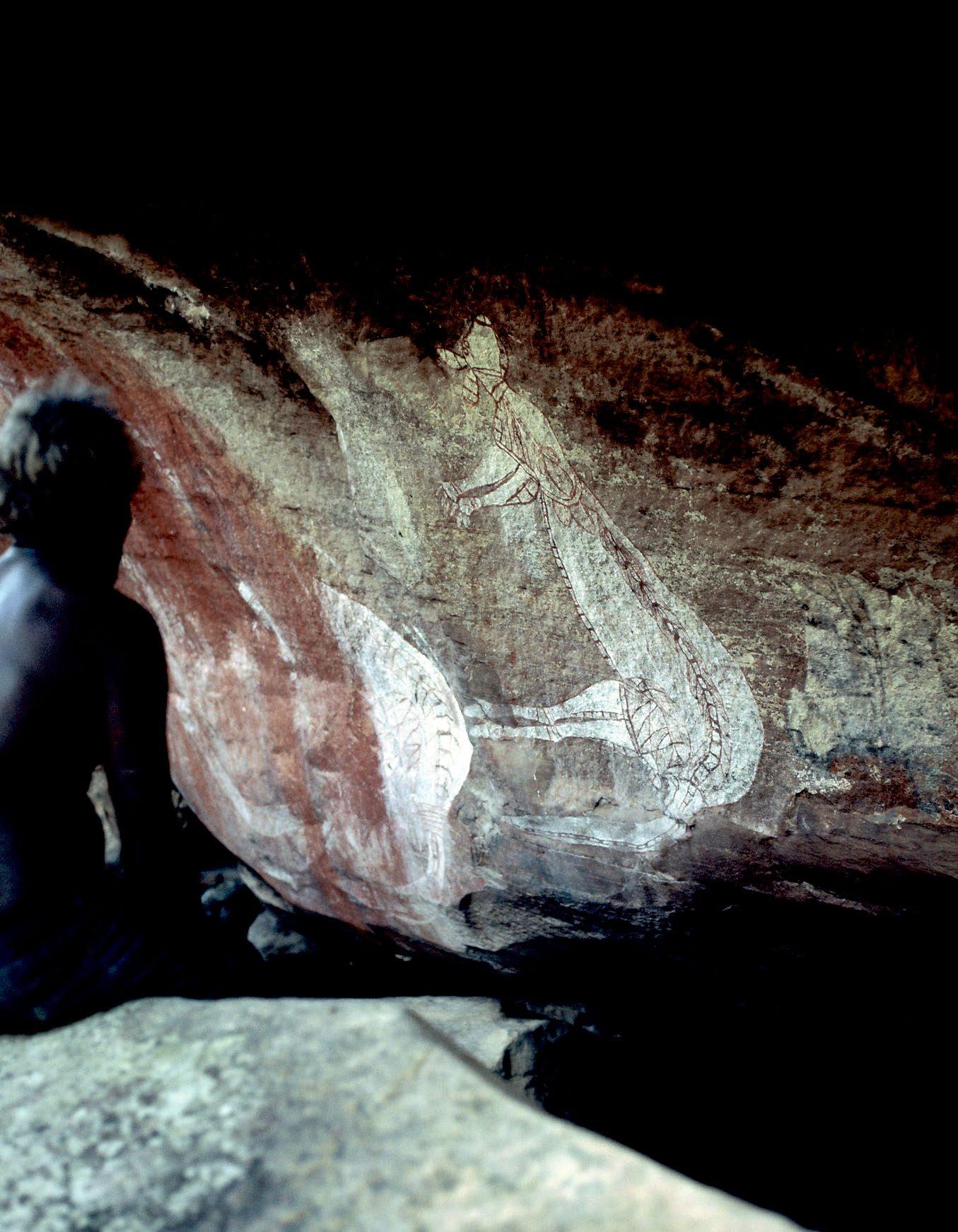
86 © Ronnie Tjampitjinpa / Copyright Agency, 2023
87 © Turkey Tolson Tjupurrula / Copyright Agency, 2023
88 © Alice Nampitjimpa / Copyright Agency, 2023
89 © Greeny Purvis Petyarre / Copyright Agency, 2023
90 © Minnie Pwerle / Copyright Agency, 2023
91 © Regina Wilson / Copyright Agency, 2023
93 © Timothy Cook / Copyright Agency, 2023
94 © Freda Warlimpini / Copyright Agency, 2023
96 © Brook Andrew / Copyright Agency, 2023
97 © Nyuju Stumpy Brown / Copyright Agency, 2023
